Biology:Glossary of botanical terms
Template:Use shortened footnotes
This glossary of botanical terms is a list of definitions of terms and concepts relevant to botany and plants in general. Terms of plant morphology are included here as well as at the more specific Glossary of plant morphology and Glossary of leaf morphology. For other related terms, see Glossary of phytopathology, Glossary of lichen terms, and List of Latin and Greek words commonly used in systematic names.
A
- ab-
- Prefix meaning "position away from".[1]
- abaxial
- Surface of an organ facing away from the organ's axis, e.g. the lower surface of a lateral organ such as a leaf or petal.[2] Contrast adaxial.
- abort
- To abandon development of a structure or organ.[3]
- abscission
- Natural shedding of an organ that is mature or aged, as of a ripe fruit or an old leaf.[4]
- abscission zone
- Specialized layer of tissue that allows an organ to be shed by abscission when it is ripe or senescent. Such tissue is commonly formed, for example, at the base of a petiole or pedicel.
- acaulescent
- Having no apparent stem, or at least none visible above the ground surface.[2] Examples include some species of Oxalis,[5] Nolina,[6] and Yucca.[7] Antonym: caulescent (possessing stem).
- accrescent
- Increasing in size with age, such as a calyx that continues to grow after the corolla has fallen,[2] e.g. in Physalis peruviana.
- accumbent
- Lying against another part of the plant; when applied to a cotyledon, it means that an edge of the cotyledon lies along the folded radicle in the seed.[8]
- -aceae
- Suffix added to the word stem of a generic name to form the name of a taxonomic family;[9] for example, Rosaceae is the rose family, of which the type genus is Rosa.[10]
- achene
- Dry, one-seeded indehiscent fruit[11] in which the true fruit is not the so-called "berry", but the achenes, which are the so-called "seeds" on the infructescence, e.g. in the genus Fragaria.
- acicular
- Slender or needle-shaped.[11] See also Leaf shape.
- acropetal
- Moving from roots to leaves, e.g. of molecular signals in plants.
- acrophyll
- Regular leaves of a mature plant, produced above the base, as opposed to bathyphyll.
- acrostichoid
- (describing a type of sorus) Covering the entire abaxial surface of a frond, usually densely so, as in Elaphoglossum and Acrostichum.
- actino-
- Prefix that indicates a radial pattern, form, or morphology.
- actinodromous
- (of leaf venation) Palmate or radially arranged venation with three or more primary veins arising at or near the base of the leaf and reaching the margin in most species, but not all.
- actinomorphic
- Regular or radially symmetrical;[12] may be bisected into similar halves in at least two planes. Applies e.g. to steles and flowers in which the perianth segments within each whorl are alike in size and shape. Compare regular. Contrast asymmetrical, irregular, and zygomorphic.
- aculeate
- Armed with prickles,[13] e.g. the stem of a rose.
- acumen
- A long, tapering point, especially the apex of an acuminate leaf.
- acuminate
- Tapering gradually to a point, with concave sides approaching the point.[13] Contrast acute and mucronate. See also Leaf shape.
- acute
- 1. Sharply pointed, but not drawn out, with straight sides approaching the point.[13] Contrast acuminate. See also Leaf shape.
- 2. Converging at an angle of less than 90°. Contrast obtuse.
- ad-
- Prefix meaning "near or toward"; also meaning "added to".[13]
- adaxial
- Surface of an organ facing toward the organ's axis,[13] e.g. the upper surface of a lateral organ such as a leaf or petal. Contrast abaxial.
- adelphia
A bundle or structure of stamens forming one unit in an adelphous flower; for example, the stamen tube around the pistil of Hibiscus.
- adelphous
- Having organs, particularly filaments such as stamens, connected into one or more adelphiae, whether in the form of bunches or tubes, such as is commonly seen in families such as Malvaceae. Usage of the term is not consistent; some authors include closely bunched filaments, while others include only adelphiae in which filaments are connected minimally at their bases. See, for example, Sims: "...the filaments are so closely pressed that they have the appearance of being monadelphous...".[14] Compare derived terms such as monadelphous, having stamens growing in a single bunch or tube, for example in Hibiscus, and diadelphous, growing in two bunches.
- adherent
- Slightly united to an organ of another kind,[13] usually to a part of another whorl, e.g. a sepal connected to a petal. Contrast adnate.
- adnate
- Grown from or closely fused to an organ of a different kind,[13] especially along a margin, e.g. a stamen fused to a petal. Adnate anthers have their halves attached to the filament through most of their length. Contrast connate.
- adventitious
- Produced in an unpredictable or unusual position,[13] e.g. an adventitious bud produced from a stem rather than from the more typical axil of a leaf. Adventitious roots may develop from nodes of prostrate stems of some plant species, or from the hypocotyl rather than from the radicle of a germinating monocotyledon.
- adventive
- Introduced accidentally[13] (usually referring to a weed).
- aerial
- Of the air; growing or borne above the surface of the ground or water.[15]
- aestivation
- Arrangement of sepals and petals or their lobes in an unexpanded flower bud. Contrast vernation.
- aff. (affinis)
- With affinity to others, akin to; often used for a provisionally recognized but unnamed taxon considered close to that name, perhaps a hybrid or extreme variant.
- aggregate fruit
- Cluster of fruits formed from the free carpels of a single flower, e.g. a blackberry. Compare multiple fruit.
- agochoric
- Plants that are spread through accidental transport.
- agricultural weed
- See weed.
- agriophyte
- Plant species that have invaded native vegetation and could survive there without human intervention. They are established there in natural habitats, remaining part of natural vegetation even after human influence has ceased, and are independent of humans in their continued existence.[16]
- agrophic
- Comb-like series of veins forking from a single side of a primary or secondary vein.
- agrostology
- The scientific study of grasses, in the strictest sense only those species which are members of the family Poaceae. Broader usages sometimes also include grass-like or graminoid species from the families Cyperaceae, Juncaceae, and Typhaceae.
- alate
- Having a wing or wings.
- albumen
- Older name for the endosperm of flowering plants. Except for being a storage tissue for nutrients, it is not like the albumen (egg white) of animal embryos.
- albuminous
- (of seeds) Containing endosperm.
- -ales
- Suffix added to the stem of a generic name or descriptive name to form the name of a taxonomic order.
- alien
- Any plant introduced to an area outside its natural range. Often used interchangeably or in combination with foreign, exotic, non-native, and non-indigenous.
- alkaloid
- Any of a loosely defined class of organic compounds found in the tissues of many species of plants. Alkaloid molecules have one or more alkaline-reacting nitrogen atoms in their carbon structures. Many alkaloids are commercially important as drugs or poisons, e.g. caffeine, morphine, quinine, and strychnine, each of which occurs naturally in certain plants.
- allelopathy
- The secretion by a plant of biochemicals which influence the growth and reproduction of nearby plants.
- allopatric
- Having geographically separate, non-overlapping ranges of distribution.[17] Contrast sympatric.
- alternate
- 1. (adj.) (of leaves or flowers) Borne singly at different levels along a stem, including spiralled parts. Contrast opposite.
- 2. (prep.) Occurring between something else, e.g. stamens alternating with petals.
- alternipetalous
- A configuration where parts of the flower, e.g. stamens, alternate in position with the petals.[18]
- ament
- A synonym of catkin.
- amphitropous
- (of an ovule) Bent so that both ends are near each other. Contrast anatropous, campylotropous, and orthotropous.
- amplexicaul
- With the base dilated and clasping the stem, usually of leaves.
- amylum star
- a vegetative propagative body filled with starch (amylum) and located around the lower nodes of certain stoneworts.
- anastomose
- Branching and then rejoining, as with leaf venation.
- anastomosis
- A connection or fusion of two or more veins that are normally diverging or branching, thereby forming a network.
- anatropous
- (of an ovule) Inverted so that the micropyle faces the placenta (this is the most common ovule orientation in flowering plants). Contrast amphitropous, campylotropous, and orthotropous.
- ancipital
- Flat, with two edges (versus round).[19]
- androdioecious
- Having bisexual flowers and male flowers on separate individuals. Contrast andromonoecious, polygamodioecious, polygamomonoecious, and polygamous.
- androecium
- A collective name for the male reproductive parts of a flower; the stamens of a flower considered collectively. Contrast gynoecium. Abbreviated A; e.g. A 3+3 indicates six stamens in two whorls.
- androgynophore
- A stalk bearing both the androecium and gynoecium of a flower above the level of insertion of the perianth.
- androgynous
- Having male and female flowers in the same inflorescence.
- androphore
- The stalk or column supporting the stamens in certain flowers.
- andromonoecious
- Having bisexual flowers and male flowers on the same individual plant. Contrast androdioecious, gynomonoecious, polygamodioecious, polygamomonoecious, and polygamous.
- anemophilous
- Adapted to pollination by wind.
- anemophily
- Adaptation to pollination by wind.
- angiosperm
- A flowering plant; a plant with developing seeds enclosed in an ovary.
- anisomery
- The condition of having a floral whorl with a different (usually smaller) number of parts from the other floral whorls.
- anisotomic
- Branching, with branches having unequal diameters, such as a trunk and its branch. Contrast isotomic.
- annual
- A plant that completes its life cycle (i.e. germinates, reproduces, and dies) within a single year or growing season.
- annulus
- 1. A ring-like structure; in the form of a ring. Pappus bristles are sometimes attached to a ring called an annulus or disk at the top of the achene beak. In some pollen grains, the exine around the apertures is either thicker or thinner. In pores, this border is termed an annulus. Certain flowers have ring-like constrictions at the mouth of the flower, e.g. in Huernia and Aristolochia.
- 2. A ring of specialized cells on the sporangium.
- anterior
- Positioned in front of, toward the apex. Compare distal.
- anthemoid
- In the Compositae, a style with a brush-like tuft of sweeping hairs at the tip of each style branch.
- anther
- The pollen-bearing part of a stamen.
- antheridium
- in bryophytes, a specialized gametophytic organ that produces the male gametes.
- antheridiophore
- In liverworts of the order Marchantiales, a male gametophore, a specialized, stalked structure that bears the antheridia.
- antherode
- A sterile anther of a staminode.
- anthesis
- 1. (of a flower) The period during which pollen is presented and/or the stigma is receptive.
- 2. (of a flowering plant) The period during which flowers in anthesis are present. Not defined for some cases, such as when pollen is released in the bud.
- anthocarp
- A type of fruit in which some part of the flower persists attached to the pericarp, e.g. in Nyctaginaceae.
- anthophore
- A stalk-like structure, internode located between the calyx and the other parts of the flower.
- anticlinal
- Pointing up, away from, or perpendicular to a surface. Contrast periclinal.
- antrorse
- Directed forward or upward, e.g. of hairs on a stem. Contrast retrorse.
- apetalous
- Lacking petals.
- apex
The tip; the point furthest from the point of attachment.
- aphananthous
- (of flowers) Inconspicuous or unshowy, as opposed to phaneranthous or showy.
- aphlebia
Imperfect or irregular leaf endings commonly found on ferns and fossils of ferns from the Carboniferous Period.
- aphyllous
- Leafless; having no leaves.[20]
- apical
- At or on the apex of a structure, usually a shoot, a stem, or the trunk of a tree, e.g. an apical meristem or an apical bud.
- apiculate
- especially of leaves, ending in a short triangular point. See also Leaf shape.
- apiphily
- A form of pollination whereby pollen is distributed by honey bees.
- apo-
- A prefix meaning "away from, separate, without".
- apocarpous
- (of a gynoecium) Consisting of one or more carpels which are free from one another (or almost so), e.g. in members of the Ranunculaceae and Dilleniaceae.
- apomixis
A type of asexual reproduction whereby viable seeds or spores are produced asexually, without fertilization, such that the genetic material they contain is a clone of the parent's genetic material. A plant produced in this way is called an apomict.
- apomorphy
- In cladistics, a "different form" from the form of an ancestor (i.e., an innovation) of use in determining membership in a clade.
- apopetalous
- Having separate petals, not fused (sympetalous).
- apophyllous
- Perianth or other segments free, not united. Compare symphyllous, gamophyllous, and polyphyllous.
- apophysis
- 1. The external part of a cone scale.
- 2. An outgrowth of an organ or an enlargement of a stem.
- appendage
- A secondary part attached to a main structure; an external growth that seldom has any obvious function, hence appendiculate.
- appendiculate
- Having the nature of or bearing appendages.
- appressed
- Pressed closely but not fused, e.g. leaves against a stem.
- aquatic plant
- A plant whose natural habitat is water, living in or on water for all or a substantial part of its lifespan; generally restricted to fresh or inland waters.
- arachnoid
- Cobwebby, from being covered with fine white hairs.
- arborescent
- Tree-like in growth or general appearance.
- arboretum
A taxonomically arranged collection of trees.
- archaeophyte
- A non-native plant that has nonetheless been present in a particular geographic area for some time. Contrast neophyte.
- archegonium
- A multicellular haploid structure or organ of the gametophyte phase of certain plants, producing and containing the ovum or female gamete. The corresponding male organ is called the antheridium.
- archegoniophore
- In liverworts of the order Marchantiales, a female gametophore: a specialized, stalked structure that bears the archegonia and the sporophytes.
- arctotoid
- In the Compositae, a style with a ring of sweeping hairs borne on the shaft of the style proximal to the style branches.
- areolate
- Having or being composed of areoles, as an areolate crustose lichen.
- areole
- 1. A space between the threads of a net, e.g. that part of a leaf surface defined by each of the elements of a vein network; as with cacti, the area between the veinlets of a leaf.
- 2. A structure on the stem node of a cactus, morphologically a specialised branch; the region of a cactus upon which spines, glochids, and flowers are borne.
- aril
- A membranous or fleshy appendage formed by expansion of the funicle which partly or wholly covers a seed, e.g. the fleshy outer layer of lychee fruit, or that found in members of the Sapindaceae.
- aristate
- With a stiff, bristle-like awn or tip. See also Leaf shape.
- article
- A segment of a jointed stem or of a fruit with constrictions between the seeds; an organ part that separates easily from the rest of the organ at a joint or articulation.
- articulate
- Jointed; separating freely, leaving a clean scar; e.g. the fronds of certain ferns where they join the rhizome.
- ascending
- 1. (of a stem) Spreading horizontally, then directed upward; an ascending stem is more or less prostrate near its base, then erect.
- 2. (of an ovule) Attached somewhat above the base.
- ascidiate
- Shaped like a pitcher, as with the leaves of pitcher plants, e.g. species of Nepenthes and Sarracenia.[21]
- asexual reproduction
- Reproduction that does not involve gametes. Often used interchangeably with vegetative reproduction.
- asperulous
- Having a rough, sandpapery texture; e.g. some leaf surfaces.
- asymmetrical
- Irregular or unequal; lacking any plane of symmetry; e.g. flowers of Canna.
- attenuate
- Narrowing gradually. See also Leaf shape.
- auricle
- An ear-shaped lobe, particularly a small, roundish, lateral appendage of a leaf or leaf-like organ.
- auriculate
- Attached at the base with ear-shaped appendages (auricles). See also Leaf shape.
- autogamous
- Self-pollinating, self-fertilizing – in flowering plants
- awn
- 1. Any long, bristle-like appendage.
- 2. In the Poaceae, an appendage terminating or on the back of glumes or lemmas of some grass spikelets.
- 3. In the Geraniaceae, the part of the style that remains attached to the carpel that separates from the carpophore (column).
- 4. A generally straight, stiff pappus element, varying from stiffly bristle-like to hard and needle-like. In Strophanthus, the awn is the beak of the seed, stipe of the coma hairs.
- axil
- The upper angle between one part of a plant and another, e.g. the stem and a leaf.
- axile
- On an axis; of a placenta, on the central axis of the ovary.
- axillary
- Borne in or arising from the axil, usually referring to the axil of a leaf.
- axis
- The main stem of a whole plant or inflorescence; also, the line along which this stem extends.
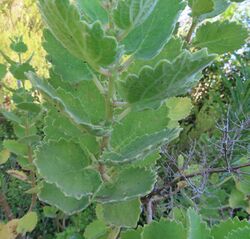
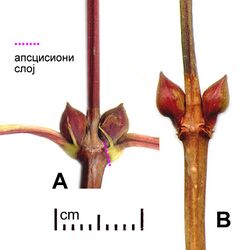
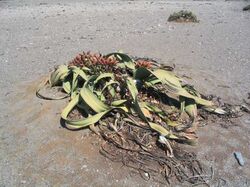
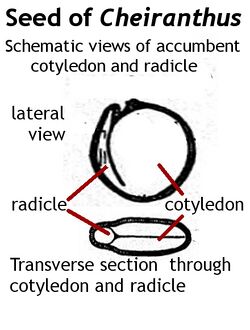
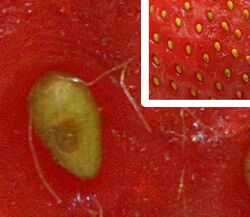
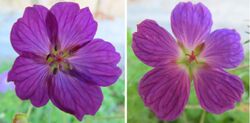
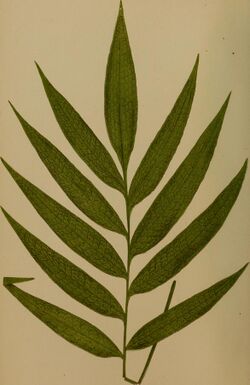
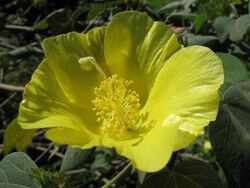
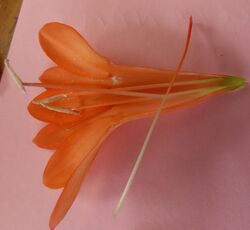
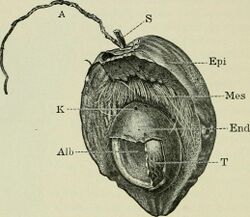
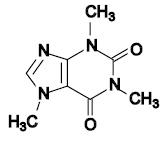
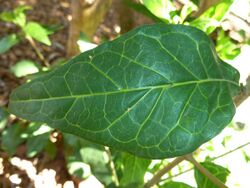
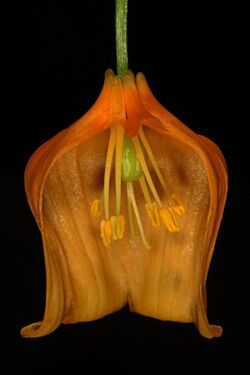
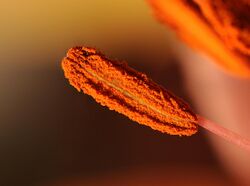
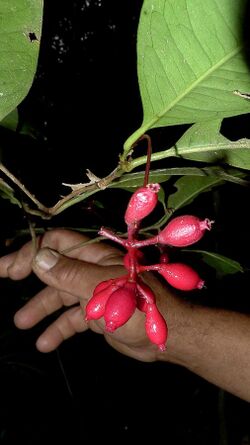
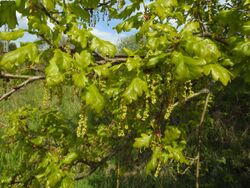
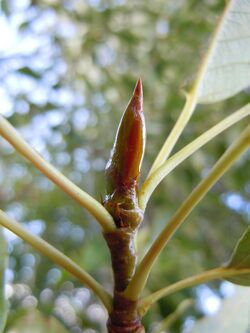
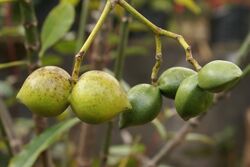
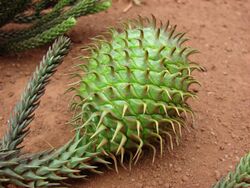
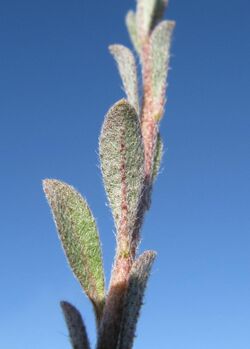
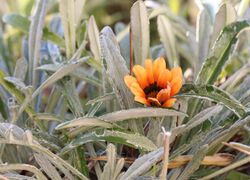
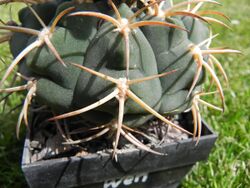
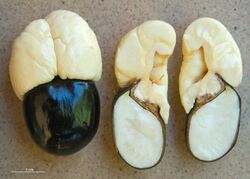
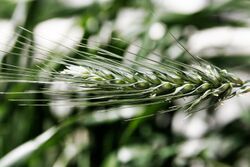
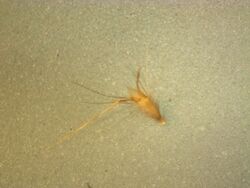
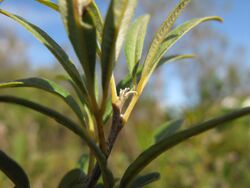
B
- baccate
- Fruit appearing like a berry that may or may not be a true berry.[22]
- baculiform
- Rod-like; longer than wide. Compare cylindrical.
- barb
- A rear-facing point, as in a fish hook.
- barbed
- Having barbs pointing in one direction.
- barbellate
- Having barbed hairs (barbellae).
- bark
- The protective external layer of tissue on the stems and roots of woody trees and shrubs; includes all of the living and non-living tissue external to the cambium.
- basal
- Situated or attached at or close to the base (of a plant or a phylogenetic tree diagram).
- basifixed
- Something attached by its base, e.g. an anther attached to the filament. Compare dorsifixed.
- basipetal
- Developing sequentially from the apex toward the base (i.e. with the youngest toward the base), e.g. of flowers in an inflorescence. Also, moving from leaves to roots, e.g. of molecular signals in plants.
- bathyphyll
- A specialized leaf produced at the base of a plant, usually when the plant is immature, and which serves to anchor the plant to a substrate; especially notable in the fern Teratophyllum. Contrast acrophyll.
- beak
- A prominent, pointed terminal projection, especially of a carpel or fruit.
- berry
- A type of indehiscent fruit with the seeds immersed in the pulp, e.g. a tomato.
- bi-
- A prefix meaning "two", e.g. bisulcate, having two sulci or grooves.
- biennial
- A plant which completes its life cycle (i.e. germinates, reproduces, and dies) within two years or growing seasons. Biennial plants usually form a basal rosette of leaves in the first year and then flower and fruit in the second year.
- bifid
- Forked; cut in two for about half its length. Compare trifid.
- bifoliate
- (of a compound leaf) Having precisely two leaflets, usually in a symmetrical pair, e.g. a leaf of Colophospermum mopane. Compare jugate lobed leaf, e.g. most species of Bauhinia.
- bifusiform
- Fusiform with a pinch in the middle.
- bilabiate
- Having two lips, e.g. the form of the petals in many irregular flowers.
- bilateral
- 1. Having two distinguishable sides, such as the two faces of a dorsiventral leaf.
- 2. Arranged on opposite sides, e.g. leaves on a stem; Compare distichous and opposite.
- 3. Bilaterally symmetrical, as in a leaf with a symmetrical outline.
- biloculate
- Having two loculi, e.g. in anthers or ovaries.
- binomial
- Making use of names consisting of two words to form the scientific name (or combination) in a Latin form. For example, where the first is the name of the genus to which the species belongs, and the second is the specific epithet given to that species to distinguish it from others in the same genus.
- binomial nomenclature
- The system of nomenclature in which the scientific name of a species (and not of a taxon at any other rank) is a combination of two names, the first name being the generic name. The second name is referred to botanically as the specific epithet. Note that the two names together (not just the second name) constitute the species name.
- bipinnate
- Doubly pinnate; e.g. a compound leaf with individual leaflets pinnately divided.
- bipinnatisect
- A pinnatisect leaf with deeply dissected segments.
- bisexual
- Bearing both male and female reproductive organs; usually, flowers with both stamens and carpels; synonymous with hermaphrodite, synoecious, and monoclinous. Bisexual flowers occur only on monoecious plants. See also androgynous, monoicous, and plant reproductive morphology.
- bitegmic
- (of an ovule) Covered by two integuments. Contrast unitegmic.
- biternate
- Ternate, with each division divided into three.
- bivalve
- Having two valves or hinged parts. Contrast trivalve.
- blade
- The lamina or flattened part of a leaf, excluding the stalk or petiole.
- bloom
- A fine white or bluish waxy powder occurring on plant parts, usually stems, leaves, and fruits. It is easily removed by rubbing.
- bole
- The trunk of a tree, usually the portion below the lowest branch. Compare canopy.
- bostrychoid
- Arranged on a conical surface (like a snail shell); used to describe inflorescences in which the buds are arranged in an almost helical manner on the outside of a long, tapering, conical rachis.
- bract
- A modified leaf associated with a flower or inflorescence and differing in shape, size, or color from other leaves (and without an axillary bud).
- bracteate
- Possessing bracts.
- bracteole
- A small bract borne singly or in pairs on the pedicel or calyx; synonymous with bractlet.
- bracteolate
- Possessing bracteoles (bractlets).
- bracteose
- Having many or showy bracts.[23]
- bractlet
- See bracteole.
- branchlet
- A small branch.
- brevideciduous
- A plant that loses all of its leaves only briefly before growing new ones, so that it is leafless for only a short time, e.g. approximately two weeks.
- bristle
- A straight, stiff hair (smooth or with minute teeth); the upper part of an awn (when the latter is bent and has a lower, stouter, and usually twisted part, called the column).
- brochidodromous
- Pinnate leaf venation in which the secondary veins do not terminate at the leaf margin, but are joined in a succession of prominent arcs.
- brochus
Width of one lumen of a pollen grain reticulum and half of the width of the surrounding muri (walls), hence heterobrochate and homobrochate, where the lumina are of different or similar sizes, respectively.
- bryophyte
- Informally, any plant that is a moss, hornwort, or liverwort. Formally, these plants are placed in three separate divisions: hornworts (Anthocerophyta), liverworts (Marchantiophyta), and mosses (Bryophyta).
- bulb
- A thick storage organ, usually underground, consisting of a stem and leaf bases (the inner ones fleshy).
- bulbel
- A bulb arising from another bulb. See bulblet.
- bulbil
- A small, deciduous bulb or tuber formed in the axil of a leaf or pinna; a means of vegetative propagation.
- bulblet
- A bulb arising from another bulb; a bulbel.
- bullate
- Having a rounded or blister-like appearance; arched or vaulted.
- burl
- A deformation or knot in the branches or trunk of a tree, sometimes sought after in woodworking.[24]
- burr
- 1. A prickly fruit.
- 2. A rough or prickly propagule consisting of a seed or fruit and associated floral parts or bracts.
- buttress root
- A root growing from an above-ground stem or trunk, and providing support, e.g. commonly of Ficus macrophylla.
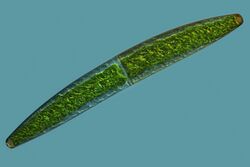
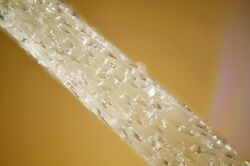
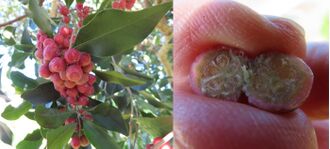
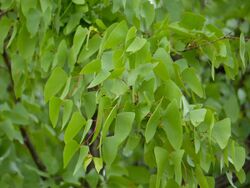
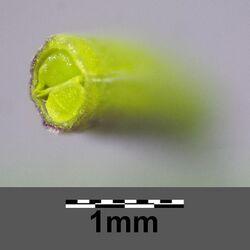
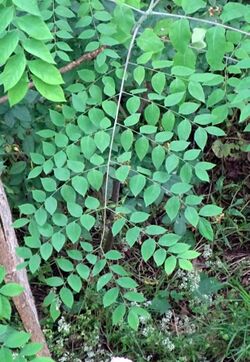
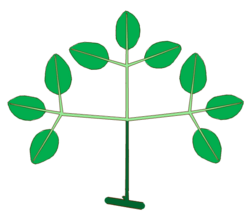
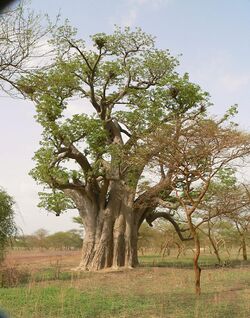
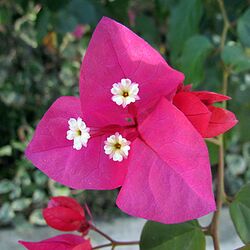
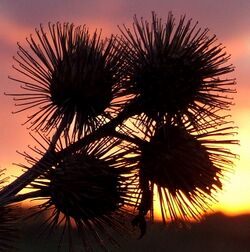
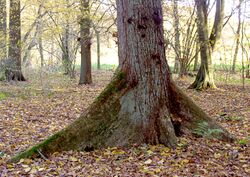
C
- caducous
- Falling off early, e.g. the sepals of poppies, which fall off when the petals begin to open. Compare persistent and fugacious.
- caespitose
- Tufted or turf-like, e.g. the growth form of some grasses.
- calcarate
- possessing a spur.
- calcareous
- A soil type or a lichen substrate rock type that is rich in or largely composed of calcium carbonate.
- calceolate
- Shaped like a slipper.[25]
- calcicole
- A plant which thrives in calcareous soil. Also calciphile, calciphyte. Antonym: calcifuge. [25]
- callose
- Hardened; thickened; callous.
- callus
1. A protruding mass of tissue
- 2. Undifferentiated tissue growth formed in response to wounding; may be grown in vitro.
- 3. In orchids, fleshy outgrowths from the labellum which can be variously shaped from papillae to plates.
- 4. In grasses, a hardened extension from the base of a floret (formed from the rachilla joint and/or the base of the lemma), which may or may not elongate and is often covered in hairs or bristles.
- calyciflorous
- Having petals and stamens attached to the calyx.
- calycophyll
- Leaf-like structure formed from a sepal or calyx lobe which enlarges, usually many-fold, before or after anthesis, especially when most of the other sepals or calyx lobes retain their original size. More extreme than an accrescent calyx, calycophylls are found in Rubiaceae. Compare semaphyll and pterophyll.
- calyculate
- Having an epicalyx.
- calyculus
- 1. A cup-shaped structure formed from bracts resembling an outer calyx.
- 2. In some Asteraceae, a circle of bracts below the involucre.
- calyptra
- A hood or lid. See operculum.
- calyx
Collective term for the sepals of one flower; the outer whorl of a flower, usually green. Compare corolla.
- calyx tube
- A tube formed by the fusion of the sepals (calyx), at least at the base.
- cambium
- Tissue layer that provides partially undifferentiated cells for plant growth.
- campanulate
- Bell-shaped.
- camptodromous
- Pinnate venation in which the secondary veins curve toward the margins, in some cases becoming nearly parallel with them, and not reconnecting with other veins to form loops.
- campylotropous
- When the ovule is oriented transversely (i.e. with its axis at right angles to its stalk) and with a curved embryo sac. Compare amphitropus, anatropous, and orthotropous.
- canaliculate
- Channelled; having a longitudinal groove.
- canescent
- Approaching white in color, as in a leaf covered with white down or wool.
- canopy
- Branches and foliage of a tree; the crown. Also refers to the protective upper layer of a forest. Compare trunk.
- capillary
- 1. Tube, pore, or passage with a narrow, internal cross-section.
- 2. Slender; hair-like.
- capitate
- 1. (of an inflorescence) Having a knob-like head, with the flowers unstalked and aggregated into a dense cluster.
- 2. (of a stigma) Like the head of a pin.
- capitulum
- Dense cluster of sessile or subsessile flowers or florets, e.g. a flower head in the daisy family Asteraceae. See pseudanthium.
- capsule
- Dry fruit formed from two or more united carpels and dehiscing when ripe (usually by splitting into pieces or opening at summit by teeth or pores).
- carduoid
- In Asteraceae, having a style with a ring of sweeping hairs borne on the shaft of the style below the style branches.
- carina
- See keel.
- carinal canal
- Longitudinal cavity in the stems of Equisetum and extinct Equisetopsida, coinciding with a ridge in the stem surface.
- carneous
- Flesh-colored, especially as applied to some flowers.
- carnose, carnous
- Fleshy or pulpy in texture, especially as applied to some tissues or organs. Contrast coriaceous and corneous.
- Caropodium
- Genus of flowering plants in the family Apiaceae. Native range: Turkey to Iran. Not to be confused with Carpopodium
- carpel
- The basic female reproductive organ in angiosperms, either consisting of a single sporophyll or a single locule of a compound ovary, with a style and a stigma. The gynoecium is the collective term for all of the carpels of a single flower.
- carpellary
- Referring to carpels or to associated structures or outgrowths of carpels, for example staminodes attached to carpels in Nymphaeaceae, were frequently referred to as carpellary attachments. The current and past usage of the terms "carpellary attachments", paracarpels, and staminodes is confused and varies among authors.
- carpopodium
- On achenes (Cypselae), an elongation of the base of the gynoecium which looks distinct; the abscission zone, where the achene is separated from the receptacle.
- 2. Genus Carpopodium in the family Brassicaceae; not to be confused with Caropodium.
- cartilaginous
- Hard and tough; gristly. Compare corneous and coriaceous.
- caruncle
- A small piece of flesh-like tissue, typically lumpy or warty, growing on the testa near the hilum. Contrast aril.
- caryopsis
- A dry, indehiscent, one-seeded fruit in which the seed coat is closely fused to the fruit wall, e.g. in most grasses.
- Casparian strip
- A continuous band of suberin in the radial primary cell walls of the endodermis in vascular plant stems and roots that forms a permeability barrier to the passive diffusion of external water and solutes into the vascular tissue.
- cassideous
- Hood-, helmet- or bonnet-shaped; generally referring to floral anatomy, e.g. in the flowers of Aconitum, Satyrium, etc.
- castaneous
- Chestnut-colored, reddish-brown.[26]
- casual alien
- An exotic plant that appears with no apparent human assistance but does not develop a sustained population(s), or one that persists only by repeated new introductions. Compare alien.
- cataphyll
- Any plant structure which is morphologically a leaf but which has at most an incidental or transient photosynthetic function. They are either shed when their main function has been completed, or are incorporated into structures where, when dead, they serve a protective or supportive purpose.
- catenulate
- In the shape of a chain; formed of parts or cells connected as if chained together, e.g. some diatoms, algae, and cyanobacteria such as Anabaena. See also concatenate.
- catkin
- A spike, usually pendulous, in which the mostly small flowers are unisexual and without a conspicuous perianth, e.g. in willows, poplars, oaks, and casuarinas. The individual flowers often have scaly bracts and are generally wind-pollinated. Catkins are usually shed as a unit.
- caudate
- Having a narrow, tail-like appendage or tip, e.g. a drip tip. Contrast acuminate, cuspidate, and mucronate.
- caudex
The stem of a plant, especially a woody one; also used to mean a rootstock, or particularly a basal stem structure or storage organ from which new growth arises. Compare lignotuber.
- caudiciform
- Stem-like or caudex-like; sometimes used to mean "pachycaul", meaning "thick-stemmed".
- caulescent
- possessing a well-developed stem above ground, similar to cauline. Antonym: acaulescent (lacking an apparent stem).
- cauliflory
Having flowers or fruits growing directly from a tree's branches or trunk.[27]
- cauline
- Borne on an aerial stem or caulis, as with leaves, flowers, or fruits (when applied to the latter two organs, usually referring to older stems.
- caulirosulate
- Borne at the end of the stem or caulis, as with leaves or bracts.
- cell
- 1. The basic, microscopic unit of plant structure, generally consisting of compartments in a viscous fluid surrounded by a cell wall.
- 2. A cavity of an anther or ovary. <dt class="glossary " id="Lua error: Internal error: The interpreter has terminated with signal "24"." style="margin-top: 0.4em;">cenanthous
- (of a perianth) Lacking both stamens and pistil, i.e. a flower with neither androecium nor gynoecium. <dt class="glossary " id="Lua error: Internal error: The interpreter has terminated with signal "24"." style="margin-top: 0.4em;">centrifixed
- Of a two-branched organ attached by its center, e.g. a hair or anther. <dt class="glossary " id="Lua error: Internal error: The interpreter has terminated with signal "24"." style="margin-top: 0.4em;">ceraceous
- Having a waxy appearance, color, or texture, e.g. flowers of many species of Ceropegia, and the waxy fruit of some species of Myrica. <dt class="glossary " id="Lua error: Internal error: The interpreter has terminated with signal "24"." style="margin-top: 0.4em;">cernuous
- Nodding, falling headlong or face down; inclined, stooping, or bowing forward. Applied to many species with a nodding, stooping habit, such as many Narcissus and Dierama species. Many plant species bear the specific epithet "cernua". <dt class="glossary " id="Lua error: Internal error: The interpreter has terminated with signal "24"." style="margin-top: 0.4em;">cespitose
- An alternative spelling of caespitose, meaning tufted or turf-like, e.g. the growth form of some grasses. <dt class="glossary " id="Lua error: Internal error: The interpreter has terminated with signal "24"." style="margin-top: 0.4em;">chamber
- A cavity of an ovary. <dt class="glossary " id="Lua error: Internal error: The interpreter has terminated with signal "24"." style="margin-top: 0.4em;">channelled
- Sunken below the surface, resulting in a rounded channel. <dt class="glossary " id="Lua error: Internal error: The interpreter has terminated with signal "24"." style="margin-top: 0.4em;">chartaceous
- Having a papery texture. <dt class="glossary " id="Lua error: Internal error: The interpreter has terminated with signal "24"." style="margin-top: 0.4em;">chasmogamous
- Of flowers that are pollinated when the perianth is open. Compare cleistogamous. <dt class="glossary " id="Lua error: Internal error: The interpreter has terminated with signal "24"." style="margin-top: 0.4em;">chasmophyte
- A plant adapted to growing in crevices or hollows, such as in cliff faces. Compare cremnophyte.Lua error: Internal error: The interpreter has terminated with signal "24".Lua error: Internal error: The interpreter has terminated with signal "24".Lua error: Internal error: The interpreter has terminated with signal "24".Lua error: Internal error: The interpreter has terminated with signal "24". <dt class="glossary " id="Lua error: Internal error: The interpreter has terminated with signal "24"." style="margin-top: 0.4em;">chimera
- An individual composed of two or more genetically distinct tissues, most commonly as a result of a graft and sometimes by mutations that occur during cell division or cellular transfers during seed development. <dt class="glossary " id="Lua error: Internal error: The interpreter has terminated with signal "24"." style="margin-top: 0.4em;">chiropterophilous
- Pollinated by bats. <dt class="glossary " id="Lua error: Internal error: The interpreter has terminated with signal "24"." style="margin-top: 0.4em;">chlorophyll
- Any of a variety of different chemical pigments in chloroplasts that are essential for photosynthesis. <dt class="glossary " id="Lua error: Internal error: The interpreter has terminated with signal "24"." style="margin-top: 0.4em;">chloroplast
- An organelle present in plant cells which contains chlorophyll. <dt class="glossary " id="Lua error: Internal error: The interpreter has terminated with signal "24"." style="margin-top: 0.4em;">chlorosis
- An abnormal lack or paleness of color in a normally green organ. <dt class="glossary " id="Lua error: Internal error: The interpreter has terminated with signal "24"." style="margin-top: 0.4em;">cilia
Lua error: Internal error: The interpreter has terminated with signal "24".
Very small hairs or hair-like protrusions more or less confined to the margins of an organ, as with eyelashes; in motile cells, minute, hair-like protrusions which aid motility.
<dt class="glossary " id="Lua error: Internal error: The interpreter has terminated with signal "24"." style="margin-top: 0.4em;">circinate
- Spirally coiled with the tip innermost, e.g. circinate vernation of the developing fronds of most ferns. <dt class="glossary " id="Lua error: Internal error: The interpreter has terminated with signal "24"." style="margin-top: 0.4em;">cirrhose
- (of a leaf) Ending in a tendril at the apex. <dt class="glossary " id="Lua error: Internal error: The interpreter has terminated with signal "24"." style="margin-top: 0.4em;">cirrus
- See tendril. <dt class="glossary " id="Lua error: Internal error: The interpreter has terminated with signal "24"." style="margin-top: 0.4em;">cladode
- A photosynthetic branch or stem, often leaf-like and usually with foliage leaves either absent or much reduced. Compare phyllode. <dt class="glossary " id="Lua error: Internal error: The interpreter has terminated with signal "24"." style="margin-top: 0.4em;">class
- The principal category for taxa ranking between division and order. <dt class="glossary " id="Lua error: Internal error: The interpreter has terminated with signal "24"." style="margin-top: 0.4em;">clathrate
- Shaped like a net or lattice; pierced with apertures, as with a cage. <dt class="glossary " id="Lua error: Internal error: The interpreter has terminated with signal "24"." style="margin-top: 0.4em;">clavate
- Club-shaped. <dt class="glossary " id="Lua error: Internal error: The interpreter has terminated with signal "24"." style="margin-top: 0.4em;">clavuncula
- In the Apocynaceae, an enlarged, drum-shaped stigma of which the sides and lower surface are the receptive zones. Coherent with the anthers or not. <dt class="glossary " id="Lua error: Internal error: The interpreter has terminated with signal "24"." style="margin-top: 0.4em;">claw
- 1. A narrow, stalk-like, basal portion of a petal, sepal, or bract.
- 2. In Melaleuca, the united portion of a stamen bundle. <dt class="glossary " id="Lua error: Internal error: The interpreter has terminated with signal "24"." style="margin-top: 0.4em;">cleistogamous
- Having flowers which self-pollinate and never open fully, or which self-pollinate before opening. Compare chasmogamous. <dt class="glossary " id="Lua error: Internal error: The interpreter has terminated with signal "24"." style="margin-top: 0.4em;">climber
- A plant growing more or less erect by leaning on or twining around another structure for support, or by clinging with tendrils. <dt class="glossary " id="Lua error: Internal error: The interpreter has terminated with signal "24"." style="margin-top: 0.4em;">climbing
- See climber. <dt class="glossary " id="Lua error: Internal error: The interpreter has terminated with signal "24"." style="margin-top: 0.4em;">cline
Lua error: Internal error: The interpreter has terminated with signal "24".
A continuous morphological variation in form within a species or sometimes between two species.
<dt class="glossary " id="Lua error: Internal error: The interpreter has terminated with signal "24"." style="margin-top: 0.4em;">clone
- A plant derived from the asexual vegetative reproduction of a parent plant, with both plants having identical genetic compositions. <dt class="glossary " id="Lua error: Internal error: The interpreter has terminated with signal "24"." style="margin-top: 0.4em;">coalescent
- Having plant parts fused or grown together to form a single unit. <dt class="glossary " id="Lua error: Internal error: The interpreter has terminated with signal "24"." style="margin-top: 0.4em;">cochleariform
- Concave and spoon-shaped. <dt class="glossary " id="Lua error: Internal error: The interpreter has terminated with signal "24"." style="margin-top: 0.4em;">cochleate
- Coiled like a snail's shell. <dt class="glossary " id="Lua error: Internal error: The interpreter has terminated with signal "24"." style="margin-top: 0.4em;">coenobium
- An arranged colony of algae that acts like a single organism. <dt class="glossary " id="Lua error: Internal error: The interpreter has terminated with signal "24"." style="margin-top: 0.4em;">coenocyte
- A single cell with multiple nuclei, formed when nuclear division was not followed by cytokinesis. <dt class="glossary " id="Lua error: Internal error: The interpreter has terminated with signal "24"." style="margin-top: 0.4em;">coleoptile
- One type of sheath in the structure of monocotyledonous seeds. The coleoptile is a protective sheath or cap (pileus), generally more or less pointed, that covers the monocotyledonous plumule as it emerges from the soil. It generally turns green and contributes to photosynthesis until its function is superseded by the main growth of the seedling. Contrast this with the coleorhiza, which remains underground until it is superseded as the roots emerge. <dt class="glossary " id="Lua error: Internal error: The interpreter has terminated with signal "24"." style="margin-top: 0.4em;">coleorhiza
- One type of sheath in the structure of monocotyledonous seeds. The coleorhiza connects the coleoptile to the radicle and protects the monocotyledonous radicle during germination. Unlike the coleoptile, the coleorhiza is associated with the root and does not emerge from the soil during germination. Contrast coleoptile. <dt class="glossary " id="Lua error: Internal error: The interpreter has terminated with signal "24"." style="margin-top: 0.4em;">collenchyma
- A specialized tissue consisting of living cells with unevenly thickened cellulose and pectin cell walls that performs a support function in organs such as leaves and young stems that are composed of primary plant tissues. <dt class="glossary " id="Lua error: Internal error: The interpreter has terminated with signal "24"." style="margin-top: 0.4em;">colleter
- A multicellular, glandular hair that usually produces a mucilaginous substance and is located on sepals, stipules, or petioles, or on nearby parts of stems; commonly found on plants in the order Gentianales. <dt class="glossary " id="Lua error: Internal error: The interpreter has terminated with signal "24"." style="margin-top: 0.4em;">columella
- In flowering plants, the central axis of the cone or fruit, e.g. in Callitris. <dt class="glossary " id="Lua error: Internal error: The interpreter has terminated with signal "24"." style="margin-top: 0.4em;">column
- 1. A structure extending above the ovary and incorporating the style and stamens also known as the gynostegium, e.g. in orchids and milkweeds.
- 2. In grasses, the lower, stouter, and usually twisted part of an awn, distinct from the slender upper part or bristle. <dt class="glossary " id="Lua error: Internal error: The interpreter has terminated with signal "24"." style="margin-top: 0.4em;">columnar
- Shaped like a column. <dt class="glossary " id="Lua error: Internal error: The interpreter has terminated with signal "24"." style="margin-top: 0.4em;">coma
- 1. A tuft of hairs from testa or funiculus at one or both ends of some seeds, e.g. in Strophanthus, Asclepias, or Alstonia.
- 2. Sterile bracts, e.g. in Curcuma, Ananas, or Eucomis.
- 3. Sterile flowers, e.g. in Muscari and Leopoldia, at the apex of some inflorescences.
- 4. A tuft of hairs at the base of some flowers, e.g. in Pfaffia gnaphalioides.
- 5. A tuft of hairs at the apex or base of some spikelets.
- 6. An axil tuft of hairs in inflorescences in some Poaceae, e.g. in Eragrostis comata. <dt class="glossary " id="Lua error: Internal error: The interpreter has terminated with signal "24"." style="margin-top: 0.4em;">commercial name
- A name often of no botanical standing and not governed by the ICNCP. The term generally applies to names such as Trademark Names, names covered by Plant Breeders Rights, Patents and Promotional Names, which are often used to enhance the sale of a plant. <dt class="glossary " id="Lua error: Internal error: The interpreter has terminated with signal "24"." style="margin-top: 0.4em;">commissure
- The seam or face at which two carpels adhere. See also fissure and suture. <dt class="glossary " id="Lua error: Internal error: The interpreter has terminated with signal "24"." style="margin-top: 0.4em;">community
- An ecological assemblage of plants that characteristically occur together. <dt class="glossary " id="Lua error: Internal error: The interpreter has terminated with signal "24"." style="margin-top: 0.4em;">compound
- Composed of several parts, e.g. a leaf composed of multiple leaflets, a gynoecium composed of multiple carpels, or an inflorescence made up of multiple smaller inflorescences. <dt class="glossary " id="Lua error: Internal error: The interpreter has terminated with signal "24"." style="margin-top: 0.4em;">compound palmate
- Having leaflets that radiate from a central point (usually at the top of a petiole), like spread-out fingers radiating from the palm of a hand. Compare palmate. <dt class="glossary " id="Lua error: Internal error: The interpreter has terminated with signal "24"." style="margin-top: 0.4em;">compressed
- Flattened lengthwise, either laterally (from side to side) or dorsally (from front to back). <dt class="glossary " id="Lua error: Internal error: The interpreter has terminated with signal "24"." style="margin-top: 0.4em;">concatenate
- Joined together in a chain-like form. See also concatenate and catenate. <dt class="glossary " id="Lua error: Internal error: The interpreter has terminated with signal "24"." style="margin-top: 0.4em;">concolorous
- Having the same color throughout; uniformly colored. <dt class="glossary " id="Lua error: Internal error: The interpreter has terminated with signal "24"." style="margin-top: 0.4em;">conduplicate
- Arranged such that two sides of a flat surface are folded along the midline to face each other. See also ptyxis, aestivation, and vernation. <dt class="glossary " id="Lua error: Internal error: The interpreter has terminated with signal "24"." style="margin-top: 0.4em;">cone
- A type of fruit, usually woody, ovoid to globular, including scales, bracts, or bracteoles arranged around a central axis, e.g. in gymnosperms, especially conifers and Casuarina. <dt class="glossary " id="Lua error: Internal error: The interpreter has terminated with signal "24"." style="margin-top: 0.4em;">conflorescence
- A rarely used term describing substantial differences between the overall structure of an inflorescence and that of its individual branches, e.g. the bottlebrush multiple-flower head of members of the genus Callistemon. <dt class="glossary " id="Lua error: Internal error: The interpreter has terminated with signal "24"." style="margin-top: 0.4em;">connate
- Fused to another organ (or organs) of the same kind, e.g. petals in a gamopetalous corolla tube. Compare adnate. <dt class="glossary " id="Lua error: Internal error: The interpreter has terminated with signal "24"." style="margin-top: 0.4em;">connective
- The part of an anther that connects the anther cells. <dt class="glossary " id="Lua error: Internal error: The interpreter has terminated with signal "24"." style="margin-top: 0.4em;">connivent
- Coming into contact or converging. <dt class="glossary " id="Lua error: Internal error: The interpreter has terminated with signal "24"." style="margin-top: 0.4em;">conspecific
- Belonging to the same species. <dt class="glossary " id="Lua error: Internal error: The interpreter has terminated with signal "24"." style="margin-top: 0.4em;">contiguous
- Adjoining, touching, but not united. <dt class="glossary " id="Lua error: Internal error: The interpreter has terminated with signal "24"." style="margin-top: 0.4em;">contort
- (of sepals or petals) A type of imbricate aestivation in which one side of each segment overlaps one of the adjacent segments and the other side is overlapped by the other adjacent segment. See convolute. <dt class="glossary " id="Lua error: Internal error: The interpreter has terminated with signal "24"." style="margin-top: 0.4em;">contorted
- Twisted out of the normal shape. <dt class="glossary " id="Lua error: Internal error: The interpreter has terminated with signal "24"." style="margin-top: 0.4em;">convolute
- 1. Referring to the arrangement of floral or foliar organs in a bud when each organ or segment has one edge overlapping the adjacent organ or segment; a form of imbricate arrangement. See contort.
- 2. (of leaves) A type of vernation in which one leaf is rolled up inside another.
- 3. A type of vernation of two leaves at a node, in which one half of each leaf is exposed and the other half is wrapped inside the other leaf. <dt class="glossary " id="Lua error: Internal error: The interpreter has terminated with signal "24"." style="margin-top: 0.4em;">corcle
- A plant embryo, plumule, or plumule plus radicle. <dt class="glossary " id="Lua error: Internal error: The interpreter has terminated with signal "24"." style="margin-top: 0.4em;">cordate
- Heart-shaped, with the notch lowermost; of the base of a leaf, like the notched part of a heart. Contrast obcordate. <dt class="glossary " id="Lua error: Internal error: The interpreter has terminated with signal "24"." style="margin-top: 0.4em;">coriaceous
- Leathery; stiff and tough, but flexible. Compare corneous. <dt class="glossary " id="Lua error: Internal error: The interpreter has terminated with signal "24"." style="margin-top: 0.4em;">corm
Lua error: Internal error: The interpreter has terminated with signal "24".
A fleshy, swollen stem base, usually underground and functioning in the storage of food reserves, with buds naked or covered by very thin scales; a type of rootstock.
<dt class="glossary " id="Lua error: Internal error: The interpreter has terminated with signal "24"." style="margin-top: 0.4em;">cormel
- A small corm (or cormlet), forming at the base of a growing larger corm.Lua error: Internal error: The interpreter has terminated with signal "24".Lua error: Internal error: The interpreter has terminated with signal "24". <dt class="glossary " id="Lua error: Internal error: The interpreter has terminated with signal "24"." style="margin-top: 0.4em;">corneous
- Horny in texture; stiff and hard, but somewhat tough. Compare coriaceous. <dt class="glossary " id="Lua error: Internal error: The interpreter has terminated with signal "24"." style="margin-top: 0.4em;">corolla
- A collective term for the petals of a flower. Compare calyx. <dt class="glossary " id="Lua error: Internal error: The interpreter has terminated with signal "24"." style="margin-top: 0.4em;">corona
- 1. In flowering plants, a ring of structures that may be united in a tube, arising from the corolla or perianth of a flower and standing between the perianth lobes and the stamens. The trumpet of a daffodil is a corona.
- 2. In grasses, a hardened ring of tissue surmounting the lemma in some species. <dt class="glossary " id="Lua error: Internal error: The interpreter has terminated with signal "24"." style="margin-top: 0.4em;">cortex
Lua error: Internal error: The interpreter has terminated with signal "24".
A region of tissue located between the surface cells and the vascular cylinder.Lua error: Internal error: The interpreter has terminated with signal "24".Lua error: Internal error: The interpreter has terminated with signal "24".
<dt class="glossary " id="Lua error: Internal error: The interpreter has terminated with signal "24"." style="margin-top: 0.4em;">corticolous
- Growing on bark or on wood with the bark stripped off. Compare lignicolous. <dt class="glossary " id="Lua error: Internal error: The interpreter has terminated with signal "24"." style="margin-top: 0.4em;">corymb
Lua error: Internal error: The interpreter has terminated with signal "24".
An inflorescence with branches arising at different points but reaching about the same height, giving the flower cluster a flat-topped appearance.
<dt class="glossary " id="Lua error: Internal error: The interpreter has terminated with signal "24"." style="margin-top: 0.4em;">costa
- A rib. <dt class="glossary " id="Lua error: Internal error: The interpreter has terminated with signal "24"." style="margin-top: 0.4em;">costapalmate
- Having a definite costa (midrib), unlike the typical palmate or fan leaf, but with the leaflets arranged radially as in a palmate leaf. <dt class="glossary " id="Lua error: Internal error: The interpreter has terminated with signal "24"." style="margin-top: 0.4em;">cotyledon
- The primary leaf or leaves of a plant embryo which upon germination develops into the seed-leaf or the first set of leaves. <dt class="glossary " id="Lua error: Internal error: The interpreter has terminated with signal "24"." style="margin-top: 0.4em;">craspedodromous
- Pinnate venation in which the secondary veins terminate at the margins, often as teeth. <dt class="glossary " id="Lua error: Internal error: The interpreter has terminated with signal "24"." style="margin-top: 0.4em;">crateriform
- In the shape of a saucer or shallow cup; hemispherical or more shallow. <dt class="glossary " id="Lua error: Internal error: The interpreter has terminated with signal "24"." style="margin-top: 0.4em;">cremnophyte
- A plant adapted to growing on, especially hanging from, cliff faces or crevices. Compare chasmophyte.Lua error: Internal error: The interpreter has terminated with signal "24".Lua error: Internal error: The interpreter has terminated with signal "24".Lua error: Internal error: The interpreter has terminated with signal "24".Lua error: Internal error: The interpreter has terminated with signal "24". <dt class="glossary " id="Lua error: Internal error: The interpreter has terminated with signal "24"." style="margin-top: 0.4em;">crenate
- Having blunt or rounded teeth; scalloped. <dt class="glossary " id="Lua error: Internal error: The interpreter has terminated with signal "24"." style="margin-top: 0.4em;">crenulate
- Minutely scalloped. <dt class="glossary " id="Lua error: Internal error: The interpreter has terminated with signal "24"." style="margin-top: 0.4em;">crisped
- Finely curled, as with the edges of leaves and petals. <dt class="glossary " id="Lua error: Internal error: The interpreter has terminated with signal "24"." style="margin-top: 0.4em;">cristarque cell
- A sclereid which contains a druse and has the lignin deposited excentrically on the cell wall to form a cup shape, or in cross-section, a ∪-shape. <dt class="glossary " id="Lua error: Internal error: The interpreter has terminated with signal "24"." style="margin-top: 0.4em;">crown
- See canopy. <dt class="glossary " id="Lua error: Internal error: The interpreter has terminated with signal "24"." style="margin-top: 0.4em;">cross
- To make something interbreed; the act of hybridization. <dt class="glossary " id="Lua error: Internal error: The interpreter has terminated with signal "24"." style="margin-top: 0.4em;">cruciform
- Cross-shaped. <dt class="glossary " id="Lua error: Internal error: The interpreter has terminated with signal "24"." style="margin-top: 0.4em;">crustaceous
- Hard, thin and brittle. <dt class="glossary " id="Lua error: Internal error: The interpreter has terminated with signal "24"." style="margin-top: 0.4em;">crustose
- Forming a closely applied surface layer or crust. <dt class="glossary " id="Lua error: Internal error: The interpreter has terminated with signal "24"." style="margin-top: 0.4em;">cryptogam
- Any of the "lower plants" which produce spores and do not have stamens, ovaries, or seeds; literally, plants whose sexual reproductive organs are not conspicuous. This group typically includes the ferns, bryophytes, and algae, and sometimes fungi (including lichenized fungi). Compare phanerogam. <dt class="glossary " id="Lua error: Internal error: The interpreter has terminated with signal "24"." style="margin-top: 0.4em;">cucullate
- Hood-like or hooded, commonly referring to the shape of leaves or petals, e.g. Pelargonium cucullatum. Similarly derived terms include cuculliform and cuccularis. <dt class="glossary " id="Lua error: Internal error: The interpreter has terminated with signal "24"." style="margin-top: 0.4em;">culm
- In grasses, sedges, rushes, and some other monocotyledons, an aerial stem bearing the inflorescence, extending strictly from the base of the plant to the lowest involucral bract (or base of the inflorescence). <dt class="glossary " id="Lua error: Internal error: The interpreter has terminated with signal "24"." style="margin-top: 0.4em;">cultigen
- A plant whose origin or selection is primarily due to intentional human activity. <dt class="glossary " id="Lua error: Internal error: The interpreter has terminated with signal "24"." style="margin-top: 0.4em;">cultivar
- A term derived from "cultivated variety" denoting an assemblage of cultivated plants clearly distinguished by one or more characters (morphological, physiological, cytological, chemical, or other). When reproduced (either sexually or asexually), the assemblage retains its distinguishing characters. A cultivar may arise in cultivation or be introduced from the wild. It is a variant that is of horticultural interest or value. Cultivar names are written with single quotation marks around them, e.g. 'Blue Carpet' or 'Alba'. All new names established after 1 January 1959 must be in common language (that is, not in Latin), but names established in Latin prior to this date are retained in Latin form. <dt class="glossary " id="Lua error: Internal error: The interpreter has terminated with signal "24"." style="margin-top: 0.4em;">cultivar epithet
- The defining part of a name that denominates a cultivar. Cultivars are designated by fancy (q.v.) epithets appended either to the scientific name or to the common name of the taxon to which they belong; they are not italicized but placed in single quotation marks, e.g. Rubus nitidoides 'Merton Early'. 'Merton Early' is the cultivar epithet. <dt class="glossary " id="Lua error: Internal error: The interpreter has terminated with signal "24"." style="margin-top: 0.4em;">cuneate
- Wedge-shaped, with straight sides converging at a base. <dt class="glossary " id="Lua error: Internal error: The interpreter has terminated with signal "24"." style="margin-top: 0.4em;">cupule
- A cup-shaped structure composed of coalescent bracts, such as the cup of an acorn. See calybium. <dt class="glossary " id="Lua error: Internal error: The interpreter has terminated with signal "24"." style="margin-top: 0.4em;">cupular
- Shaped like a cupule. <dt class="glossary " id="Lua error: Internal error: The interpreter has terminated with signal "24"." style="margin-top: 0.4em;">cupulate
- Bearing cupules. <dt class="glossary " id="Lua error: Internal error: The interpreter has terminated with signal "24"." style="margin-top: 0.4em;">cupuliform
- Nearly hemispherical, shaped like a cupola or dome. <dt class="glossary " id="Lua error: Internal error: The interpreter has terminated with signal "24"." style="margin-top: 0.4em;">cusp
- A hard, pointed tip, stiffer and more formidable than a mucro, hence cuspidate. <dt class="glossary " id="Lua error: Internal error: The interpreter has terminated with signal "24"." style="margin-top: 0.4em;">cuspidate
- Tipped with a cusp, as with some leaves. <dt class="glossary " id="Lua error: Internal error: The interpreter has terminated with signal "24"." style="margin-top: 0.4em;">cuticle
- A waterproofing layer covering the epidermis of aerial plant surfaces and composed of the polymers cutin, and/or cutan and waxes. <dt class="glossary " id="Lua error: Internal error: The interpreter has terminated with signal "24"." style="margin-top: 0.4em;">cutting
- An apical tip of shoot structure, root, or leaf which is cut from a plant and used for asexual vegetative propagation. <dt class="glossary " id="Lua error: Internal error: The interpreter has terminated with signal "24"." style="margin-top: 0.4em;">cyathium
Lua error: Internal error: The interpreter has terminated with signal "24".
An inflorescence of unisexual flowers surrounded by involucral bracts, especially the flowers of Euphorbia.
<dt class="glossary " id="Lua error: Internal error: The interpreter has terminated with signal "24"." style="margin-top: 0.4em;">cyathophyll
- In Euphorbia, the bract-like structure on which the involucre sits, usually but not always occurring in twos. They may sometimes be brightly colored and confused with petals. <dt class="glossary " id="Lua error: Internal error: The interpreter has terminated with signal "24"." style="margin-top: 0.4em;">cylindrical
- Rod-like and two to three times as long as wide. Compare baculiform. <dt class="glossary " id="Lua error: Internal error: The interpreter has terminated with signal "24"." style="margin-top: 0.4em;">cynaroid
- See carduoid. <dt class="glossary " id="Lua error: Internal error: The interpreter has terminated with signal "24"." style="margin-top: 0.4em;">cyme
Lua error: Internal error: The interpreter has terminated with signal "24".
A type of inflorescence in which the main axis and all lateral branches end in a flower (each lateral may be repeatedly branched).
<dt class="glossary " id="Lua error: Internal error: The interpreter has terminated with signal "24"." style="margin-top: 0.4em;">cymose
- Having a cyme or cymes. <dt class="glossary " id="Lua error: Internal error: The interpreter has terminated with signal "24"." style="margin-top: 0.4em;">cypsela
- A type of dry, one-seeded, indehiscent fruit formed from an inferior ovary.
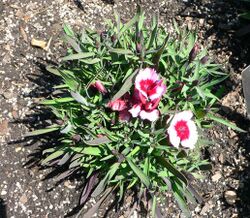
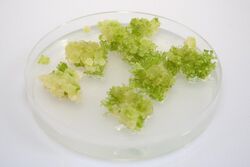
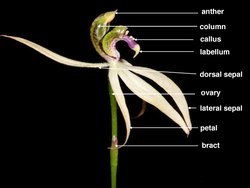
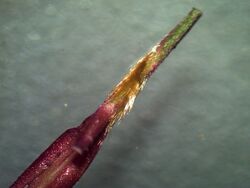
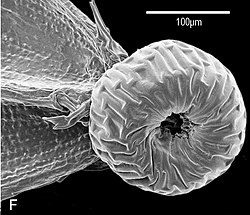
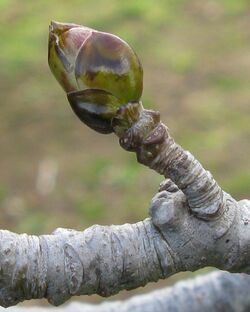
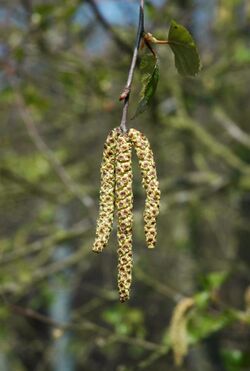
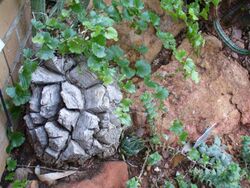
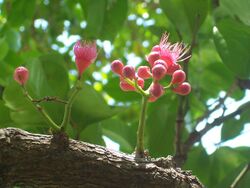

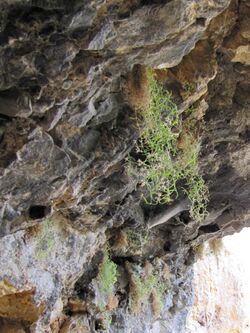
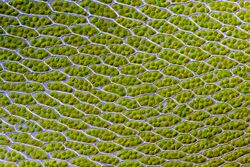
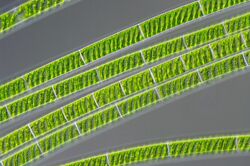
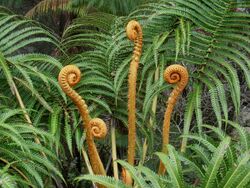
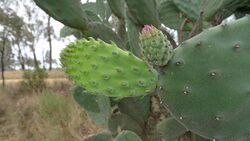
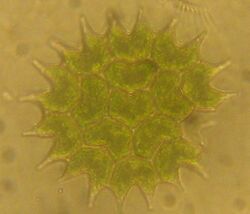
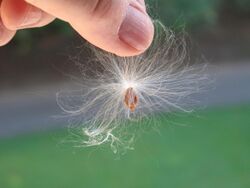
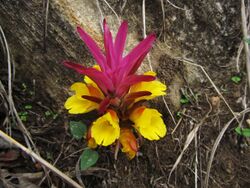
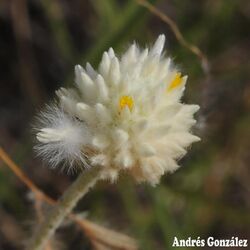
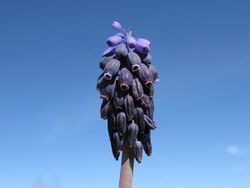
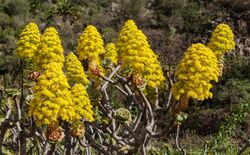
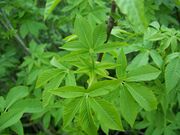
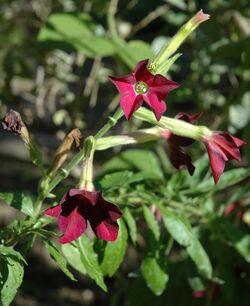
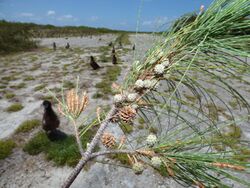


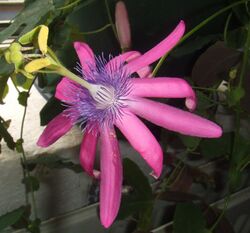
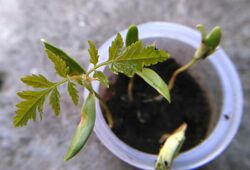
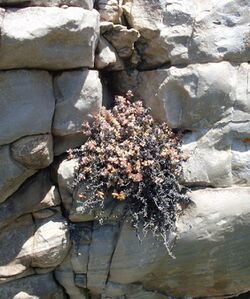
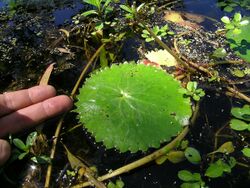
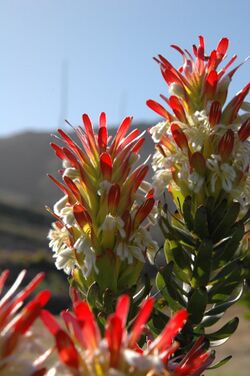

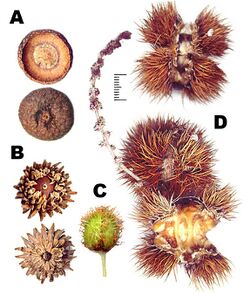
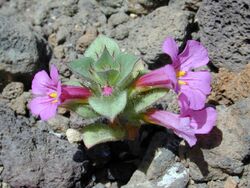
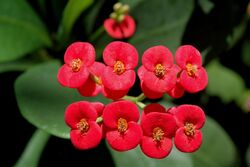
D
- Dehiscing and falling seasonally, as with bark, leaves, or petals. Contrast persistent. <dt class="glossary " id="Lua error: Internal error: The interpreter has terminated with signal "24"." style="margin-top: 0.4em;">declinate
- Curving downward, and then upward at the tip. Often qualified, e.g. declinate-ascendant. <dt class="glossary " id="Lua error: Internal error: The interpreter has terminated with signal "24"." style="margin-top: 0.4em;">decompound
- Divided to more than one level, e.g. in bipinnate leaves, in which the leaflets of what would otherwise be a pinnate leaf are themselves pinnately divided. <dt class="glossary " id="Lua error: Internal error: The interpreter has terminated with signal "24"." style="margin-top: 0.4em;">decorticate
- 1. (intr. v.) To shed the outer bark of a tree, usually seasonally as part of the natural growth cycle.
- 2. (tr. v.) To strip the peel, crust, bark, or other surface tissues from a plant or from harvested material, such as in extracting fiber from harvested Agave leaves. <dt class="glossary " id="Lua error: Internal error: The interpreter has terminated with signal "24"." style="margin-top: 0.4em;">decumbent
- Having branches growing horizontally along the ground but which are turned up at the ends. <dt class="glossary " id="Lua error: Internal error: The interpreter has terminated with signal "24"." style="margin-top: 0.4em;">decurrent
- Extending downward beyond the point of insertion, e.g. when the base of a leaf or a fungal gill is prolonged downward along the stem in a raised line or narrow wing. <dt class="glossary " id="Lua error: Internal error: The interpreter has terminated with signal "24"." style="margin-top: 0.4em;">decussant
- A synonym of decussate; the usage decussant is questionable and occurs rarely, probably as an error. The formally correct usage is decussate. <dt class="glossary " id="Lua error: Internal error: The interpreter has terminated with signal "24"." style="margin-top: 0.4em;">decussate
- Opposite with successive pairs borne at right angles to the last; generally applied to the arrangement of leaves. <dt class="glossary " id="Lua error: Internal error: The interpreter has terminated with signal "24"." style="margin-top: 0.4em;">definite
- Of a constant number, e.g. twice as many stamens as petals or sepals (or less), or an inflorescence ending in a flower or an aborted floral bud, typically a cymose inflorescence. Contrast indefinite. <dt class="glossary " id="Lua error: Internal error: The interpreter has terminated with signal "24"." style="margin-top: 0.4em;">deflexed
- Bent downward. Contrast inflexed. <dt class="glossary " id="Lua error: Internal error: The interpreter has terminated with signal "24"." style="margin-top: 0.4em;">dehiscent
- Breaking open at maturity to release contents; refers e.g. to the opening of fruits to release seeds, of anthers to release pollen, and of sporangia to release spores. Contrast indehiscent. <dt class="glossary " id="Lua error: Internal error: The interpreter has terminated with signal "24"." style="margin-top: 0.4em;">deltoid
- Shaped like the uppercase Greek letter Δ, i.e. like a more or less equilateral triangle. <dt class="glossary " id="Lua error: Internal error: The interpreter has terminated with signal "24"." style="margin-top: 0.4em;">dendroid
- Tree-like; branching like a tree. <dt class="glossary " id="Lua error: Internal error: The interpreter has terminated with signal "24"." style="margin-top: 0.4em;">dentate
- Toothed, especially in reference to leaf margins. <dt class="glossary " id="Lua error: Internal error: The interpreter has terminated with signal "24"." style="margin-top: 0.4em;">denticulate
- Finely toothed; a diminutive form of dentate. <dt class="glossary " id="Lua error: Internal error: The interpreter has terminated with signal "24"." style="margin-top: 0.4em;">deserticolous
- Inhabiting a desert. <dt class="glossary " id="Lua error: Internal error: The interpreter has terminated with signal "24"." style="margin-top: 0.4em;">determinate
- Limited, usually in growth. Contrast indeterminate. <dt class="glossary " id="Lua error: Internal error: The interpreter has terminated with signal "24"." style="margin-top: 0.4em;">diadelphous
- Referring to a class of adelphous structure in which the stamens or similar organs are connected in two adelphiae instead of just one. <dt class="glossary " id="Lua error: Internal error: The interpreter has terminated with signal "24"." style="margin-top: 0.4em;">diaspore
- Any reproductive part of a plant adapted for dispersal and for establishing new plants; may be a disseminule such as a seed, or other parts such as specialized buds, branches, inflorescences, or fruits. <dt class="glossary " id="Lua error: Internal error: The interpreter has terminated with signal "24"." style="margin-top: 0.4em;">dichasium
- A cymose inflorescence with all branches below the terminal flower in regular opposite pairs. Compare monochasium and pleiochasium. <dt class="glossary " id="Lua error: Internal error: The interpreter has terminated with signal "24"." style="margin-top: 0.4em;">dichlamydeous
- Having a perianth which is divided into a separate calyx and corolla. Compare homochlamydeous. <dt class="glossary " id="Lua error: Internal error: The interpreter has terminated with signal "24"." style="margin-top: 0.4em;">dichotomous
- Forking into two equal branches. This may result from an equal division of the growing tip, or may be sympodial, in which the growing tip is aborted and replaced. Typically refers to mode of branch growth, as in Aloidendron dichotomum, but also to other organs, such as the venation patterns on leaves, the thorns of various species of Carissa (which morphologically are branches), and the thalli or hyphae of various algae and fungi. <dt class="glossary " id="Lua error: Internal error: The interpreter has terminated with signal "24"." style="margin-top: 0.4em;">dicotyledon
Lua error: Internal error: The interpreter has terminated with signal "24".
A flowering plant whose embryo has two or more cotyledons (seed leaves). Contrast monocotyledon.
<dt class="glossary " id="Lua error: Internal error: The interpreter has terminated with signal "24"." style="margin-top: 0.4em;">digitate
- With segments spreading from a common center, like the fingers of a hand. See also palmate and palmatisect. See also Leaf shape. <dt class="glossary " id="Lua error: Internal error: The interpreter has terminated with signal "24"." style="margin-top: 0.4em;">digitiform
- Shaped like a finger. <dt class="glossary " id="Lua error: Internal error: The interpreter has terminated with signal "24"." style="margin-top: 0.4em;">dimorphic
- Occurring in two different forms (with respect to shape and/or size), e.g. of stamens, fronds, or leaves. See also monomorphic (having a single form) and polymorphic (having many forms). <dt class="glossary " id="Lua error: Internal error: The interpreter has terminated with signal "24"." style="margin-top: 0.4em;">dioecious
- (of vascular plants) Having male and female reproductive structures which develop only on different individuals and never on the same individual. Contrast monoecious. <dt class="glossary " id="Lua error: Internal error: The interpreter has terminated with signal "24"." style="margin-top: 0.4em;">dioicous
- (of a bryophyte gametophyte) Having male and female reproductive structures which develop only on different individuals and never on the same individual. Contrast monoicous. <dt class="glossary " id="Lua error: Internal error: The interpreter has terminated with signal "24"." style="margin-top: 0.4em;">diploid
- Having two complete sets of chromosomes in the nucleus of a sporophyte cell, i.e. one set from each of the parental gametes. This is often expressed symbolically as 2n, where n = the number of chromosomes in the haploid gamete. <dt class="glossary " id="Lua error: Internal error: The interpreter has terminated with signal "24"." style="margin-top: 0.4em;">diplostemonous
- Having stamens arranged in two whorls, with the outer whorl alternating with the petals while the inner whorl is opposite the petals. Compare obdiplostemonous and haplostemonous. <dt class="glossary " id="Lua error: Internal error: The interpreter has terminated with signal "24"." style="margin-top: 0.4em;">disc
Lua error: Internal error: The interpreter has terminated with signal "24".
A plate or ring of structures derived from the receptacle, and occurring between whorls of floral parts. In some groups, especially Sapindales, the nectary is in the form of a prominent disk. In daisies, the central part of the capitulum is a disk, hence flowers borne there are called disk flowers or florets.
<dt class="glossary " id="Lua error: Internal error: The interpreter has terminated with signal "24"." style="margin-top: 0.4em;">discoid
- Resembling a disc or plate, having both thickness and parallel faces and with a rounded margin. Also used to describe the flower head of Asteraceae where there are no ray florets but only disc florets. <dt class="glossary " id="Lua error: Internal error: The interpreter has terminated with signal "24"." style="margin-top: 0.4em;">discolorous
- (of leaves) Having upper and lower surfaces of different colors. <dt class="glossary " id="Lua error: Internal error: The interpreter has terminated with signal "24"." style="margin-top: 0.4em;">disjunct
- Occurring in widely separated geographic areas, distinctly separate; applies to a discontinuous range in which one or more populations are separated from other potentially interbreeding populations with sufficient distance so as to preclude gene flow between them. <dt class="glossary " id="Lua error: Internal error: The interpreter has terminated with signal "24"." style="margin-top: 0.4em;">disk floret
- A floret occurring most typically in the disk of the capitulum of flowers in the family Asteraceae, and to some extent in other plants that bear a flowering head with a disk, such as Scabiosa. <dt class="glossary " id="Lua error: Internal error: The interpreter has terminated with signal "24"." style="margin-top: 0.4em;">dissected
- Deeply divided; cut into many segments. <dt class="glossary " id="Lua error: Internal error: The interpreter has terminated with signal "24"." style="margin-top: 0.4em;">dissepiment
- A partition or septum in a plant part, usually referring to septa between the loculi of capsules or of other fruits with multiple partitions. <dt class="glossary " id="Lua error: Internal error: The interpreter has terminated with signal "24"." style="margin-top: 0.4em;">distal
- Remote from the point of origin or attachment; the free end. Contrast proximal. <dt class="glossary " id="Lua error: Internal error: The interpreter has terminated with signal "24"." style="margin-top: 0.4em;">distichous
- Arranged in two opposite rows (and hence in the same plane). <dt class="glossary " id="Lua error: Internal error: The interpreter has terminated with signal "24"." style="margin-top: 0.4em;">distinct
- Separate or free; not united. <dt class="glossary " id="Lua error: Internal error: The interpreter has terminated with signal "24"." style="margin-top: 0.4em;">distyly
- The condition in which the flowers of a species occur in two forms that differ only by the length of the style and stamens, and flowers of only one of these forms appear on any one plant. Compare heterostyly. <dt class="glossary " id="Lua error: Internal error: The interpreter has terminated with signal "24"." style="margin-top: 0.4em;">diurnal
- Of the day; occurring or opening in the daytime. <dt class="glossary " id="Lua error: Internal error: The interpreter has terminated with signal "24"." style="margin-top: 0.4em;">divaricate
- Wide-spreading. <dt class="glossary " id="Lua error: Internal error: The interpreter has terminated with signal "24"." style="margin-top: 0.4em;">divergent
- Spreading in different directions, generally upward. <dt class="glossary " id="Lua error: Internal error: The interpreter has terminated with signal "24"." style="margin-top: 0.4em;">division
- A taxonomic rank below kingdom in the standard taxonomic hierarchy. "Division" is generally used only for plants, and is the approximate botanical equivalent of the term phylum, which is used for animals and other kingdoms. <dt class="glossary " id="Lua error: Internal error: The interpreter has terminated with signal "24"." style="margin-top: 0.4em;">domatia
Lua error: Internal error: The interpreter has terminated with signal "24".
Any hollow structure formed by a plant that is inhabited by animals such as ants or mites.
<dt class="glossary " id="Lua error: Internal error: The interpreter has terminated with signal "24"." style="margin-top: 0.4em;">dorsal
- From Latin dorsum, a ridge or the back of an animal. Partly because the term originally referred to animals rather than plants, usage in botany is arbitrary according to context and source. In general "dorsal" refers to "the rear or back or upper surface", but in botanical usage such concepts are not always clearly defined and may be contradictory. For example:
- facing away from the axis (abaxial) in a lateral organ of an erect plant
- facing away from the substrate in any part of an erect plant, for example the upper surface of a more or less horizontal leaf (adaxial) or the upper part of the crown of the plant
- facing away from the substrate in a prostrate or climbing plant or floating leaves such as those of Nymphaea.
<dt class="glossary " id="Lua error: Internal error: The interpreter has terminated with signal "24"." style="margin-top: 0.4em;">dorsifixed
- Attached at or by the back, e.g. anthers on a filament. <dt class="glossary " id="Lua error: Internal error: The interpreter has terminated with signal "24"." style="margin-top: 0.4em;">dorsiventral
- Having structurally and visibly different upper and lower surfaces, e.g. some leaves. Compare bilateral and isobilateral. <dt class="glossary " id="Lua error: Internal error: The interpreter has terminated with signal "24"." style="margin-top: 0.4em;">drip tip
- A long, narrow, acuminate, caudate, or cuspidate extension at the tip of a leaf or leaflet. Commonly an adaptation to rainy conditions, as it promotes shedding of water by its dripping from the narrow tip. The term drip tip is not anatomically descriptive in the way that acuminate or cuspidate are, for example; rather, it is a description of the functional shape that aids dripping, regardless of the specific geometry of the shape itself. <dt class="glossary " id="Lua error: Internal error: The interpreter has terminated with signal "24"." style="margin-top: 0.4em;">drupe
- A type of succulent fruit formed from one carpel; the single seed is enclosed by a stony layer of the fruit wall, e.g. in peaches and olives. Also called a kernel. <dt class="glossary " id="Lua error: Internal error: The interpreter has terminated with signal "24"." style="margin-top: 0.4em;">drupelet
- A small drupe formed from one of the carpels in an apocarpous flower. Drupelets usually form a compound fruit, as in Rubus, but they may become widely separated, as in Ochna. <dt class="glossary " id="Lua error: Internal error: The interpreter has terminated with signal "24"." style="margin-top: 0.4em;">druse
- A globular mass of calcium oxalate crystals, usually with the crystals radiating from an organic core.
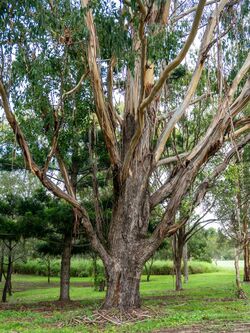
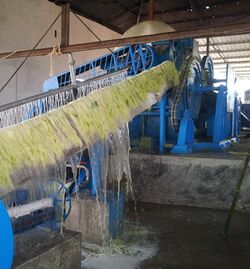
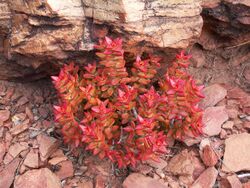
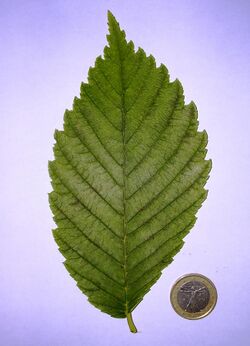
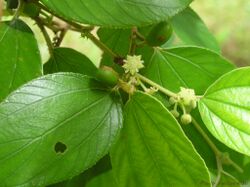
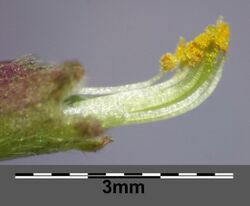
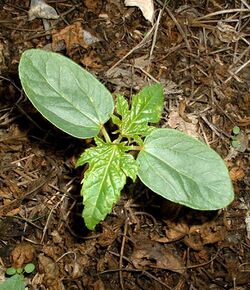
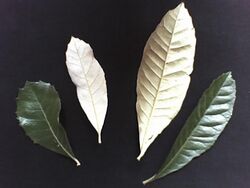
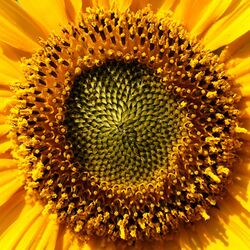
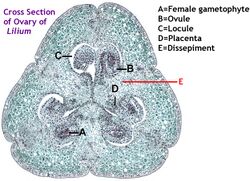
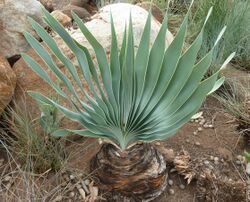
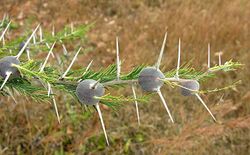
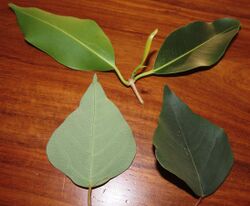
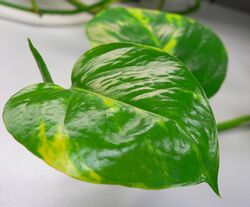
E
- A suffix added to the stem of a generic name to form the name of a tribe, e.g. Aster → Astereae. <dt class="glossary " id="Lua error: Internal error: The interpreter has terminated with signal "24"." style="margin-top: 0.4em;">ebracteate
- Lacking bracts; synonymous with ebracteolate. <dt class="glossary " id="Lua error: Internal error: The interpreter has terminated with signal "24"." style="margin-top: 0.4em;">ecological amplitude
- The range of environmental conditions in which an organism can survive. <dt class="glossary " id="Lua error: Internal error: The interpreter has terminated with signal "24"." style="margin-top: 0.4em;">edaphic
- Of or influenced by the soil. <dt class="glossary " id="Lua error: Internal error: The interpreter has terminated with signal "24"." style="margin-top: 0.4em;">eglandular
Lua error: Internal error: The interpreter has terminated with signal "24".
Not having glands.
<dt class="glossary " id="Lua error: Internal error: The interpreter has terminated with signal "24"." style="margin-top: 0.4em;">elaiosome
- An external structure attached to the seed of many species of plants. Elaiosomes generally look fleshy and in some species they are rich in oils or other nutritious materials. Their functions vary and are not always obvious; commonly they attract ants or other animals that aid in dispersal, but they may also repel other animals from eating the seed.Lua error: Internal error: The interpreter has terminated with signal "24".Lua error: Internal error: The interpreter has terminated with signal "24". <dt class="glossary " id="Lua error: Internal error: The interpreter has terminated with signal "24"." style="margin-top: 0.4em;">elephophily
- A form of pollination whereby pollen or spores are distributed by the feet of elephants, as in Rafflesia arnoldii. <dt class="glossary " id="Lua error: Internal error: The interpreter has terminated with signal "24"." style="margin-top: 0.4em;">ellipsoid
- A three-dimensional shape that is elliptical in all sections through the long axis. <dt class="glossary " id="Lua error: Internal error: The interpreter has terminated with signal "24"." style="margin-top: 0.4em;">elliptical
Lua error: Internal error: The interpreter has terminated with signal "24".
Planar, shaped like a flattened circle, symmetrical about both the long and the short axis, tapering equally both to the tip and the base; oval.
<dt class="glossary " id="Lua error: Internal error: The interpreter has terminated with signal "24"." style="margin-top: 0.4em;">emarginate
- Typically in reference to leaf margins: notched or recessed at some part of the edge, such as the apex; the recess usually is broad and shallow. The location of a leaf's emargination(s) might be one or more of apical, lateral or basal <dt class="glossary " id="Lua error: Internal error: The interpreter has terminated with signal "24"." style="margin-top: 0.4em;">embryo
- The young plant contained by a seed prior to germination. <dt class="glossary " id="Lua error: Internal error: The interpreter has terminated with signal "24"." style="margin-top: 0.4em;">emergent
- A plant taller than the surrounding vegetation or, among aquatic plant species, one that bears flowers and commonly leaves above the surface of the water. Aquatic examples include water lilies, reeds, and papyrus. Some pondweeds such as Stuckenia are not emergent until they flower, at which time only their flowers appear above the water surface. <dt class="glossary " id="Lua error: Internal error: The interpreter has terminated with signal "24"." style="margin-top: 0.4em;">enation
- Leaf-like outgrowth from a surface.Lua error: Internal error: The interpreter has terminated with signal "24".Lua error: Internal error: The interpreter has terminated with signal "24". <dt class="glossary " id="Lua error: Internal error: The interpreter has terminated with signal "24"." style="margin-top: 0.4em;">enantiostyly
- The condition in which the gynoecium protrudes laterally, to the right (dextrostyly) or to the left (sinistrostyly) of the androecium, e.g. Senna. <dt class="glossary " id="Lua error: Internal error: The interpreter has terminated with signal "24"." style="margin-top: 0.4em;">endemic
- Having a natural distribution restricted to a particular geographic region. Compare native. <dt class="glossary " id="Lua error: Internal error: The interpreter has terminated with signal "24"." style="margin-top: 0.4em;">endocarp
- The innermost layer of the wall of a fruit; in a drupe, the stony layer surrounding the seed. <dt class="glossary " id="Lua error: Internal error: The interpreter has terminated with signal "24"." style="margin-top: 0.4em;">endodermis
- The innermost layer of the cortex of vascular plant roots, also present in the stems of pteridophytes. The radial walls are impregnated with suberin to form a permeability barrier known as the Casparian strip. <dt class="glossary " id="Lua error: Internal error: The interpreter has terminated with signal "24"." style="margin-top: 0.4em;">endosperm
- 1. (angiosperms) A nutritive tissue surrounding the embryo of the seed, usually triploid, originating from the fusion of both polar nuclei with one gamete after the fertilization of the egg.
- 2. (gymnosperms) The prothallus within the embryo sac. <dt class="glossary " id="Lua error: Internal error: The interpreter has terminated with signal "24"." style="margin-top: 0.4em;">endospory
- The production of spores that germinate into a reduced multicellular gametophyte contained within the spore wall. Contrast exospory. <dt class="glossary " id="Lua error: Internal error: The interpreter has terminated with signal "24"." style="margin-top: 0.4em;">ensiform
- Shaped like the blade of a sword. <dt class="glossary " id="Lua error: Internal error: The interpreter has terminated with signal "24"." style="margin-top: 0.4em;">entire
- 1. Not divided.
- 2. (of a margin) Smooth and not lobed or toothed (though possibly wavy or scalloped). <dt class="glossary " id="Lua error: Internal error: The interpreter has terminated with signal "24"." style="margin-top: 0.4em;">entomophily
- A form of pollination whereby pollen or spores are distributed by insects. <dt class="glossary " id="Lua error: Internal error: The interpreter has terminated with signal "24"." style="margin-top: 0.4em;">epecophyte
- Species of recent appearance, usually numerous and constant in the country, but confined to artificial habitats, such as meadows and ruderal vegetation and are dependent on humans for existence.Lua error: Internal error: The interpreter has terminated with signal "24".Lua error: Internal error: The interpreter has terminated with signal "24". <dt class="glossary " id="Lua error: Internal error: The interpreter has terminated with signal "24"." style="margin-top: 0.4em;">ephemeral
- Short-lived. See also caducous. <dt class="glossary " id="Lua error: Internal error: The interpreter has terminated with signal "24"." style="margin-top: 0.4em;">epicalyx
- An involucre resembling an outer calyx, e.g. as in Hibiscus. <dt class="glossary " id="Lua error: Internal error: The interpreter has terminated with signal "24"." style="margin-top: 0.4em;">epicarp
- The outer layer of the wall of a fruit, i.e. the "skin". <dt class="glossary " id="Lua error: Internal error: The interpreter has terminated with signal "24"." style="margin-top: 0.4em;">epicormic
- Used to refer to buds, shoots, or flowers developing from the old wood of trees, especially after injury or fire. <dt class="glossary " id="Lua error: Internal error: The interpreter has terminated with signal "24"." style="margin-top: 0.4em;">epicotyl
- The part of the plant axis or stem between the cotyledonary node and the first foliage leaves. <dt class="glossary " id="Lua error: Internal error: The interpreter has terminated with signal "24"." style="margin-top: 0.4em;">epicuticular wax
- A layer of crystalline or amorphous wax deposited on the surface of the cuticle. <dt class="glossary " id="Lua error: Internal error: The interpreter has terminated with signal "24"." style="margin-top: 0.4em;">epidermis
- An organ's outermost layer of cells, usually only one cell thick. <dt class="glossary " id="Lua error: Internal error: The interpreter has terminated with signal "24"." style="margin-top: 0.4em;">epigynous
- Borne on the ovary; describes floral parts when attached above the level of the ovary and arising from tissue fused to the ovary wall. Compare hypogynous and perigynous. <dt class="glossary " id="Lua error: Internal error: The interpreter has terminated with signal "24"." style="margin-top: 0.4em;">epilithic
- Growing on stone. Compare lithophytic, a plant growing on stone. <dt class="glossary " id="Lua error: Internal error: The interpreter has terminated with signal "24"." style="margin-top: 0.4em;">epipetalous
- Of stamens that are attached to the petals. <dt class="glossary " id="Lua error: Internal error: The interpreter has terminated with signal "24"." style="margin-top: 0.4em;">epipetric
- Growing on rock or stone, lithophytic, epilithic. <dt class="glossary " id="Lua error: Internal error: The interpreter has terminated with signal "24"." style="margin-top: 0.4em;">epiphloedal
- Growing on the surface of bark. Contrast endophloedal (growing inside, not on, the bark) and epilithic (growing on rock, not bark). <dt class="glossary " id="Lua error: Internal error: The interpreter has terminated with signal "24"." style="margin-top: 0.4em;">epiphyte
- A plant, alga or fungus that grows on another plant without deriving nourishment from it but using it for support. <dt class="glossary " id="Lua error: Internal error: The interpreter has terminated with signal "24"." style="margin-top: 0.4em;">epiphytic
- Of an epiphyte; living on the surface of a plant. Compare epilithic, lithophytic. <dt class="glossary " id="Lua error: Internal error: The interpreter has terminated with signal "24"." style="margin-top: 0.4em;">episepalous
- Of stamens that are attached to the sepals. <dt class="glossary " id="Lua error: Internal error: The interpreter has terminated with signal "24"." style="margin-top: 0.4em;">epitepalous
- Of stamens that are attached to the tepals. <dt class="glossary " id="Lua error: Internal error: The interpreter has terminated with signal "24"." style="margin-top: 0.4em;">epithet
- The adjectival component in a binomial scientific name, usually more specifically called a specific epithet; the final word or combination of words in a name of more than one word (other than a term denoting rank) that denominates an individual taxon. The simplest and commonest example is the second word in a two-word name of a species, such as "mirabilis" in Welwitschia mirabilis. <dt class="glossary " id="Lua error: Internal error: The interpreter has terminated with signal "24"." style="margin-top: 0.4em;">epizoochory
- A type of seed dispersal that occurs when seeds or fruits physically adhere to the outside of vertebrate animal bodies. <dt class="glossary " id="Lua error: Internal error: The interpreter has terminated with signal "24"." style="margin-top: 0.4em;">epruinose
- Not pruinose. <dt class="glossary " id="Lua error: Internal error: The interpreter has terminated with signal "24"." style="margin-top: 0.4em;">equitant
- (of a leaf) Folded lengthwise and clasping another leaf. <dt class="glossary " id="Lua error: Internal error: The interpreter has terminated with signal "24"." style="margin-top: 0.4em;">erect
- Upright, more or less perpendicular to the ground or point of attachment. Compare patent (spreading) and erecto-patent, between erect and patent. <dt class="glossary " id="Lua error: Internal error: The interpreter has terminated with signal "24"." style="margin-top: 0.4em;">ericoid
- Having leaves like those of the European heaths (Erica); small and sharply pointed. <dt class="glossary " id="Lua error: Internal error: The interpreter has terminated with signal "24"." style="margin-top: 0.4em;">erose
- (of a margin) Irregular as though nibbled or worn away. <dt class="glossary " id="Lua error: Internal error: The interpreter has terminated with signal "24"." style="margin-top: 0.4em;">ethelochoric
- Deliberate introduction by seedlings, seeds or plants in a new habitat by humans. <dt class="glossary " id="Lua error: Internal error: The interpreter has terminated with signal "24"." style="margin-top: 0.4em;">etiolation
- Weak growth due to lack of light, resulting in elongated stems and yellowish color.Lua error: Internal error: The interpreter has terminated with signal "24".Lua error: Internal error: The interpreter has terminated with signal "24". <dt class="glossary " id="Lua error: Internal error: The interpreter has terminated with signal "24"." style="margin-top: 0.4em;">even-pinnate
- Having an even number of leaflets in a compound leaf; synonymous with paripinnate. <dt class="glossary " id="Lua error: Internal error: The interpreter has terminated with signal "24"." style="margin-top: 0.4em;">evergreen
- Not deciduous; having leaves all year. <dt class="glossary " id="Lua error: Internal error: The interpreter has terminated with signal "24"." style="margin-top: 0.4em;">ex
- In nomenclature, indicating that the preceding author proposed the name but did not legitimately publish it, and that the succeeding author referred to the first author when legitimately publishing the name. See Author citation (botany). <dt class="glossary " id="Lua error: Internal error: The interpreter has terminated with signal "24"." style="margin-top: 0.4em;">exalbuminous
- In seeds of a given species, having no endosperm, i.e. no albumen, e.g. in Fabaceae and Combretaceae. <dt class="glossary " id="Lua error: Internal error: The interpreter has terminated with signal "24"." style="margin-top: 0.4em;">exocarp
- The outer layer of the pericarp, often the skin of fleshy fruits. <dt class="glossary " id="Lua error: Internal error: The interpreter has terminated with signal "24"." style="margin-top: 0.4em;">exospory
- The production of spores that germinate into free-living multicellular gametophytes. Contrast endospory. <dt class="glossary " id="Lua error: Internal error: The interpreter has terminated with signal "24"." style="margin-top: 0.4em;">exotesta
- The outer layer of the testa (seed coat). It is derived from the outer integument of the ovule. <dt class="glossary " id="Lua error: Internal error: The interpreter has terminated with signal "24"." style="margin-top: 0.4em;">exotic
- Not native; introduced from another region or country. <dt class="glossary " id="Lua error: Internal error: The interpreter has terminated with signal "24"." style="margin-top: 0.4em;">exserted
- Projected beyond, e.g. stamens beyond the corolla tube. <dt class="glossary " id="Lua error: Internal error: The interpreter has terminated with signal "24"." style="margin-top: 0.4em;">exstipulate
- Lacking stipules. <dt class="glossary " id="Lua error: Internal error: The interpreter has terminated with signal "24"." style="margin-top: 0.4em;">extrastaminal
- Outside the stamens or androecium, usually referring to the location of a nectary disk. <dt class="glossary " id="Lua error: Internal error: The interpreter has terminated with signal "24"." style="margin-top: 0.4em;">extrorse
- (of anther locules) Opening toward the outside of the flower. Contrast introrse and latrorse.
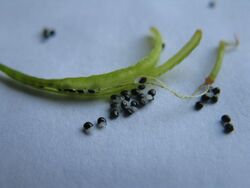
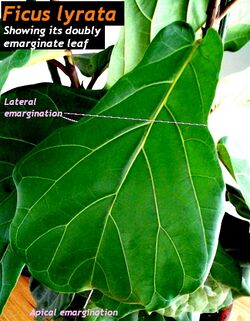
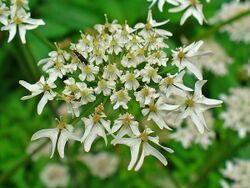
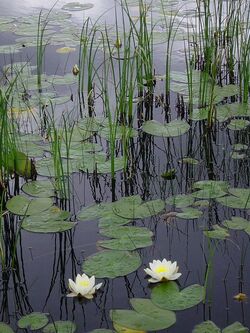
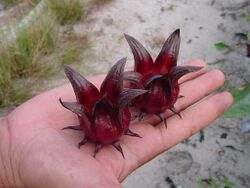
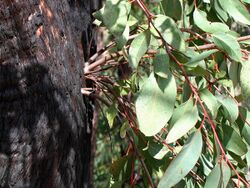
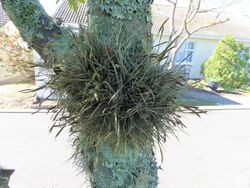
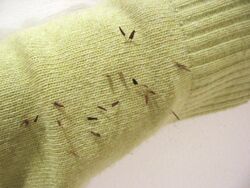
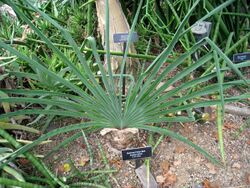
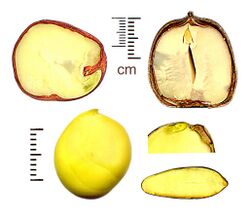
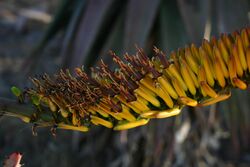
F
- A single cross; a plant breeding term for the result of a repeatable cross between two pure bred lines. <dt class="glossary " id="Lua error: Internal error: The interpreter has terminated with signal "24"." style="margin-top: 0.4em;">F2 hybrid
- A plant breeding term for the result of a plant arising from a cross between two F1 hybrids; may also refer to self-pollination in a population of F1 hybrids. <dt class="glossary " id="Lua error: Internal error: The interpreter has terminated with signal "24"." style="margin-top: 0.4em;">fabiform
- Shaped like a kidney bean. <dt class="glossary " id="Lua error: Internal error: The interpreter has terminated with signal "24"." style="margin-top: 0.4em;">facultative
- Able to perform a particular life function, or to live generally, in more than one way.[28] Compare obligate. <dt class="glossary " id="Lua error: Internal error: The interpreter has terminated with signal "24"." style="margin-top: 0.4em;">falcate
- Curved like the blade of a scythe. <dt class="glossary " id="Lua error: Internal error: The interpreter has terminated with signal "24"." style="margin-top: 0.4em;">family
- A taxonomic group of one or more genera with features, ancestry, or both in common. It is the term for the principal rank between order and genus. <dt class="glossary " id="Lua error: Internal error: The interpreter has terminated with signal "24"." style="margin-top: 0.4em;">farina
- Powdery, pale yellow, crystalline secretion consisting of flavonoids in Primula and other species. <dt class="glossary " id="Lua error: Internal error: The interpreter has terminated with signal "24"." style="margin-top: 0.4em;">farinaceous
- Powderiness that is mealy. <dt class="glossary " id="Lua error: Internal error: The interpreter has terminated with signal "24"." style="margin-top: 0.4em;">fascicle
Lua error: Internal error: The interpreter has terminated with signal "24".
A cluster of flowers, leaves, needles, vascular tissue, etc., e.g. a tuft of leaves all arising from the same node.
<dt class="glossary " id="Lua error: Internal error: The interpreter has terminated with signal "24"." style="margin-top: 0.4em;">fasciculate
- Branching in clusters, e.g. a bundle of sticks or needles; having fascicles. <dt class="glossary " id="Lua error: Internal error: The interpreter has terminated with signal "24"." style="margin-top: 0.4em;">fastigiate
- 1. In Plant morphology, the habit of a plant that consists in part, of a bundle of erect, more or less parallel branches or stems, particularly if they form or taper to a peak or point. (Latin fastigiatus,meaning "having a peak".
- 2. In palynology, the form of a pollen grain that has a fastigium, a pointed apex over a hollow between the layers of the pollen outer wall. <dt class="glossary " id="Lua error: Internal error: The interpreter has terminated with signal "24"." style="margin-top: 0.4em;">faucal
- Pertaining to the fauces; located in the throat of a calyx or corolla. <dt class="glossary " id="Lua error: Internal error: The interpreter has terminated with signal "24"." style="margin-top: 0.4em;">fauces
- The throat of a calyx or corolla; the conspicuously widened portion between the mouth and the apex of the tube. In Boraginaceae, the site of distinctive appendages. <dt class="glossary " id="Lua error: Internal error: The interpreter has terminated with signal "24"." style="margin-top: 0.4em;">faveolate
- Honeycombed; having regular, angled pits. Compare foveolate. <dt class="glossary " id="Lua error: Internal error: The interpreter has terminated with signal "24"." style="margin-top: 0.4em;">felted
- Having interlocked hairs to the extent of being matted.Lua error: Internal error: The interpreter has terminated with signal "24".Lua error: Internal error: The interpreter has terminated with signal "24". <dt class="glossary " id="Lua error: Internal error: The interpreter has terminated with signal "24"." style="margin-top: 0.4em;">female flower
- See pistillate flower. <dt class="glossary " id="Lua error: Internal error: The interpreter has terminated with signal "24"." style="margin-top: 0.4em;">fenestrate
- Having translucent or transparent areas that let light through; this variously affects the behavior of animal visitors or permits photosynthesis in many arid-region plants that grow only to the soil surface. Also refers loosely to perforations, for which perforate is the more precise term. <dt class="glossary " id="Lua error: Internal error: The interpreter has terminated with signal "24"." style="margin-top: 0.4em;">ferruginous
- Ruddy or rust-colored. <dt class="glossary " id="Lua error: Internal error: The interpreter has terminated with signal "24"." style="margin-top: 0.4em;">fertile
- Capable of producing fruit; of flowers when they produce seed, or of anthers containing pollen. <dt class="glossary " id="Lua error: Internal error: The interpreter has terminated with signal "24"." style="margin-top: 0.4em;">fertilization
- The union of male and female gametes during sexual reproduction. <dt class="glossary " id="Lua error: Internal error: The interpreter has terminated with signal "24"." style="margin-top: 0.4em;">fiber
- 1. A fiber cell.
- 2. Any flexible, strong, stringy, and very elongate structure. <dt class="glossary " id="Lua error: Internal error: The interpreter has terminated with signal "24"." style="margin-top: 0.4em;">fiber cell
- A type of cell that is found in sclerenchyma; it is much elongated, and dies soon after an extensive modification of its cell wall. The cell wall is usually thickly lignified but is sometimes gelatinous. <dt class="glossary " id="Lua error: Internal error: The interpreter has terminated with signal "24"." style="margin-top: 0.4em;">filament
- 1. The stalk of a stamen.
- 2. Any very narrow, thread-like structure that is one or a few cells thick. <dt class="glossary " id="Lua error: Internal error: The interpreter has terminated with signal "24"." style="margin-top: 0.4em;">filamentous
- Consisting of filaments or fibers; hairlike. <dt class="glossary " id="Lua error: Internal error: The interpreter has terminated with signal "24"." style="margin-top: 0.4em;">filiform
- Thread-like, e.g. stamen filaments or leaf shapes. <dt class="glossary " id="Lua error: Internal error: The interpreter has terminated with signal "24"." style="margin-top: 0.4em;">fimbria
Lua error: Internal error: The interpreter has terminated with signal "24".
Slender, hair-like projection; fringe.
<dt class="glossary " id="Lua error: Internal error: The interpreter has terminated with signal "24"." style="margin-top: 0.4em;">fimbriate
- Fringed, e.g. where the ends of a petal are split into two or more divisions.[29] Having fimbriae. <dt class="glossary " id="Lua error: Internal error: The interpreter has terminated with signal "24"." style="margin-top: 0.4em;">fissure
- A split or crack, often referring to fissured bark; a line or opening of dehiscence. <dt class="glossary " id="Lua error: Internal error: The interpreter has terminated with signal "24"." style="margin-top: 0.4em;">fistule
- A tube-shaped cavity. <dt class="glossary " id="Lua error: Internal error: The interpreter has terminated with signal "24"." style="margin-top: 0.4em;">fistulose
- Hollow; usually applied to a tube-shaped cavity, as in a reed. <dt class="glossary " id="Lua error: Internal error: The interpreter has terminated with signal "24"." style="margin-top: 0.4em;">flabellate
- Fan-shaped, e.g. a flabellate (fan-shaped) leaf. <dt class="glossary " id="Lua error: Internal error: The interpreter has terminated with signal "24"." style="margin-top: 0.4em;">flaccid
- Limp; tending to wilt. Compare turgid. <dt class="glossary " id="Lua error: Internal error: The interpreter has terminated with signal "24"." style="margin-top: 0.4em;">flexistyly
- Depending on the degree of maturation of the stamens, the style moves up or down (cataflexistyle or (ana-)hyperflexisyle). <dt class="glossary " id="Lua error: Internal error: The interpreter has terminated with signal "24"." style="margin-top: 0.4em;">flexuous <dt class="glossary " id="Lua error: Internal error: The interpreter has terminated with signal "24"." style="margin-top: -0.2em;">flexuose
- Bent alternately in different directions; zigzag. <dt class="glossary " id="Lua error: Internal error: The interpreter has terminated with signal "24"." style="margin-top: 0.4em;">floccose
- Having a soft and wooly covering of hairs. <dt class="glossary " id="Lua error: Internal error: The interpreter has terminated with signal "24"." style="margin-top: 0.4em;">flora
- 1. All the plants growing in a certain region or country.
- 2. An enumeration of them, generally with a guide to their identification (e.g. the Flora of North America, Flora of China, Flora of Victoria, Flora of New South Wales, and so on). In this case, flora is written with a capital F. <dt class="glossary " id="Lua error: Internal error: The interpreter has terminated with signal "24"." style="margin-top: 0.4em;">floral envelope
- See perianth. <dt class="glossary " id="Lua error: Internal error: The interpreter has terminated with signal "24"." style="margin-top: 0.4em;">floral leaves
- The upper leaves at the base of the flowering branches. <dt class="glossary " id="Lua error: Internal error: The interpreter has terminated with signal "24"." style="margin-top: 0.4em;">floral diagram
- A graphical means to describe flower structure, usually a schematic cross-section through a young flower. <dt class="glossary " id="Lua error: Internal error: The interpreter has terminated with signal "24"." style="margin-top: 0.4em;">floral formula
- A description of flower structure using numbers, letters, and various symbols. <dt class="glossary " id="Lua error: Internal error: The interpreter has terminated with signal "24"." style="margin-top: 0.4em;">floral tube
- An imprecise term sometimes used as a synonym of hypanthium, corolla tube, or calyx tube. <dt class="glossary " id="Lua error: Internal error: The interpreter has terminated with signal "24"." style="margin-top: 0.4em;">floret
- A small flower, usually referring to the individual true flowers clustered within an inflorescence, particularly those of the Poaceae grasses and the pseudanthia of family Asteraceae. <dt class="glossary " id="Lua error: Internal error: The interpreter has terminated with signal "24"." style="margin-top: 0.4em;">flower
- The sexual reproductive structure of the angiosperms, typically with a gynoecium, androecium, perianth, and an axis. <dt class="glossary " id="Lua error: Internal error: The interpreter has terminated with signal "24"." style="margin-top: 0.4em;">foliate
- Preceded by a number to signify having a certain number of leaflets, e.g. 3-foliate means "having three leaflets". <dt class="glossary " id="Lua error: Internal error: The interpreter has terminated with signal "24"." style="margin-top: 0.4em;">foliicolous
- A growth habit of certain lichens, algae, and fungi that prefer to grow on the leaves of vascular plants. <dt class="glossary " id="Lua error: Internal error: The interpreter has terminated with signal "24"." style="margin-top: 0.4em;">follicle
- A dry fruit formed from one carpel splitting along a single suture to which the seeds are attached, e.g. from the pod of a legume.Lua error: Internal error: The interpreter has terminated with signal "24".Lua error: Internal error: The interpreter has terminated with signal "24". <dt class="glossary " id="Lua error: Internal error: The interpreter has terminated with signal "24"." style="margin-top: 0.4em;">foliole
- A small, leaf-like appendage on the front or back.Template:Of what <dt class="glossary " id="Lua error: Internal error: The interpreter has terminated with signal "24"." style="margin-top: 0.4em;">foliose
- Leaf-like; flattened like a leaf. <dt class="glossary " id="Lua error: Internal error: The interpreter has terminated with signal "24"." style="margin-top: 0.4em;">forb
- Any non-woody flowering plant that is not a grass, sedge, or rush. <dt class="glossary " id="Lua error: Internal error: The interpreter has terminated with signal "24"." style="margin-top: 0.4em;">forest
- Vegetation dominated by trees with single trunks, including closely arranged trees with or without an understory of shrubs and herbs. <dt class="glossary " id="Lua error: Internal error: The interpreter has terminated with signal "24"." style="margin-top: 0.4em;">forma (in common usage, form)
- A taxonomic category subordinate to species and within the taxonomic hierarchy, below variety (varietas), and usually differentiated by a minor character. <dt class="glossary " id="Lua error: Internal error: The interpreter has terminated with signal "24"." style="margin-top: 0.4em;">foveolate
- Having regular tiny pits. Compare faveolate. <dt class="glossary " id="Lua error: Internal error: The interpreter has terminated with signal "24"." style="margin-top: 0.4em;">free
- Not united with other organs of the same type; not attached at one end. <dt class="glossary " id="Lua error: Internal error: The interpreter has terminated with signal "24"." style="margin-top: 0.4em;">free central
- (of placentation) Ovules attached to a free-standing column in the center of a unilocular ovary. <dt class="glossary " id="Lua error: Internal error: The interpreter has terminated with signal "24"." style="margin-top: 0.4em;">frond
- A leaf of a fern, cycad, or palm. <dt class="glossary " id="Lua error: Internal error: The interpreter has terminated with signal "24"." style="margin-top: 0.4em;">frutescent
- Shrub-like (fruticose) or becoming shrub-like. <dt class="glossary " id="Lua error: Internal error: The interpreter has terminated with signal "24"." style="margin-top: 0.4em;">fruticose
- Shrubby; having the branching character of a shrub. <dt class="glossary " id="Lua error: Internal error: The interpreter has terminated with signal "24"." style="margin-top: 0.4em;">fruit
- A seed-bearing structure, present in all angiosperms, formed from the mature ovary and sometimes associated floral parts upon fertilization. <dt class="glossary " id="Lua error: Internal error: The interpreter has terminated with signal "24"." style="margin-top: 0.4em;">fugacious
- Disappearing, falling off, or withering. Compare persistent and caducous. <dt class="glossary " id="Lua error: Internal error: The interpreter has terminated with signal "24"." style="margin-top: 0.4em;">funicle (funiculus)
- The stalk of an ovule. <dt class="glossary " id="Lua error: Internal error: The interpreter has terminated with signal "24"." style="margin-top: 0.4em;">funnelform
- Having a form gradually widening from the base to the apex; funnel-shaped. <dt class="glossary " id="Lua error: Internal error: The interpreter has terminated with signal "24"." style="margin-top: 0.4em;">furcate
- Forked, usually applied to a terminal division; with two long lobes. <dt class="glossary " id="Lua error: Internal error: The interpreter has terminated with signal "24"." style="margin-top: 0.4em;">fused
- Joined together. <dt class="glossary " id="Lua error: Internal error: The interpreter has terminated with signal "24"." style="margin-top: 0.4em;">fusiform
- Rod-shaped and narrowing gradually from the middle toward each end; spindle-shaped.
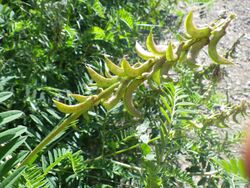
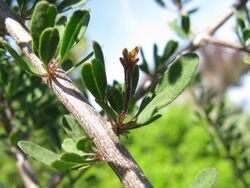

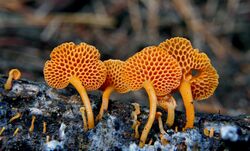

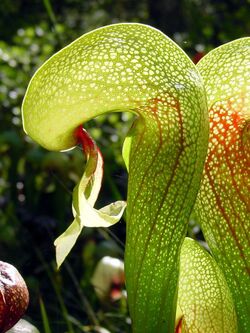

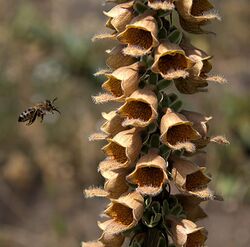
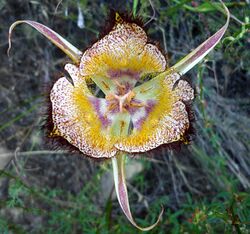
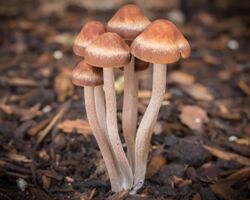
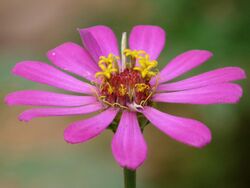
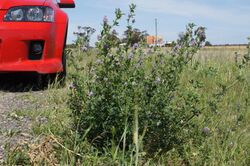
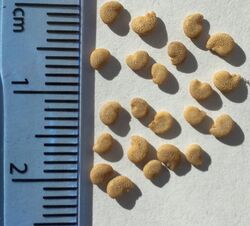
G
- In gymnosperms, a fleshy cone (megastrobilus); chiefly relates to cones borne by junipers and cypresses, which are often mistakenly called berries. <dt class="glossary " id="Lua error: Internal error: The interpreter has terminated with signal "24"." style="margin-top: 0.4em;">galea
- An overhanging, helmet-shaped, structure that protects the reproductive parts from precipitation, wind or unwanted visitors. <dt class="glossary " id="Lua error: Internal error: The interpreter has terminated with signal "24"." style="margin-top: 0.4em;">gall
- Abnormal outgrowth on external plant tissues, caused by various parasites, from viruses, fungi and bacteria, to other plants, insects and mites. <dt class="glossary " id="Lua error: Internal error: The interpreter has terminated with signal "24"." style="margin-top: 0.4em;">gamete
- A cell or nucleus that fuses with another of the opposite sex during sexual reproduction. <dt class="glossary " id="Lua error: Internal error: The interpreter has terminated with signal "24"." style="margin-top: 0.4em;">gametophore
- Specialized structures on the gametophytes of some bryophyte species, for example many species in the order Marchantiales; in such species the gametes are produced on the gametophores. <dt class="glossary " id="Lua error: Internal error: The interpreter has terminated with signal "24"." style="margin-top: 0.4em;">gametophyte
- The haploid multicellular phase in the alternation of generations of plants and algae that bears gametes. In bryophytes the gametophyte is the dominant vegetative phase; in ferns and their allies it is a small free-living plant known as the prothallus; in gymnosperms and angiosperms the gametophytes are reduced to microscopic structures dependent on the sporophyte, male gametophytes contained in pollen grains and females contained within the ovules. <dt class="glossary " id="Lua error: Internal error: The interpreter has terminated with signal "24"." style="margin-top: 0.4em;">gamopetalous
- with joined or fused petals <dt class="glossary " id="Lua error: Internal error: The interpreter has terminated with signal "24"." style="margin-top: 0.4em;">gamophyllous
- a single perianth-whorl of united segments. Compare symphyllous (synonym), apophyllous, and polyphyllous. <dt class="glossary " id="Lua error: Internal error: The interpreter has terminated with signal "24"." style="margin-top: 0.4em;">gemma
- an asexual reproductive structure found in liverworts and mosses. <dt class="glossary " id="Lua error: Internal error: The interpreter has terminated with signal "24"." style="margin-top: 0.4em;">gene pool
- The complete range of genetic variation found within a population. <dt class="glossary " id="Lua error: Internal error: The interpreter has terminated with signal "24"." style="margin-top: 0.4em;">genus
Lua error: Internal error: The interpreter has terminated with signal "24".
A group of one or more species with features or ancestry (or both) in common. Genus is the principal category of taxa intermediate in rank between family and species in the standard nomenclatural hierarchy.
<dt class="glossary " id="Lua error: Internal error: The interpreter has terminated with signal "24"." style="margin-top: 0.4em;">generic name
- The name of a taxonomic genus, such as Acacia and Eucalyptus. <dt class="glossary " id="Lua error: Internal error: The interpreter has terminated with signal "24"." style="margin-top: 0.4em;">genotype
- The genetic make-up of an individual. <dt class="glossary " id="Lua error: Internal error: The interpreter has terminated with signal "24"." style="margin-top: 0.4em;">geophilous
- Growing or rooting in the ground. <dt class="glossary " id="Lua error: Internal error: The interpreter has terminated with signal "24"." style="margin-top: 0.4em;">germination
- 1. of seeds, describing the complex sequence of physiological and structural changes that occur from resting to growth stage.
- 2. of a pollen grain; production of a pollen tube when contacting a stigma receptive to it.
- 3. of a spore of fungi/bacterium; change of state – from resting to vegetative. <dt class="glossary " id="Lua error: Internal error: The interpreter has terminated with signal "24"." style="margin-top: 0.4em;">gibbous (gibbose)
- (of part of an organ) Swollen, usually with a pouch-like enlargement at the base. <dt class="glossary " id="Lua error: Internal error: The interpreter has terminated with signal "24"." style="margin-top: 0.4em;">glabrescent
- Becoming glabrous, almost glabrous; glabrate. <dt class="glossary " id="Lua error: Internal error: The interpreter has terminated with signal "24"." style="margin-top: 0.4em;">glabrous
- Lacking surface ornamentation such as hairs, scales or bristles; smooth. <dt class="glossary " id="Lua error: Internal error: The interpreter has terminated with signal "24"." style="margin-top: 0.4em;">gland
- A secretory structure within or on the surface of a plant. <dt class="glossary " id="Lua error: Internal error: The interpreter has terminated with signal "24"." style="margin-top: 0.4em;">glandular hair
- A hair tipped with a gland. <dt class="glossary " id="Lua error: Internal error: The interpreter has terminated with signal "24"." style="margin-top: 0.4em;">glaucous
- Describing the external surface of a plant part that has a whitish covering, in some cases with a blueish cast. Often applied to plants with a wooly or arachnoid surface, but properly referring to pruinose surfaces, meaning those with a waxy bloom. The surfaces of the young leaves of many eucalypts provide good examples, and so do some xerophytes. <dt class="glossary " id="Lua error: Internal error: The interpreter has terminated with signal "24"." style="margin-top: 0.4em;">globose
Lua error: Internal error: The interpreter has terminated with signal "24".
Roughly spherical. See also subglobose.
<dt class="glossary " id="Lua error: Internal error: The interpreter has terminated with signal "24"." style="margin-top: 0.4em;">globulose
- Approximately spherical. <dt class="glossary " id="Lua error: Internal error: The interpreter has terminated with signal "24"." style="margin-top: 0.4em;">glochid
- A tiny barbed hair or bristle, e.g. the fine defensive hairs in cactus species such as Opuntia. <dt class="glossary " id="Lua error: Internal error: The interpreter has terminated with signal "24"." style="margin-top: 0.4em;">glumes
- bracts subtending the floret(s) of a sedge, or similar plant; in grasses forming the lowermost organs of a spikelet (there are usually 2 but 1 is sometimes reduced; or rarely, both are absent). <dt class="glossary " id="Lua error: Internal error: The interpreter has terminated with signal "24"." style="margin-top: 0.4em;">glutinous
- Sticky. <dt class="glossary " id="Lua error: Internal error: The interpreter has terminated with signal "24"." style="margin-top: 0.4em;">graft
- 1. The artificial union of plant parts.
- 2. A plant shoot suitable for grafting; loosely, a scion, sucker, or branch. <dt class="glossary " id="Lua error: Internal error: The interpreter has terminated with signal "24"." style="margin-top: 0.4em;">graft chimaera (sometimes graft hybrid)
- A taxon whose members consist of tissue from two or more different plants in intimate association originated by grafting. The addition sign "+" is used to indicate a graft-chimaera either as a part of a formula (e.g. Crataegus monogyna + Mespilus germanica) or in front of an abbreviated name (e.g. + Crataegomespilus 'Dardari'). The nomenclature of graft hybrids is governed by the International Code of Nomenclature for Cultivated Plants. <dt class="glossary " id="Lua error: Internal error: The interpreter has terminated with signal "24"." style="margin-top: 0.4em;">graminaceous
Lua error: Internal error: The interpreter has terminated with signal "24".
Of or relating to grass.
<dt class="glossary " id="Lua error: Internal error: The interpreter has terminated with signal "24"." style="margin-top: 0.4em;">graminoid
- An herbaceous plant with a grass-like morphology. <dt class="glossary " id="Lua error: Internal error: The interpreter has terminated with signal "24"." style="margin-top: 0.4em;">granular
- (of a surface) Covered with small rounded protuberances. <dt class="glossary " id="Lua error: Internal error: The interpreter has terminated with signal "24"." style="margin-top: 0.4em;">grass
- A plant of the family Poaceae. <dt class="glossary " id="Lua error: Internal error: The interpreter has terminated with signal "24"." style="margin-top: 0.4em;">grassland
- Low vegetation dominated by grasses. <dt class="glossary " id="Lua error: Internal error: The interpreter has terminated with signal "24"." style="margin-top: 0.4em;">groundcover
- 1. Dense vegetation that covers the ground.
- 2. A term applied to describe a plant that covers the soil surface so densely that it smothers all beneath it. <dt class="glossary " id="Lua error: Internal error: The interpreter has terminated with signal "24"." style="margin-top: 0.4em;">group
- A formal category equivalent to or below the rank of genus which distinguishes
- an assemblage of two or more cultivars within a species or hybrid;
- plants derived from a hybrid in which one or more of the parent species is not known or is of uncertain origin; or,
- a range of cultivated plants of a species or hybrid which may exhibit variation but share one or more characters, which makes it worth distinguishing them as a unit.
<dt class="glossary " id="Lua error: Internal error: The interpreter has terminated with signal "24"." style="margin-top: 0.4em;">guard cell
- Each of two cells surrounding the stoma which control gas exchange between the apoplast of the plant and the external environment. <dt class="glossary " id="Lua error: Internal error: The interpreter has terminated with signal "24"." style="margin-top: 0.4em;">guttate
- Having droplet-shaped spots. Compare punctate and maculate. <dt class="glossary " id="Lua error: Internal error: The interpreter has terminated with signal "24"." style="margin-top: 0.4em;">guttation
- The secretion of liquid water from uninjured plant parts. See hydathode. <dt class="glossary " id="Lua error: Internal error: The interpreter has terminated with signal "24"." style="margin-top: 0.4em;">guttulate
- Having or appearing to be spotted with oil droplets; of spores, having oil droplets inside. <dt class="glossary " id="Lua error: Internal error: The interpreter has terminated with signal "24"." style="margin-top: 0.4em;">gymnosperm
- A seed-bearing plant with unenclosed ovules borne on the surface of a sporophyll. Gymnosperms are among the oldest clades of vascular plants, and today are represented by approximately 1,000 extant species worldwide, including, among others, conifers, Ginkgo, Gnetum and cycads. Compare angiosperm. <dt class="glossary " id="Lua error: Internal error: The interpreter has terminated with signal "24"." style="margin-top: 0.4em;">gynaecium
- Alternative term for gynoecium, but with partly different etymology. <dt class="glossary " id="Lua error: Internal error: The interpreter has terminated with signal "24"." style="margin-top: 0.4em;">gynobasic
- Of a style, arising near the base of the gynoecium, e.g. between the lobes of the ovary. <dt class="glossary " id="Lua error: Internal error: The interpreter has terminated with signal "24"." style="margin-top: 0.4em;">gynodioecious
- Of a species, with some plants bearing only bisexual flowers and others bearing only female flowers. <dt class="glossary " id="Lua error: Internal error: The interpreter has terminated with signal "24"." style="margin-top: 0.4em;">gynomonoecious
- Of a species, with bisexual flowers and female flowers on the same plant. <dt class="glossary " id="Lua error: Internal error: The interpreter has terminated with signal "24"." style="margin-top: 0.4em;">gynoecium
- The collective term for the female reproductive parts of a flower or for the carpels of a flower, whether united or free. Contrast androecium. Abbreviation: G. For instance, G indicates a superior ovary; G(5) indicates having five fused carpels. <dt class="glossary " id="Lua error: Internal error: The interpreter has terminated with signal "24"." style="margin-top: 0.4em;">gynophore
- A stalk supporting the gynoecium and situated above the level of insertion of the other floral parts. <dt class="glossary " id="Lua error: Internal error: The interpreter has terminated with signal "24"." style="margin-top: 0.4em;">gynostegium
- A compound organ in milkweeds (Asclepiadaceae) and orchids formed by fusion of the filaments of the stamens with the style. Also known as the column.
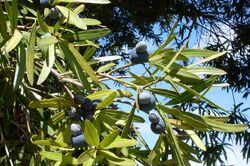
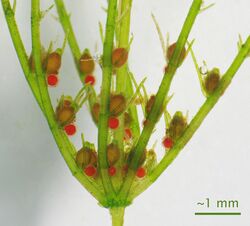
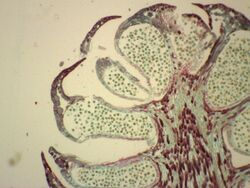
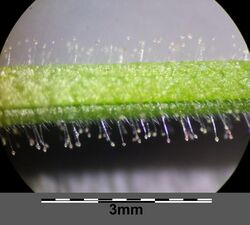
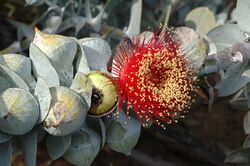
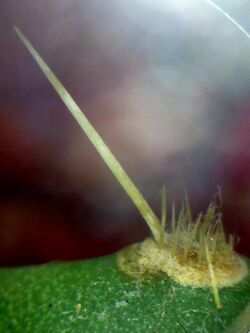
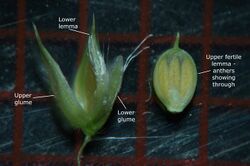
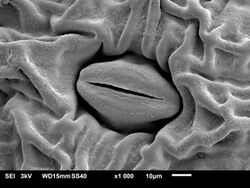
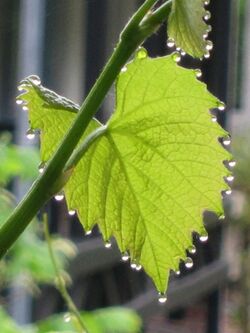
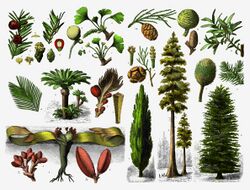
1-Welwitschia mirabilis
2-Cycas revoluta
3-Taxus baccata
4-Ginkgo biloba
RIGHT
1-Cupressus sempervirens
2-Sequoiadendron giganteum
3-Agathis dammara
4-Araucaria heterophylla
H
- The general external appearance of a plant, including size, shape, texture, and orientation. <dt class="glossary " id="Lua error: Internal error: The interpreter has terminated with signal "24"." style="margin-top: 0.4em;">habitat
- The place where a plant lives; the environmental conditions of its home. <dt class="glossary " id="Lua error: Internal error: The interpreter has terminated with signal "24"." style="margin-top: 0.4em;">hair
- A single elongated cell or row of cells borne on the surface of an organ. <dt class="glossary " id="Lua error: Internal error: The interpreter has terminated with signal "24"." style="margin-top: 0.4em;">half-inferior ovary
- An ovary partly below and partly above the level of attachment of the other floral parts. Compare inferior ovary and superior ovary. <dt class="glossary " id="Lua error: Internal error: The interpreter has terminated with signal "24"." style="margin-top: 0.4em;">halonate
- Having a transparent coating, or being of a spore's outer layer. <dt class="glossary " id="Lua error: Internal error: The interpreter has terminated with signal "24"." style="margin-top: 0.4em;">halophyte
- A plant adapted to living in highly saline habitats; a plant that accumulates high concentrations of salt in its tissues. <dt class="glossary " id="Lua error: Internal error: The interpreter has terminated with signal "24"." style="margin-top: 0.4em;">hand-pollination
- The controlled act of pollination that excludes the possibility of open-pollination. <dt class="glossary " id="Lua error: Internal error: The interpreter has terminated with signal "24"." style="margin-top: 0.4em;">haploid
- Having one set of chromosomes, e.g. the complement of chromosomes in each of the cells of the gametophyte, the nucleus of a gamete, and the spores. This is expressed symbolically as n, where n = the gametic number of chromosomes. Compare diploid, triploid, and tetraploid. <dt class="glossary " id="Lua error: Internal error: The interpreter has terminated with signal "24"." style="margin-top: 0.4em;">haplostemonous
- Having a single series of stamens equal in number to the proper number of petals, and alternating with them. Compare diplostemonous and obdiplostemonous. <dt class="glossary " id="Lua error: Internal error: The interpreter has terminated with signal "24"." style="margin-top: 0.4em;">harmomegathy
- process by which pollen grains in arid environments close off their apertures to avoid losing water <dt class="glossary " id="Lua error: Internal error: The interpreter has terminated with signal "24"." style="margin-top: 0.4em;">hastate
- Triangular in outline, the basal lobes pointing outward, so that the base appears truncate; may refer only to the base of a leaf with such lobes. Compare sagittate, which refers to basal lobes pointing backward. <dt class="glossary " id="Lua error: Internal error: The interpreter has terminated with signal "24"." style="margin-top: 0.4em;">haustorium
- In parasitic plants, a structure developed for penetrating the host's tissues. <dt class="glossary " id="Lua error: Internal error: The interpreter has terminated with signal "24"." style="margin-top: 0.4em;">head
- See capitulum, a pseudanthium. <dt class="glossary " id="Lua error: Internal error: The interpreter has terminated with signal "24"." style="margin-top: 0.4em;">heathland
- Vegetation dominated by small shrubs which usually have ericoid leaves. <dt class="glossary " id="Lua error: Internal error: The interpreter has terminated with signal "24"." style="margin-top: 0.4em;">helicoid
- Coiled; of a cymose inflorescence, when the branching is repeatedly on the same side (the apex is often recurved). Compare scorpioid. <dt class="glossary " id="Lua error: Internal error: The interpreter has terminated with signal "24"." style="margin-top: 0.4em;">heliophilous
- Requiring or tolerating strong, direct sunlight. <dt class="glossary " id="Lua error: Internal error: The interpreter has terminated with signal "24"." style="margin-top: 0.4em;">hemerochory
- A plant that has been transported voluntarily or involuntarily by humans in a territory which it could not have colonized by its own natural mechanisms of dissemination, or at least much more slowly.Lua error: Internal error: The interpreter has terminated with signal "24".Lua error: Internal error: The interpreter has terminated with signal "24". <dt class="glossary " id="Lua error: Internal error: The interpreter has terminated with signal "24"." style="margin-top: 0.4em;">hemi-legume
- A legume fruit in which the seed or seeds and one valve of the pod are dispersed as a unit. The valve catches the wind and blows away with the seeds, as in Acacia tenuifolia and Peltogyne paniculata. <dt class="glossary " id="Lua error: Internal error: The interpreter has terminated with signal "24"." style="margin-top: 0.4em;">herb
- Any vascular plant that does not develop a woody stem at any point during its life cycle, e.g. a daffodil. <dt class="glossary " id="Lua error: Internal error: The interpreter has terminated with signal "24"." style="margin-top: 0.4em;">herbaceous
- Not woody; usually green and soft in texture. <dt class="glossary " id="Lua error: Internal error: The interpreter has terminated with signal "24"." style="margin-top: 0.4em;">herbarium
Lua error: Internal error: The interpreter has terminated with signal "24".
A collection of preserved, usually pressed and dried, plant material used for identification and comparison; also a building in which such collections are stored.
<dt class="glossary " id="Lua error: Internal error: The interpreter has terminated with signal "24"." style="margin-top: 0.4em;">hermaphrodite
- A synonym of bisexual. <dt class="glossary " id="Lua error: Internal error: The interpreter has terminated with signal "24"." style="margin-top: 0.4em;">hesperidium
- A form of berry that occurs most familiarly in the genus Citrus. The fruit tends to be large for a berry, ranging from not much more than a centimeter in small fruited genera such as Murraya, to 15 cm or more in some varieties of Citrus. The outer rind typically is thick and tough with many oil glands, while the carpels within are packed with juicy fibers. <dt class="glossary " id="Lua error: Internal error: The interpreter has terminated with signal "24"." style="margin-top: 0.4em;">heteroblastic
- Having parts, especially leaves, that are distinctly different between the juvenile and adult stages. <dt class="glossary " id="Lua error: Internal error: The interpreter has terminated with signal "24"." style="margin-top: 0.4em;">heteromorphic
- Having two or more distinct morphologies (e.g. of different size and shape). Compare isomorphic. <dt class="glossary " id="Lua error: Internal error: The interpreter has terminated with signal "24"." style="margin-top: 0.4em;">heterospory
- The production of spores of two different sizes (small and large) by the sporophytes of land plants. Compare homospory. <dt class="glossary " id="Lua error: Internal error: The interpreter has terminated with signal "24"." style="margin-top: 0.4em;">heterostyly
- The condition of a species having flowers with different style and stamen lengths, but with all the flowers of any one plant being identical. See distyly. <dt class="glossary " id="Lua error: Internal error: The interpreter has terminated with signal "24"." style="margin-top: 0.4em;">hilum
- The scar on a seed coat where it separates from its stalk (funicle). <dt class="glossary " id="Lua error: Internal error: The interpreter has terminated with signal "24"." style="margin-top: 0.4em;">hip
- The fruit of a rose plant. <dt class="glossary " id="Lua error: Internal error: The interpreter has terminated with signal "24"." style="margin-top: 0.4em;">hippocrepiform
- Horseshoe-shaped. <dt class="glossary " id="Lua error: Internal error: The interpreter has terminated with signal "24"." style="margin-top: 0.4em;">hirsute
- Bearing coarse, rough, longish hairs. See indumentum. <dt class="glossary " id="Lua error: Internal error: The interpreter has terminated with signal "24"." style="margin-top: 0.4em;">hispid
- Bearing long, erect, rigid hairs or bristles, harsh to touch. <dt class="glossary " id="Lua error: Internal error: The interpreter has terminated with signal "24"." style="margin-top: 0.4em;">hoary
- Covered with a greyish to whitish layer of very short, closely interwoven hairs, giving a frosted appearance. <dt class="glossary " id="Lua error: Internal error: The interpreter has terminated with signal "24"." style="margin-top: 0.4em;">holotype
- A type chosen by the author of a name. Compare lectotype. <dt class="glossary " id="Lua error: Internal error: The interpreter has terminated with signal "24"." style="margin-top: 0.4em;">homochlamydeous
- Having a perianth which is not divided into a separate calyx and corolla. Contrast dichlamydeous. <dt class="glossary " id="Lua error: Internal error: The interpreter has terminated with signal "24"." style="margin-top: 0.4em;">homospory
- The production of spores of only one size by the sporophytes of land plants. Compare heterospory. <dt class="glossary " id="Lua error: Internal error: The interpreter has terminated with signal "24"." style="margin-top: 0.4em;">hort.
Lua error: Internal error: The interpreter has terminated with signal "24".
Of gardens, an author citation used in two ways:
1. as a name misapplied by gardeners- 2. as an invalid name derived from horticultural writings of confused authorship. <dt class="glossary " id="Lua error: Internal error: The interpreter has terminated with signal "24"." style="margin-top: 0.4em;">husk
- Protective outer covering of certain seeds, for example, the leafy outer covering of an ear of maize (corn), the leathery covering of the walnut, or the spiky covering of the chestnut. <dt class="glossary " id="Lua error: Internal error: The interpreter has terminated with signal "24"." style="margin-top: 0.4em;">hyaline
- Translucent; usually delicately membranous and colorless. <dt class="glossary " id="Lua error: Internal error: The interpreter has terminated with signal "24"." style="margin-top: 0.4em;">hybrid
- Plant produced by the crossing of parents belonging to two different named groups, e.g. genera, species, varieties, subspecies, forma and so on; i.e. the progeny resulting within and between two different plants. An F1 hybrid is the primary product of such a cross. An F2 hybrid is a plant arising from a cross between two F1 hybrids (or from the self-pollination of an F1 hybrid). <dt class="glossary " id="Lua error: Internal error: The interpreter has terminated with signal "24"." style="margin-top: 0.4em;">hybrid formula
- The names of the parents of a hybrid joined by a multiplication sign, e.g. Cytisus ardonoi × C. purgans. <dt class="glossary " id="Lua error: Internal error: The interpreter has terminated with signal "24"." style="margin-top: 0.4em;">hydrophily
- Form of pollination whereby pollen is distributed by the flow of waters. <dt class="glossary " id="Lua error: Internal error: The interpreter has terminated with signal "24"." style="margin-top: 0.4em;">hypanthium
- Tube or cup-like structure in a flower that includes the bases of sepals, petals, and stamens, and may or may not be connected (adnate) to the ovary. <dt class="glossary " id="Lua error: Internal error: The interpreter has terminated with signal "24"." style="margin-top: 0.4em;">hyper-resupinate
- In botany, describing leaves or flowers that are in the usual position but are borne on a petiole or pedicel that is twisted 360 degrees. The term is used to describe organs, such as orchid flowers, that are usually resupinate. Compare resupinate. <dt class="glossary " id="Lua error: Internal error: The interpreter has terminated with signal "24"." style="margin-top: 0.4em;">hypocarpium
- Enlarged fleshy structure that forms below the fruit from the receptacle or hypanthium. <dt class="glossary " id="Lua error: Internal error: The interpreter has terminated with signal "24"." style="margin-top: 0.4em;">hypocotyl
- Of an embryo or seedling, the part of the plant axis below the cotyledon and node, but above the root. It marks the transition from root to stem development. <dt class="glossary " id="Lua error: Internal error: The interpreter has terminated with signal "24"." style="margin-top: 0.4em;">hypocrateriform
- Salver-shaped. Synonym of salverform. From Greek Lua error: Internal error: The interpreter has terminated with signal "24".: a vessel. <dt class="glossary " id="Lua error: Internal error: The interpreter has terminated with signal "24"." style="margin-top: 0.4em;">hypogynous
- Borne below the ovary; used to describe floral parts inserted below the ovary's level of insertion. Compare epigynous and perigynous. <dt class="glossary " id="Lua error: Internal error: The interpreter has terminated with signal "24"." style="margin-top: 0.4em;">hysteranthous
- Type of growth in which new leaves appear after flowering. Also spelled histeranthous. Compare proteranthous and synanthous.
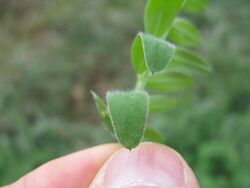
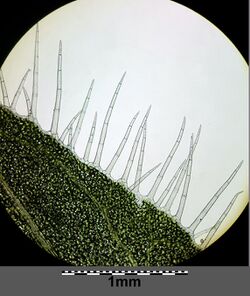
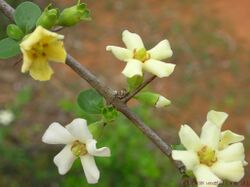
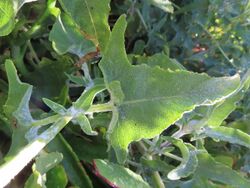
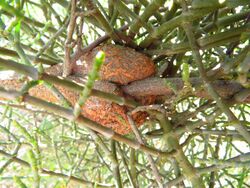

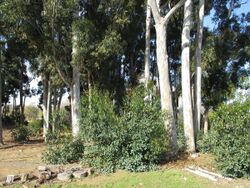
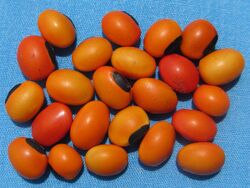
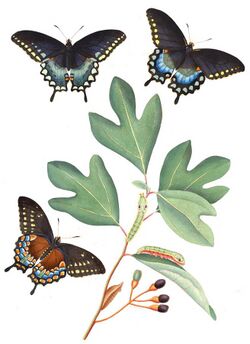
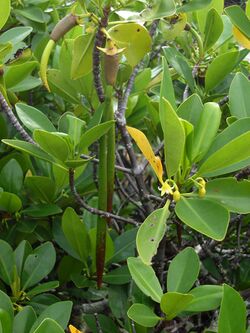
I
- A cell, especially of a leaf, differing markedly from surrounding cells. They often synthesise specialized products such as crystals. <dt class="glossary " id="Lua error: Internal error: The interpreter has terminated with signal "24"." style="margin-top: 0.4em;">illegitimate name (nomen illeg.)
- A name not abiding by the rules of the botanical Codes, e.g. later homonyms, cultivars that have been Latinised after 1 Jan 1959; cultivar names with more than 10 syllables or 30 letters; cultivar names that use confusing names of other plants, e.g. Camellia 'Rose'. <dt class="glossary " id="Lua error: Internal error: The interpreter has terminated with signal "24"." style="margin-top: 0.4em;">imbricate
- From the Latin for "tiled". Overlapping each other; of perianth parts, edges overlapping in the bud (the convoluted arrangement is a special form of imbrication). Dormant buds of many deciduous species are imbricately covered with protective cataphylls called bud scales. Compare with subimbricates meaning lightly overlapping <dt class="glossary " id="Lua error: Internal error: The interpreter has terminated with signal "24"." style="margin-top: 0.4em;">imparipinnate
- A pinnate leaf with an odd number of pinnae (terminated by a single leaflet). Compare paripinnate. <dt class="glossary " id="Lua error: Internal error: The interpreter has terminated with signal "24"." style="margin-top: 0.4em;">in
- In nomenclature, where the preceding author published the name in an article or book, authored or edited by the succeeding author. <dt class="glossary " id="Lua error: Internal error: The interpreter has terminated with signal "24"." style="margin-top: 0.4em;">-inae
- The suffix added to the stem of a generic name to form the name of a subtribe: for instance, Corydalinae from Corydalis + -inae. <dt class="glossary " id="Lua error: Internal error: The interpreter has terminated with signal "24"." style="margin-top: 0.4em;">inbreeding
- The production of offspring between closely related parents leading to a high degree of similarity; self-fertilization is the most intense form of inbreeding. <dt class="glossary " id="Lua error: Internal error: The interpreter has terminated with signal "24"." style="margin-top: 0.4em;">incertae sedis
- Of unknown taxonomic affinity; relationships obscure. <dt class="glossary " id="Lua error: Internal error: The interpreter has terminated with signal "24"." style="margin-top: 0.4em;">incised
- Cut deeply and (usually) unevenly (a condition intermediate between toothed and lobed). <dt class="glossary " id="Lua error: Internal error: The interpreter has terminated with signal "24"." style="margin-top: 0.4em;">included
- Enclosed, not protruding, e.g. stamens within the corolla. <dt class="glossary " id="Lua error: Internal error: The interpreter has terminated with signal "24"." style="margin-top: 0.4em;">incomplete flower
- A flower which lacks one or more of its usual parts, such as carpels, sepals, petals, pistils, or stamens. <dt class="glossary " id="Lua error: Internal error: The interpreter has terminated with signal "24"." style="margin-top: 0.4em;">incurved
- Bent or curved inward; of leaf margins, when curved toward the adaxial side. <dt class="glossary " id="Lua error: Internal error: The interpreter has terminated with signal "24"." style="margin-top: 0.4em;">ined.
- An abbreviation of Latin inedita, an unpublished work. Used to indicate that a botanical name appeared only in a manuscript that was not published, so the name is invalid. <dt class="glossary " id="Lua error: Internal error: The interpreter has terminated with signal "24"." style="margin-top: 0.4em;">indefinite
- variable in number, and as a rule numerous, e.g. more than twice as many stamens as petals or sepals, but no particular standard number of stamens. In another usage it is a synonym for the preferable term indeterminate, meaning the condition in which an inflorescence is not terminated by a flower, but continues growing until limited by physiological factors. Compare numerous. Contrast definite. <dt class="glossary " id="Lua error: Internal error: The interpreter has terminated with signal "24"." style="margin-top: 0.4em;">indehiscent
- Not opening in any definite manner at maturity; usually referring to fruit. Contrast dehiscent. <dt class="glossary " id="Lua error: Internal error: The interpreter has terminated with signal "24"." style="margin-top: 0.4em;">indeterminate
- usually referring to a stem or inflorescence in which there is no particular terminal bud or meristem that stops growth and ends the extension of the stem, which continues until physiological factors stop the growth. Racemes of some Xanthorrhoeaceae, such as many Aloes, and of many Iridaceae, such as Watsonias, are indeterminate. Contrast determinate. <dt class="glossary " id="Lua error: Internal error: The interpreter has terminated with signal "24"." style="margin-top: 0.4em;">indigenous
- Native to the area, not introduced, and not necessarily confined to the region discussed or present throughout it (hardly distinct from ‘native’ but usually applied to a smaller area). For example, the Cootamundra Wattle is native to Australia but indigenous to the Cootamundra region of southern New South Wales. Compare endemic. <dt class="glossary " id="Lua error: Internal error: The interpreter has terminated with signal "24"." style="margin-top: 0.4em;">indumentum
- Collective term for a surface covering of any kind of trichomes, e.g. hairs, scales. <dt class="glossary " id="Lua error: Internal error: The interpreter has terminated with signal "24"." style="margin-top: 0.4em;">induplicate
- Folded upward, or folded with the two adaxial surfaces together. <dt class="glossary " id="Lua error: Internal error: The interpreter has terminated with signal "24"." style="margin-top: 0.4em;">indusium
- 1. Membrane covering the sori of some ferns.Lua error: Internal error: The interpreter has terminated with signal "24".Lua error: Internal error: The interpreter has terminated with signal "24".
- 2. Cup enclosing the stigma in Goodeniaceae.Lua error: Internal error: The interpreter has terminated with signal "24".Lua error: Internal error: The interpreter has terminated with signal "24". <dt class="glossary " id="Lua error: Internal error: The interpreter has terminated with signal "24"." style="margin-top: 0.4em;">inferior ovary
- An ovary at least partly below the level of attachment of other floral parts. Compare superior ovary and half-inferior ovary. <dt class="glossary " id="Lua error: Internal error: The interpreter has terminated with signal "24"." style="margin-top: 0.4em;">inflated
- Swollen, like a bladder. <dt class="glossary " id="Lua error: Internal error: The interpreter has terminated with signal "24"." style="margin-top: 0.4em;">inflexed
- Bent sharply upward or forward. Compare deflexed. <dt class="glossary " id="Lua error: Internal error: The interpreter has terminated with signal "24"." style="margin-top: 0.4em;">inflorescence
- several flowers closely grouped together to form an efficient structured unit; the grouping or arrangement of flowers on a plant. <dt class="glossary " id="Lua error: Internal error: The interpreter has terminated with signal "24"." style="margin-top: 0.4em;">infraspecific
- denotes taxonomic ranks below species level, for example subspecies. <dt class="glossary " id="Lua error: Internal error: The interpreter has terminated with signal "24"." style="margin-top: 0.4em;">infrageneric
- denoting taxonomic ranks below the genus level, for example, subgenera, sections, and series. <dt class="glossary " id="Lua error: Internal error: The interpreter has terminated with signal "24"." style="margin-top: 0.4em;">infructescence
- the grouping or arrangement of fruits on a plant. <dt class="glossary " id="Lua error: Internal error: The interpreter has terminated with signal "24"." style="margin-top: 0.4em;">infundibular (infundibuliform)
- funnel-shaped, for example in the corolla of a flower. <dt class="glossary " id="Lua error: Internal error: The interpreter has terminated with signal "24"." style="margin-top: 0.4em;">inrolled
- rolled inward. <dt class="glossary " id="Lua error: Internal error: The interpreter has terminated with signal "24"." style="margin-top: 0.4em;">insectivorous
- catching, and drawing nutriment from, insects. <dt class="glossary " id="Lua error: Internal error: The interpreter has terminated with signal "24"." style="margin-top: 0.4em;">insertion, point of
- The point at which one organ or structure (such as a leaf) is joined to the structure which bears it (such as a stem). <dt class="glossary " id="Lua error: Internal error: The interpreter has terminated with signal "24"." style="margin-top: 0.4em;">inserted
- growing out from <dt class="glossary " id="Lua error: Internal error: The interpreter has terminated with signal "24"." style="margin-top: 0.4em;">integument
- in general, any covering, but especially the covering of an ovule. <dt class="glossary " id="Lua error: Internal error: The interpreter has terminated with signal "24"." style="margin-top: 0.4em;">intercalary
- (e.g. of growth) occurring between the apex and the base of an organ <dt class="glossary " id="Lua error: Internal error: The interpreter has terminated with signal "24"." style="margin-top: 0.4em;">intercalary meristem
- a meristem located between the apex and the base of an organ <dt class="glossary " id="Lua error: Internal error: The interpreter has terminated with signal "24"." style="margin-top: 0.4em;">interjugary glands
- in pinnate leaves, glands occurring along the leaf rachis between the pinnae (occurring below the single, and often slightly larger, gland at or just below the insertion of the pinnae). Compare jugary. <dt class="glossary " id="Lua error: Internal error: The interpreter has terminated with signal "24"." style="margin-top: 0.4em;">internode
- The portion of a stem between two nodes. <dt class="glossary " id="Lua error: Internal error: The interpreter has terminated with signal "24"." style="margin-top: 0.4em;">interpetiolar
- (of stipules) Between the petioles of opposite leaves, e.g in Rubiaceae. <dt class="glossary " id="Lua error: Internal error: The interpreter has terminated with signal "24"." style="margin-top: 0.4em;">intramarginal
- inside but close to the margin. For example, an intramarginal vein is one that parallels, and is very close to, the leaf margin. <dt class="glossary " id="Lua error: Internal error: The interpreter has terminated with signal "24"." style="margin-top: 0.4em;">intrastaminal
- inside the stamens or androecium, usually referring to the location of a nectary disk. <dt class="glossary " id="Lua error: Internal error: The interpreter has terminated with signal "24"." style="margin-top: 0.4em;">introrse
- of anther locules, with opening toward the center of flower (at least in bud). Compare extrorse and latrorse. <dt class="glossary " id="Lua error: Internal error: The interpreter has terminated with signal "24"." style="margin-top: 0.4em;">invalid
- Use of names not validly published according to the Code, i.e. they are not strictly 'names' in the sense of the International Code of Botanical Nomenclature. <dt class="glossary " id="Lua error: Internal error: The interpreter has terminated with signal "24"." style="margin-top: 0.4em;">involucre
- A structure surrounding or supporting, usually a head of flowers. In Asteraceae, it is the group of phyllaries (bracts) surrounding the inflorescence before opening, then supporting the cup-like receptacle on which the head of flowers sits. In Euphorbiaceae it is the cuplike structure that holds the nectar glands, nectar, and head of flowers, and sits above the bract-like cyathophyll structure. Involucres occur in Marchantiophyta, Cycads, fungi, and many other groups. <dt class="glossary " id="Lua error: Internal error: The interpreter has terminated with signal "24"." style="margin-top: 0.4em;">involute
- Rolled inward, for example when the margins of a leaf are rolled toward the adaxial (usually upper) surface. Compare revolute. <dt class="glossary " id="Lua error: Internal error: The interpreter has terminated with signal "24"." style="margin-top: 0.4em;">iridescent
- Having a reflective colored sheen produced by structural coloration, as in the speculum of the mirror orchid Ophrys speculum. <dt class="glossary " id="Lua error: Internal error: The interpreter has terminated with signal "24"." style="margin-top: 0.4em;">irregular
- Not able to be divided into two equal halves through any vertical plane. See also asymmetrical. Compare zygomorphic, actinomorphic, and regular. <dt class="glossary " id="Lua error: Internal error: The interpreter has terminated with signal "24"." style="margin-top: 0.4em;">isobifacial
- (of flat structures, especially leaves) Having both surfaces similar, usually referring to cell types or to the number and distribution of stomata. <dt class="glossary " id="Lua error: Internal error: The interpreter has terminated with signal "24"." style="margin-top: 0.4em;">isomerous
- Having an equal number of parts in the whorls. <dt class="glossary " id="Lua error: Internal error: The interpreter has terminated with signal "24"." style="margin-top: 0.4em;">isomorphic
- with all features morphologically similar, i.e. of similar size and shape. Compare heteromorphic. <dt class="glossary " id="Lua error: Internal error: The interpreter has terminated with signal "24"." style="margin-top: 0.4em;">isotomic
- Having branches of equal diameter. Compare anisotomic.
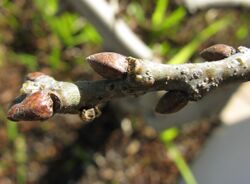
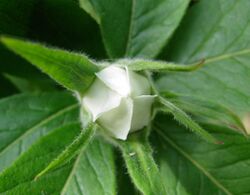
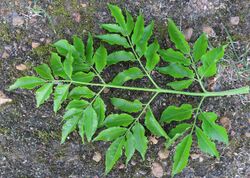
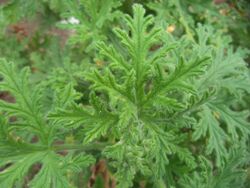
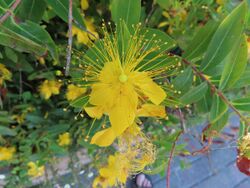
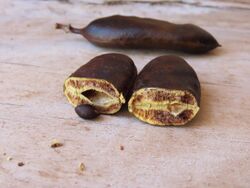
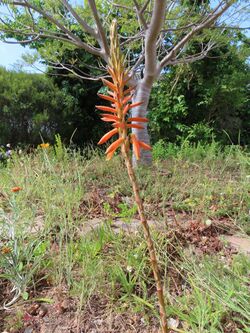
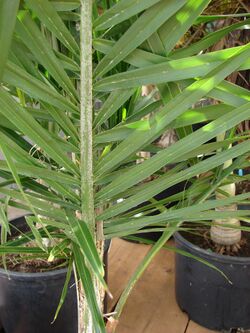
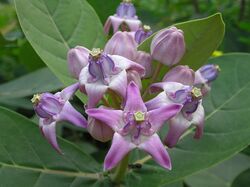
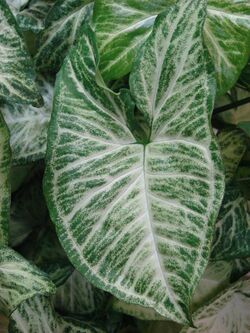
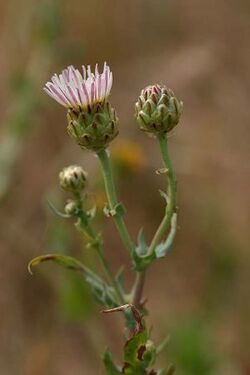
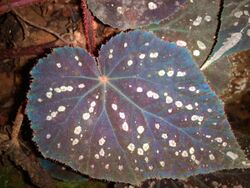
J
- A node or junction of two parts; articulation. <dt class="glossary " id="Lua error: Internal error: The interpreter has terminated with signal "24"." style="margin-top: 0.4em;">jugary
- associated with a jugum or something yoke-like; see for example jugary gland. <dt class="glossary " id="Lua error: Internal error: The interpreter has terminated with signal "24"." style="margin-top: 0.4em;">jugary gland
- A gland occurring on the rachis of a pinnate or bipinnate leaf on a jugum, the junction or attachment of pairs of pinnae or pinnules, as in some Acacia species. Compare interjugary. <dt class="glossary " id="Lua error: Internal error: The interpreter has terminated with signal "24"." style="margin-top: 0.4em;">jugate
- yoke-like; describing a structure of paired items joined together as in a jugum or something yoke-like, such as some leaves and fruit. <dt class="glossary " id="Lua error: Internal error: The interpreter has terminated with signal "24"." style="margin-top: 0.4em;">jugum
- applied to various yoke-like organs, usually in the sense of their being paired, such as a pair of pinnae on a rachis. <dt class="glossary " id="Lua error: Internal error: The interpreter has terminated with signal "24"." style="margin-top: 0.4em;">juvenile leaves
- Leaves formed on a young plant, typically differing from the adult leaves in form.
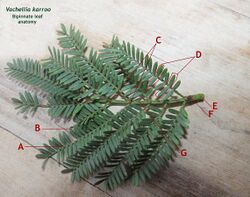
A. Rachilla
B. Pinnule
C. Jugary glands
D. Juga (plural of jugum)
E. Base of petiole
F. Petiolary gland
G. Rachis
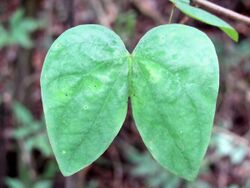
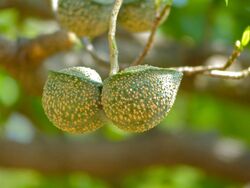
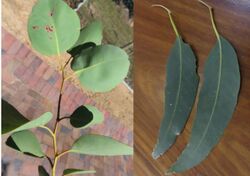
K
Lua error: Internal error: The interpreter has terminated with signal "24".
A prominent longitudinal ridge like the keel of a boat, e.g. the structure of the corolla formed by the fusion of the lower edge of the two abaxial anterior petals of flowers in the Fabaceae.
<dt class="glossary " id="Lua error: Internal error: The interpreter has terminated with signal "24"." style="margin-top: 0.4em;">kernel
- See drupe. <dt class="glossary " id="Lua error: Internal error: The interpreter has terminated with signal "24"." style="margin-top: 0.4em;">kettle trap
- another term for the kettle-like pitchers of any of the carnivorous pitcher plants, in which they trap their prey. <dt class="glossary " id="Lua error: Internal error: The interpreter has terminated with signal "24"." style="margin-top: 0.4em;">key innovation
- A novel phenotypic trait that allows subsequent evolutionary radiation and success of a taxonomic group. <dt class="glossary " id="Lua error: Internal error: The interpreter has terminated with signal "24"." style="margin-top: 0.4em;">kidney shape
- A term describing a kidney-shaped object such as a bean or a leaf; more formally, oblately cordate, or crescent-shaped with the ends rounded. <dt class="glossary " id="Lua error: Internal error: The interpreter has terminated with signal "24"." style="margin-top: 0.4em;">kingdom
- the highest generally employed category of the taxonomic hierarchy, above that of division (phylum). The Plant Kingdom includes vascular plants, bryophytes and green algae and is also known as the clade Viridiplantae. <dt class="glossary " id="Lua error: Internal error: The interpreter has terminated with signal "24"." style="margin-top: 0.4em;">Klausenfrucht
- Klausen or Klausenfrucht (german) is a special type of fruits in Lamiaceae and Boraginaceae. A dry, dehiscent fruit formed from a superior ovary with axil or basal placentation, with an adherent calyx, from more than one carpel and usually breaking apart into 1-seeded units by separating each carpel by false septa. One unit is a half carpel, mostly there are four units, seeds. English terms are eremocarp, schizocarp, mericarp or nutlets. <dt class="glossary " id="Lua error: Internal error: The interpreter has terminated with signal "24"." style="margin-top: 0.4em;">knee
- abrupt bend in a root or stem, commonly at a node; a cypress knee, or pneumatophore, is a type of bend or knob in the root of some plants, especially conifers such as some of the Taxodioideae, that shows as a projection of the root above ground level or mud level.
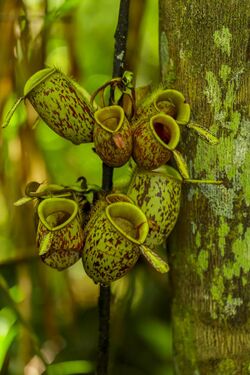
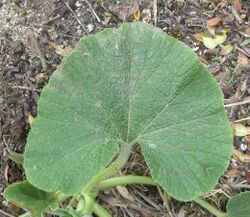
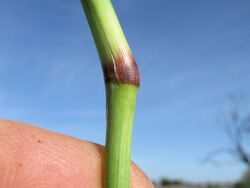
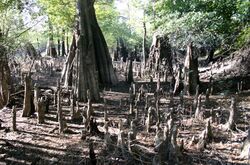
L
- lip; one of three or five petals which is (usually) different from the others, e.g. in Orchidaceae, Zingiberaceae, Cannaceae and Stylidiaceae. <dt class="glossary " id="Lua error: Internal error: The interpreter has terminated with signal "24"." style="margin-top: 0.4em;">labiate
- lipped; where a corolla is divided into two parts, called an upper and lower lip, the two resembling an open mouth with lips. <dt class="glossary " id="Lua error: Internal error: The interpreter has terminated with signal "24"." style="margin-top: 0.4em;">lacerate
- jagged, as if torn. <dt class="glossary " id="Lua error: Internal error: The interpreter has terminated with signal "24"." style="margin-top: 0.4em;">laciniate
- Of lobes – with ends irregularly divided into deeply divided, narrow, pointed segments; Of margins – deeply divided into pointed segments in an irregular manner. <dt class="glossary " id="Lua error: Internal error: The interpreter has terminated with signal "24"." style="margin-top: 0.4em;">lacuna
- An empty space, hole, cavity, pit, depression, or discontinuity. <dt class="glossary " id="Lua error: Internal error: The interpreter has terminated with signal "24"." style="margin-top: 0.4em;">lamella
Lua error: Internal error: The interpreter has terminated with signal "24".
Thin, plate-like layer.Lua error: Internal error: The interpreter has terminated with signal "24".
Composed of an assemblage of many layers.
<dt class="glossary " id="Lua error: Internal error: The interpreter has terminated with signal "24"." style="margin-top: 0.4em;">lamina
- the blade of a leaf or the expanded upper part of a petal, sepal or bract. <dt class="glossary " id="Lua error: Internal error: The interpreter has terminated with signal "24"." style="margin-top: 0.4em;">lanate
- covered in or composed of wooly hairs. <dt class="glossary " id="Lua error: Internal error: The interpreter has terminated with signal "24"." style="margin-top: 0.4em;">lanceolate
- longer than broad, narrowly ovate, broadest in the lower half and tapering to the tip, like a lance or spear head; (sometimes, and incorrectly, used to mean narrowly elliptic). <dt class="glossary " id="Lua error: Internal error: The interpreter has terminated with signal "24"." style="margin-top: 0.4em;">lateral
- attached to the side of an organ, e.g. leaves or branches on a stem. For more detail see dorsal. <dt class="glossary " id="Lua error: Internal error: The interpreter has terminated with signal "24"." style="margin-top: 0.4em;">latex
- a milky fluid that exudes from such plants such as spurges, figs and dandelions. <dt class="glossary " id="Lua error: Internal error: The interpreter has terminated with signal "24"." style="margin-top: 0.4em;">laticiferous
- latex-bearing, producing a milky juice. <dt class="glossary " id="Lua error: Internal error: The interpreter has terminated with signal "24"." style="margin-top: 0.4em;">latrorse
- a type of anther dehiscence in which the anthers open laterally toward adjacent anthers. Compare introrse and extrorse. <dt class="glossary " id="Lua error: Internal error: The interpreter has terminated with signal "24"." style="margin-top: 0.4em;">lauroid
- resembling Laurus, the laurel genus, particularly its leaves. <dt class="glossary " id="Lua error: Internal error: The interpreter has terminated with signal "24"." style="margin-top: 0.4em;">lax
- loose, not compact. <dt class="glossary " id="Lua error: Internal error: The interpreter has terminated with signal "24"." style="margin-top: 0.4em;">leaf
- an outgrowth of a stem, usually flat and green; its main function is food manufacture by photosynthesis. Abbreviation: lvs. <dt class="glossary " id="Lua error: Internal error: The interpreter has terminated with signal "24"." style="margin-top: 0.4em;">leaf gap
- a parenchymatous area in the stele above (distal to) a leaf trace. <dt class="glossary " id="Lua error: Internal error: The interpreter has terminated with signal "24"." style="margin-top: 0.4em;">leaf scar
- A healing layer forming on a stem where a leaf has fallen off. <dt class="glossary " id="Lua error: Internal error: The interpreter has terminated with signal "24"." style="margin-top: 0.4em;">leaf trace
- A vascular bundle connecting the stele to a leaf. <dt class="glossary " id="Lua error: Internal error: The interpreter has terminated with signal "24"." style="margin-top: 0.4em;">leaflets
- The ultimate segments of a compound leaf. <dt class="glossary " id="Lua error: Internal error: The interpreter has terminated with signal "24"." style="margin-top: 0.4em;">legume
- 1. a fruit characteristic of the family Fabaceae, formed from one carpel and either dehiscent along both sides, or indehiscent.
- 2. a crop species in the family Fabaceae.
- 3. a plant of the family Fabaceae. <dt class="glossary " id="Lua error: Internal error: The interpreter has terminated with signal "24"." style="margin-top: 0.4em;">lemma
- the lower of 2 bracts enclosing a grass flower. <dt class="glossary " id="Lua error: Internal error: The interpreter has terminated with signal "24"." style="margin-top: 0.4em;">lenticel
- Typically lenticular (lens-shaped) porous tissue in bark with large intercellular spaces that allows direct exchange of gases between the internal tissues and atmosphere through the bark. <dt class="glossary " id="Lua error: Internal error: The interpreter has terminated with signal "24"." style="margin-top: 0.4em;">lenticular
- 1. lens-shaped.
- 2. covered in lenticels. <dt class="glossary " id="Lua error: Internal error: The interpreter has terminated with signal "24"." style="margin-top: 0.4em;">lepidote
- covered with small scales. <dt class="glossary " id="Lua error: Internal error: The interpreter has terminated with signal "24"." style="margin-top: 0.4em;">leprose
- powdery <dt class="glossary " id="Lua error: Internal error: The interpreter has terminated with signal "24"." style="margin-top: 0.4em;">liana
- a woody climbing plant, rooted in the ground (liane is also used). <dt class="glossary " id="Lua error: Internal error: The interpreter has terminated with signal "24"." style="margin-top: 0.4em;">liane
- a woody climbing plant, rooted in the ground. See also liana. <dt class="glossary " id="Lua error: Internal error: The interpreter has terminated with signal "24"." style="margin-top: 0.4em;">ligneous
- having hard lignified tissues or woody parts, woody <dt class="glossary " id="Lua error: Internal error: The interpreter has terminated with signal "24"." style="margin-top: 0.4em;">lignum
- Dead wood, typically in the context of a substrate for lichens. <dt class="glossary " id="Lua error: Internal error: The interpreter has terminated with signal "24"." style="margin-top: 0.4em;">lignicolous
- Growing on wood tissue after bark as fallen or been stripped off (compare to corticolous). <dt class="glossary " id="Lua error: Internal error: The interpreter has terminated with signal "24"." style="margin-top: 0.4em;">lignotuber
- a woody swelling of the stem below or just above the ground; contains adventitious buds from which new shoots can develop, e.g. after fire. <dt class="glossary " id="Lua error: Internal error: The interpreter has terminated with signal "24"." style="margin-top: 0.4em;">ligulate
- 1. bearing a ligule.
- 2. strap-shaped. <dt class="glossary " id="Lua error: Internal error: The interpreter has terminated with signal "24"." style="margin-top: 0.4em;">ligule
- 1. A small membranous appendage on the top of the sheath of grass leaves.
- 2. A minute adaxial appendage near the base of a leaf, e.g. in Selaginella.
- 3. An extended, strap-like corolla in some daisy florets. <dt class="glossary " id="Lua error: Internal error: The interpreter has terminated with signal "24"." style="margin-top: 0.4em;">linea, line, British line, Paris line
- Various pre-metric units somewhat larger than 2 mm, used in botany into the 20th century. See Line (unit) and Paris line. <dt class="glossary " id="Lua error: Internal error: The interpreter has terminated with signal "24"." style="margin-top: 0.4em;">linear
- Very narrow in relation to its length, with the sides mostly parallel. See Leaf shape. <dt class="glossary " id="Lua error: Internal error: The interpreter has terminated with signal "24"." style="margin-top: 0.4em;">lingulate
- tongue-shaped. <dt class="glossary " id="Lua error: Internal error: The interpreter has terminated with signal "24"." style="margin-top: 0.4em;">lip
- A labellum. <dt class="glossary " id="Lua error: Internal error: The interpreter has terminated with signal "24"." style="margin-top: 0.4em;">lithophytic
- A plant growing on rocks; an epilithic plant. <dt class="glossary " id="Lua error: Internal error: The interpreter has terminated with signal "24"." style="margin-top: 0.4em;">lobe
- Part of a leaf (or other organ), often rounded and formed by incisions to about halfway to the midrib. <dt class="glossary " id="Lua error: Internal error: The interpreter has terminated with signal "24"." style="margin-top: 0.4em;">lobulate
- Having, consisting of or relating to a lobe or lobes. <dt class="glossary " id="Lua error: Internal error: The interpreter has terminated with signal "24"." style="margin-top: 0.4em;">loculicidal
- (of a fruit) Dehiscing through the centers of loculi. Compare septicidal. <dt class="glossary " id="Lua error: Internal error: The interpreter has terminated with signal "24"." style="margin-top: 0.4em;">locule
- A chamber or cavity containing seeds within an ovary, pollen within an anther or spores in a sporangium. <dt class="glossary " id="Lua error: Internal error: The interpreter has terminated with signal "24"." style="margin-top: 0.4em;">lodicule
- One of two or three minute organs at the base of the ovary of a grass flower, representing parts of a strongly reduced perianth. <dt class="glossary " id="Lua error: Internal error: The interpreter has terminated with signal "24"." style="margin-top: 0.4em;">lomentum or loment
- A pod-like indehiscent fruit that develops constrictions between the segments and at maturity breaks into one-seeded segments instead of splitting open. <dt class="glossary " id="Lua error: Internal error: The interpreter has terminated with signal "24"." style="margin-top: 0.4em;">longicidal
- (of anthers) Opening lengthwise by longitudinal slits. Compare poricidal. <dt class="glossary " id="Lua error: Internal error: The interpreter has terminated with signal "24"." style="margin-top: 0.4em;">lunate
- Crescent-shaped. <dt class="glossary " id="Lua error: Internal error: The interpreter has terminated with signal "24"." style="margin-top: 0.4em;">lumen
- The cavity bounded by a plant cell wall. <dt class="glossary " id="Lua error: Internal error: The interpreter has terminated with signal "24"." style="margin-top: 0.4em;">lyrate
- Lyre-shaped; deeply lobed, with a large terminal lobe and smaller lateral ones.
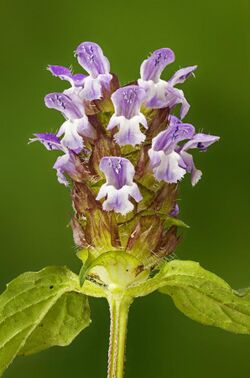

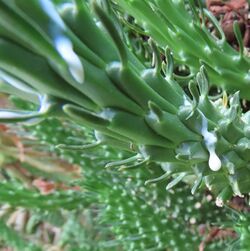
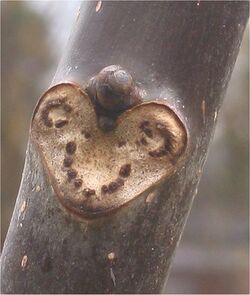
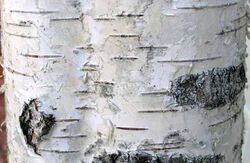
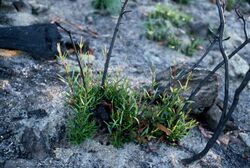
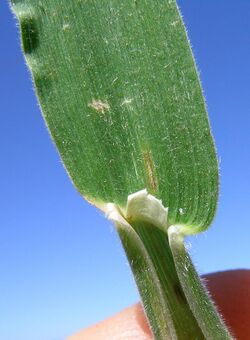
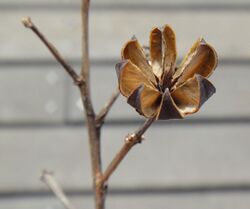
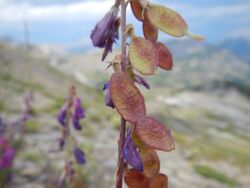
M
- Spotted; marked with spots. <dt class="glossary " id="Lua error: Internal error: The interpreter has terminated with signal "24"." style="margin-top: 0.4em;">male flower
- See staminate flower. <dt class="glossary " id="Lua error: Internal error: The interpreter has terminated with signal "24"." style="margin-top: 0.4em;">mallee
- A growth habit in which several woody stems arise separately from a lignotuber; a plant with such a growth habit, e.g. many Eucalyptus species; vegetation characterized by such plants. <dt class="glossary " id="Lua error: Internal error: The interpreter has terminated with signal "24"." style="margin-top: 0.4em;">mangrove
- Any shrub or small tree growing in salt or brackish water, usually characterized by pneumatophores; any tropical coastal vegetation characterized by such species. <dt class="glossary " id="Lua error: Internal error: The interpreter has terminated with signal "24"." style="margin-top: 0.4em;">margin
- The edge of a structure, as in the edge of a leaf blade. <dt class="glossary " id="Lua error: Internal error: The interpreter has terminated with signal "24"." style="margin-top: 0.4em;">marginal
- Occurring at or very close to a margin. <dt class="glossary " id="Lua error: Internal error: The interpreter has terminated with signal "24"." style="margin-top: 0.4em;">marsh
- A waterlogged area or swamp. <dt class="glossary " id="Lua error: Internal error: The interpreter has terminated with signal "24"." style="margin-top: 0.4em;">mast
- Edible fruit and nuts produced by woody species of plants (e.g. acorns and beechmast) which is consumed on the ground by wildlife species and some domestic animals. <dt class="glossary " id="Lua error: Internal error: The interpreter has terminated with signal "24"." style="margin-top: 0.4em;">mealy
- Covered with coarse, floury powder. <dt class="glossary " id="Lua error: Internal error: The interpreter has terminated with signal "24"." style="margin-top: 0.4em;">medulla
- pith. See also medullary rays in wood. <dt class="glossary " id="Lua error: Internal error: The interpreter has terminated with signal "24"." style="margin-top: 0.4em;">megasporangium
- the larger of two kinds of sporangium produced by heterosporous plants, producing large spores that contain the female gametophytes. Compare microsporangium. <dt class="glossary " id="Lua error: Internal error: The interpreter has terminated with signal "24"." style="margin-top: 0.4em;">megaspore
- the larger of two kinds of spores produced by a heterosporous plant, giving rise to the female gametophyte. Compare microspore. <dt class="glossary " id="Lua error: Internal error: The interpreter has terminated with signal "24"." style="margin-top: 0.4em;">megasporophyll
- in hetersoporous plants, a modified leaf bearing one or more megasporangia. Compare microsporophyll. <dt class="glossary " id="Lua error: Internal error: The interpreter has terminated with signal "24"." style="margin-top: 0.4em;">megastrobilus
- the larger of two kinds of cones or strobili produced by gymnosperms, being female and producing the seeds. Compare microstrobilus. <dt class="glossary " id="Lua error: Internal error: The interpreter has terminated with signal "24"." style="margin-top: 0.4em;">membranous
- thin, translucent and flexible, seldom green. <dt class="glossary " id="Lua error: Internal error: The interpreter has terminated with signal "24"." style="margin-top: 0.4em;">mericarp
- one segment of a fruit (a schizocarp) that splits at maturity into units derived from the individual carpels, or a carpel, usually 1-seeded, released by the break-up at maturity of a fruit formed from 2 or more joined carpels. <dt class="glossary " id="Lua error: Internal error: The interpreter has terminated with signal "24"." style="margin-top: 0.4em;">meristem
- Any actively dividing plant tissue. <dt class="glossary " id="Lua error: Internal error: The interpreter has terminated with signal "24"." style="margin-top: 0.4em;">mesic
- Moist, avoiding both extremes of drought and wet; pertaining to conditions of moderate moisture or water supply; applied to organisms (vegetation) occupying moist habitats. <dt class="glossary " id="Lua error: Internal error: The interpreter has terminated with signal "24"." style="margin-top: 0.4em;">mesocarp
- The fleshy portion of the wall of a succulent fruit inside the skin and outside the stony layer (if any), surrounding the seed(s); sarcocarp. <dt class="glossary " id="Lua error: Internal error: The interpreter has terminated with signal "24"." style="margin-top: 0.4em;">mesomorphic
- Soft and with little fibrous tissue, but not succulent. <dt class="glossary " id="Lua error: Internal error: The interpreter has terminated with signal "24"." style="margin-top: 0.4em;">mesophyll
- 1. The parenchyma tissues between the upper and lower epidermis. They vary in function, but usually include the photosynthetic tissue of a leaf.
- 2. In ecology, the blade of a leaf or leaflet that has a surface area 4500–18225 mm2; a plant, or vegetation, that has mesophyll (sized) leaves. <dt class="glossary " id="Lua error: Internal error: The interpreter has terminated with signal "24"." style="margin-top: 0.4em;">mesophyllous
- (of vegetation) Of moist habitats and having mostly large and soft leaves. <dt class="glossary " id="Lua error: Internal error: The interpreter has terminated with signal "24"." style="margin-top: 0.4em;">mesophyte
- A plant thriving under intermediate environmental conditions of moderate moisture and temperature, without major seasonal fluctuations. <dt class="glossary " id="Lua error: Internal error: The interpreter has terminated with signal "24"." style="margin-top: 0.4em;">micropyle
- Opening at apex of ovule. <dt class="glossary " id="Lua error: Internal error: The interpreter has terminated with signal "24"." style="margin-top: 0.4em;">microsporangium
- The smaller of two kinds of sporangium produced by a heterosporous plant, producing microspores that contain the male gametophyte. Compare megasporangium. <dt class="glossary " id="Lua error: Internal error: The interpreter has terminated with signal "24"." style="margin-top: 0.4em;">microspore
- The smaller of two kinds of spores produced by a heterosporous plant. Compare megaspore. <dt class="glossary " id="Lua error: Internal error: The interpreter has terminated with signal "24"." style="margin-top: 0.4em;">microsporophyll
- In heterosporous plants, a modified leaf bearing one or more microsporangia. Compare megasporophyll. <dt class="glossary " id="Lua error: Internal error: The interpreter has terminated with signal "24"." style="margin-top: 0.4em;">microstrobilus
- The smaller of two kinds of cones or strobilus produced by gymnosperms, being male and producing the pollen. Compare megastrobilus. <dt class="glossary " id="Lua error: Internal error: The interpreter has terminated with signal "24"." style="margin-top: 0.4em;">midrib
Lua error: Internal error: The interpreter has terminated with signal "24".
The central and usually most prominent vein of a leaf or leaf-like organ.
<dt class="glossary " id="Lua error: Internal error: The interpreter has terminated with signal "24"." style="margin-top: 0.4em;">midvein
- See midrib. <dt class="glossary " id="Lua error: Internal error: The interpreter has terminated with signal "24"." style="margin-top: 0.4em;">monad
- A single individual that is free from other individuals, not united with them into a group. The term is usually used for pollen to distinguish single grains from tetrads or polyads. <dt class="glossary " id="Lua error: Internal error: The interpreter has terminated with signal "24"." style="margin-top: 0.4em;">moniliform
- Resembling a string of beads. <dt class="glossary " id="Lua error: Internal error: The interpreter has terminated with signal "24"." style="margin-top: 0.4em;">monocarpic
- Flowering and setting seed only once before dying. See also semelparous. <dt class="glossary " id="Lua error: Internal error: The interpreter has terminated with signal "24"." style="margin-top: 0.4em;">monochasium
- A cymose inflorescence with the branches arising singly. Compare dichasium and pleiochasium. <dt class="glossary " id="Lua error: Internal error: The interpreter has terminated with signal "24"." style="margin-top: 0.4em;">monocot
- An abbreviation of monocotyledon. <dt class="glossary " id="Lua error: Internal error: The interpreter has terminated with signal "24"." style="margin-top: 0.4em;">monocotyledon
- A flowering plant whose embryo contains one cotyledon (seed-leaf). Compare dicotyledon. <dt class="glossary " id="Lua error: Internal error: The interpreter has terminated with signal "24"." style="margin-top: 0.4em;">monoecious
- (of vascular plants) Hermaphroditic, with all flowers bisexual, or with male and female reproductive structures in separate flowers but on the same plant, or of an inflorescence that has unisexual flowers of both sexes. Contrast dioecious. <dt class="glossary " id="Lua error: Internal error: The interpreter has terminated with signal "24"." style="margin-top: 0.4em;">monoicous
- (of bryophyte gametophytes) Hermaphroditic or bisexual, where both male and female reproductive structures develop on the same individual. Contrast dioicous. <dt class="glossary " id="Lua error: Internal error: The interpreter has terminated with signal "24"." style="margin-top: 0.4em;">monograph
- Of a group of plants, a comprehensive treatise presenting an analysis and synthesis of taxonomic knowledge of that taxon; the fullest account possible (at the time) of a family, tribe or genus. It is generally worldwide in scope and evaluates all taxonomic treatments of that taxon including studies of its evolutionary relationships with other related taxa, and cytological, genetic, morphological, palaeobotanical and ecological studies. The term is often incorrectly applied to any systematic work devoted to a single taxon. Compare revision. <dt class="glossary " id="Lua error: Internal error: The interpreter has terminated with signal "24"." style="margin-top: 0.4em;">monomorphic
- Of one type, rather than several. See also dimorphic (two types) and polymorphic (many types). <dt class="glossary " id="Lua error: Internal error: The interpreter has terminated with signal "24"." style="margin-top: 0.4em;">monophyllous
- Having a single leaf. <dt class="glossary " id="Lua error: Internal error: The interpreter has terminated with signal "24"." style="margin-top: 0.4em;">monopodial
- A mode of stem growth and branching in which the main axis is formed by a single dominant meristem. Contrast sympodial. <dt class="glossary " id="Lua error: Internal error: The interpreter has terminated with signal "24"." style="margin-top: 0.4em;">monostromatic
- Being a single cell thick, as in the alga Monostroma. <dt class="glossary " id="Lua error: Internal error: The interpreter has terminated with signal "24"." style="margin-top: 0.4em;">monothecous
- having a sole compartment or cell. Compare Dithecous. <dt class="glossary " id="Lua error: Internal error: The interpreter has terminated with signal "24"." style="margin-top: 0.4em;">monotypic
- Containing only one taxon of the next lower rank, e.g. a family with only one genus, or a genus that includes only a single species. <dt class="glossary " id="Lua error: Internal error: The interpreter has terminated with signal "24"." style="margin-top: 0.4em;">morphology
- The shape or form of an organism or part thereof. <dt class="glossary " id="Lua error: Internal error: The interpreter has terminated with signal "24"." style="margin-top: 0.4em;">mucro
Lua error: Internal error: The interpreter has terminated with signal "24".
A sharp, short point, generally at the tip of a leaf or the tip of the midrib of a compound leaf.Lua error: Internal error: The interpreter has terminated with signal "24".Lua error: Internal error: The interpreter has terminated with signal "24".
<dt class="glossary " id="Lua error: Internal error: The interpreter has terminated with signal "24"." style="margin-top: 0.4em;">mucronate
- Terminating in a mucro. <dt class="glossary " id="Lua error: Internal error: The interpreter has terminated with signal "24"." style="margin-top: 0.4em;">multiple fruit
- A cluster of fruits produced from more than one flower and appearing as a single fruit, often on a swollen axis, as with many species of the family Moraceae. Compare aggregate fruit. <dt class="glossary " id="Lua error: Internal error: The interpreter has terminated with signal "24"." style="margin-top: 0.4em;">muricate
- Covered with short, hard protuberances. <dt class="glossary " id="Lua error: Internal error: The interpreter has terminated with signal "24"." style="margin-top: 0.4em;">mutation
- In times before the nature of genetic encoding was understood, mutation was regarded as an abrupt, and sometimes heritable, variation from the norm of a population; for example a plant might unexpectedly produce "double" flowers, a novel color, or a habit of growth uncharacteristic of the species or variety. Advances in genetics and molecular biology in the mid-twentieth century, showed that biological mutations comprise and reflect changes in the nucleic acid molecules that encode the genome of an organism or virus. The nucleic acid affected could be DNA in the chromosomes, or it could be extrachromosomal DNA (typically DNA in the mitochondria or chloroplasts). In RNA viruses a mutation would be a change to the genetic information that the RNA encodes. <dt class="glossary " id="Lua error: Internal error: The interpreter has terminated with signal "24"." style="margin-top: 0.4em;">mycelium
- The "vegetative" (nonreproductive) part of a fungus, mostly composed of aggregations of hyphae. It functions in substrate decomposition and absorption of nutrients. <dt class="glossary " id="Lua error: Internal error: The interpreter has terminated with signal "24"." style="margin-top: 0.4em;">mycorrhiza
Lua error: Internal error: The interpreter has terminated with signal "24".
One of several types of symbiotic association between a fungus and the roots of a plant.
<dt class="glossary " id="Lua error: Internal error: The interpreter has terminated with signal "24"." style="margin-top: 0.4em;">mycotroph
Lua error: Internal error: The interpreter has terminated with signal "24".
A plant that obtains most or all of its carbon, water, and nutrients by associating with a fungus.
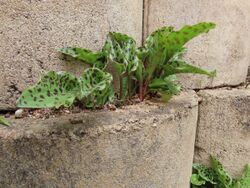
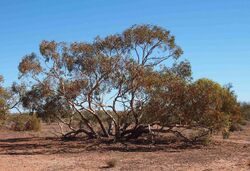
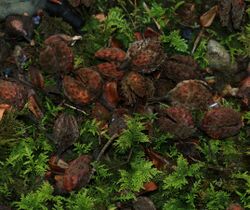
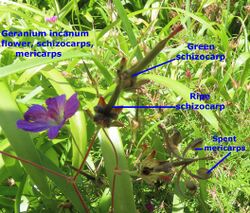
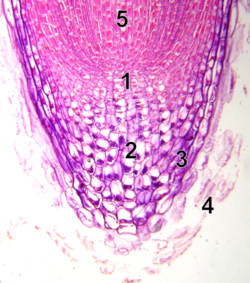
2: Columella
showing statocytes with statoliths
3: Lateral part of the tip
4: Dead cells
5: Elongation zone
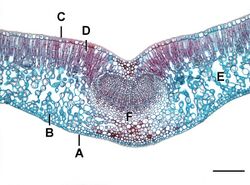
B-Lower palisade mesophyll
C-Upper epidermis
D-Upper palisade mesophyll
E- Spongy mesophyll
F-Leaf vein
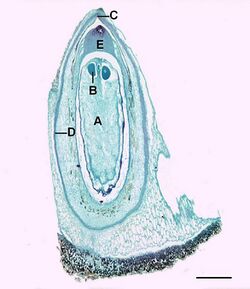
B=Egg cell
C=Micropyle
D=Integument
E=Megasporangium
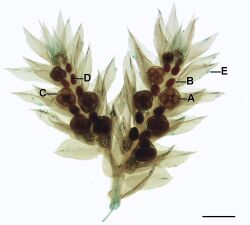
B-Microsporangium
C-Megasporangium
D-Microspore
E-Sporophyll
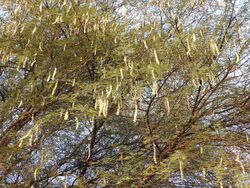
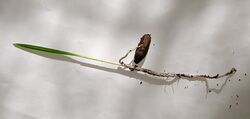
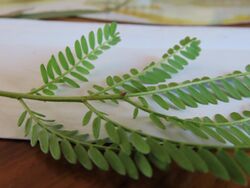
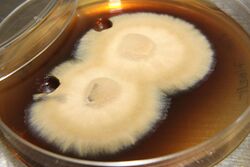
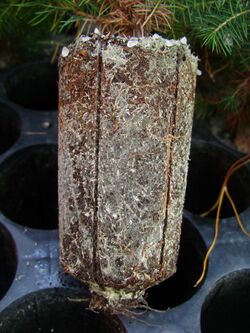
N
- Naturally occurring in an area, but not necessarily confined to it. Compare endemic. <dt class="glossary " id="Lua error: Internal error: The interpreter has terminated with signal "24"." style="margin-top: 0.4em;">natural hybrid
- A hybrid taxon produced by chance in the wild. <dt class="glossary " id="Lua error: Internal error: The interpreter has terminated with signal "24"." style="margin-top: 0.4em;">naturalised
- Describing a plant, introduced from another region, that grows and reproduces readily in competition with the natural flora. <dt class="glossary " id="Lua error: Internal error: The interpreter has terminated with signal "24"." style="margin-top: 0.4em;">nectar
- A usually sweet, nutrient-rich fluid produced by the flowers of many plants and collected by bees and other pollinators. <dt class="glossary " id="Lua error: Internal error: The interpreter has terminated with signal "24"." style="margin-top: 0.4em;">nectary
Lua error: Internal error: The interpreter has terminated with signal "24".
A specialized gland that secretes nectar.
<dt class="glossary " id="Lua error: Internal error: The interpreter has terminated with signal "24"." style="margin-top: 0.4em;">neophyte
- A plant that has recently been introduced to a geographic area. Contrast archaeophyte. <dt class="glossary " id="Lua error: Internal error: The interpreter has terminated with signal "24"." style="margin-top: 0.4em;">nerve
- Another name for a vein. <dt class="glossary " id="Lua error: Internal error: The interpreter has terminated with signal "24"." style="margin-top: 0.4em;">node
- The part of a stem from which leaves or branches arise. <dt class="glossary " id="Lua error: Internal error: The interpreter has terminated with signal "24"." style="margin-top: 0.4em;">nomen conservandum
- (Latin) A conserved name, usually a name that became so much better known than the correct name, that a substitution was made. <dt class="glossary " id="Lua error: Internal error: The interpreter has terminated with signal "24"." style="margin-top: 0.4em;">nomen illegitimum
- A name that is either superfluous at its time of publication because the taxon to which it was applied already has a name, or the name has already been applied to another plant (a homonym). <dt class="glossary " id="Lua error: Internal error: The interpreter has terminated with signal "24"." style="margin-top: 0.4em;">nomen invalidum
- A name that is not validly published, and technically is therefore not a botanical name. Abbreviation: nom. inval. See valid publication. <dt class="glossary " id="Lua error: Internal error: The interpreter has terminated with signal "24"." style="margin-top: 0.4em;">nomen nudum
- A name not published in accordance with the International Code of Nomenclature for algae, fungi, and plants, usually without a diagnosis or description of the entity to which it applies, and without reference to either; such a name should not be used. <dt class="glossary " id="Lua error: Internal error: The interpreter has terminated with signal "24"." style="margin-top: 0.4em;">nomenclature
- The naming of things; often restricted to the correct use of scientific names in taxonomy; a system that sets out provisions for the formation and use of names. <dt class="glossary " id="Lua error: Internal error: The interpreter has terminated with signal "24"." style="margin-top: 0.4em;">noxious
- Of plants, containing harmful or unwholesome qualities. Applied in conjunction with 'weed' to specifically describe a plant which legislation deems harmful to the environment. Each state and territory in Australia has specific legislation governing noxious weeds. <dt class="glossary " id="Lua error: Internal error: The interpreter has terminated with signal "24"." style="margin-top: 0.4em;">nucellus
- The tissue of the ovule of a seed plant that surrounds the female gametophyte. It is enclosed by integuments and is not of epidermal origin. <dt class="glossary " id="Lua error: Internal error: The interpreter has terminated with signal "24"." style="margin-top: 0.4em;">numerous
- Stamens are described as numerous when there are more than twice as many as sepals or petals, especially when there is no set number of them. Compare indefinite. <dt class="glossary " id="Lua error: Internal error: The interpreter has terminated with signal "24"." style="margin-top: 0.4em;">nut
- A hard, dry, indehiscent fruit containing only one seed. <dt class="glossary " id="Lua error: Internal error: The interpreter has terminated with signal "24"." style="margin-top: 0.4em;">nutlet
- 1. A small nut.
- 2. One of the lobes or sections of the mature ovary of some members of the Boraginaceae, Verbenaceae, and Lamiaceae.
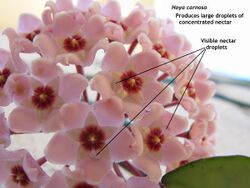
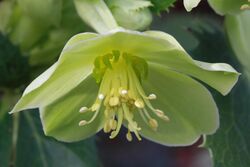
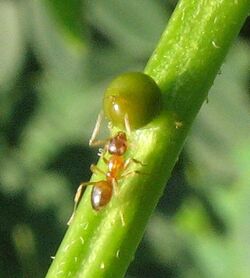
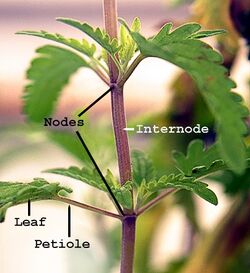
O
- A prefix meaning "inversely"; usually the same shape as that described by the word stem, but attached by the narrower end. See obcordate, oblanceolate and obovate. <dt class="glossary " id="Lua error: Internal error: The interpreter has terminated with signal "24"." style="margin-top: 0.4em;">obconic
- (of a fruit, hypanthium, pistil, or calyx) Shaped like an inverted cone, attached at the apex. <dt class="glossary " id="Lua error: Internal error: The interpreter has terminated with signal "24"." style="margin-top: 0.4em;">obcordate
- (of a leaf blade) Broad and notched at the tip; heart-shaped but attached at the pointed end. <dt class="glossary " id="Lua error: Internal error: The interpreter has terminated with signal "24"." style="margin-top: 0.4em;">obdiplostemonous
- Having stamens arranged in two whorls, and having twice as many stamens as petals, with the outer whorl being opposite the petals. Compare diplostemonous and haplostemonous. <dt class="glossary " id="Lua error: Internal error: The interpreter has terminated with signal "24"." style="margin-top: 0.4em;">oblanceolate
- Having a lanceolate shape but broadest in the upper third. <dt class="glossary " id="Lua error: Internal error: The interpreter has terminated with signal "24"." style="margin-top: 0.4em;">oblate
- Having a spherical shape but flattened at the poles. <dt class="glossary " id="Lua error: Internal error: The interpreter has terminated with signal "24"." style="margin-top: 0.4em;">obligate
- (of parasites) Unable to survive without a host. Contrast facultative. <dt class="glossary " id="Lua error: Internal error: The interpreter has terminated with signal "24"." style="margin-top: 0.4em;">oblique
- Slanting; of a leaf or stem, larger on one side of the midrib than the other, in other words asymmetrical. <dt class="glossary " id="Lua error: Internal error: The interpreter has terminated with signal "24"." style="margin-top: 0.4em;">obloid
- Having a three-dimensional oblong shape, e.g. a fruit. <dt class="glossary " id="Lua error: Internal error: The interpreter has terminated with signal "24"." style="margin-top: 0.4em;">oblong
- Having a length a few times greater than the width, with sides almost parallel and ends rounded. <dt class="glossary " id="Lua error: Internal error: The interpreter has terminated with signal "24"." style="margin-top: 0.4em;">obovate
- (of a leaf) Having a length about 1.5 times the width, and widest above the center. <dt class="glossary " id="Lua error: Internal error: The interpreter has terminated with signal "24"." style="margin-top: 0.4em;">obsolete
- Not evident, or at most rudimentary or vestigial. <dt class="glossary " id="Lua error: Internal error: The interpreter has terminated with signal "24"." style="margin-top: 0.4em;">obtrapeziform
- trapeziform, but attached by the narrower trapezoidal base (e.g. of a leaf) <dt class="glossary " id="Lua error: Internal error: The interpreter has terminated with signal "24"." style="margin-top: 0.4em;">obtuse
- Blunt or rounded; having converging edges that form an angle of more than 90°. Compare acute. <dt class="glossary " id="Lua error: Internal error: The interpreter has terminated with signal "24"." style="margin-top: 0.4em;">ocrea
Lua error: Internal error: The interpreter has terminated with signal "24".
A sheath formed from two stipules encircling the node in members of the Polygonaceae.
<dt class="glossary " id="Lua error: Internal error: The interpreter has terminated with signal "24"." style="margin-top: 0.4em;">odd-pinnate
Lua error: Internal error: The interpreter has terminated with signal "24".
Having an odd number of leaflets in a compound pinnate leaf, such that there is only one terminal leaflet.
<dt class="glossary " id="Lua error: Internal error: The interpreter has terminated with signal "24"." style="margin-top: 0.4em;">oft.
- An abbreviation of "often". Compare usu. and s.t.. <dt class="glossary " id="Lua error: Internal error: The interpreter has terminated with signal "24"." style="margin-top: 0.4em;">-oideae
- A suffix added to the stem of a generic name to form the name of a subfamily, e.g. Fumaria → Fumarioideae. <dt class="glossary " id="Lua error: Internal error: The interpreter has terminated with signal "24"." style="margin-top: 0.4em;">olim
- Formerly, e.g. "olim B", formerly in the Berlin herbarium (Herbarium Berolinense). <dt class="glossary " id="Lua error: Internal error: The interpreter has terminated with signal "24"." style="margin-top: 0.4em;">ontogeny
- The sequence of developmental stages through which an organism passes as it grows. <dt class="glossary " id="Lua error: Internal error: The interpreter has terminated with signal "24"." style="margin-top: 0.4em;">operculum (calyptra)
- A lid or cover that becomes detached at maturity, e.g. in Eucalyptus, a cap covering the bud and formed by the fusion or cohesion of perianth parts. <dt class="glossary " id="Lua error: Internal error: The interpreter has terminated with signal "24"." style="margin-top: 0.4em;">opposite
- 1. Describing leaves or flowers borne at the same level but on directly opposite sides of their common axis.
- 2. Describing the occurrence of something on the same radius as something else, e.g. anthers opposite sepals. Compare alternate. <dt class="glossary " id="Lua error: Internal error: The interpreter has terminated with signal "24"." style="margin-top: 0.4em;">opus utique oppressum
Lua error: Internal error: The interpreter has terminated with signal "24".
Listed after the botanical name of a plant, or the name of a publication, this indicates that a publication is listed in the International Code of Nomenclature for algae, fungi, and plants as a suppressed work. Botanical names of the specified rank in the publication are considered not validly published (article 34).
<dt class="glossary " id="Lua error: Internal error: The interpreter has terminated with signal "24"." style="margin-top: 0.4em;">orbicular
- Flat and more or less circular. <dt class="glossary " id="Lua error: Internal error: The interpreter has terminated with signal "24"." style="margin-top: 0.4em;">order
- A group of one or more families sharing common features, ancestry, or both. <dt class="glossary " id="Lua error: Internal error: The interpreter has terminated with signal "24"." style="margin-top: 0.4em;">ortet
- The original single parent plant from which a clone ultimately derives. <dt class="glossary " id="Lua error: Internal error: The interpreter has terminated with signal "24"." style="margin-top: 0.4em;">orthotropous
- Describes an ovule that is erect, with the micropyle directed away from the placenta; atropous. Compare amphitropous, anatropous, and campylotropous. <dt class="glossary " id="Lua error: Internal error: The interpreter has terminated with signal "24"." style="margin-top: 0.4em;">oval
- See elliptical. <dt class="glossary " id="Lua error: Internal error: The interpreter has terminated with signal "24"." style="margin-top: 0.4em;">ovary
- The basal portion of a carpel or group of fused carpels, enclosing the ovules. <dt class="glossary " id="Lua error: Internal error: The interpreter has terminated with signal "24"." style="margin-top: 0.4em;">ovate
- Shaped like a section through the "long axis" of an egg and attached by the wider end. <dt class="glossary " id="Lua error: Internal error: The interpreter has terminated with signal "24"." style="margin-top: 0.4em;">ovoid
- Egg-shaped, with wider portion at base; 3-dimensional object, ovate in all sections through long-axis. <dt class="glossary " id="Lua error: Internal error: The interpreter has terminated with signal "24"." style="margin-top: 0.4em;">ovule
- Loosely, the seed before fertilization; a structure in a seed plant within which one or more megaspores are formed (after fertilization it develops into a seed).
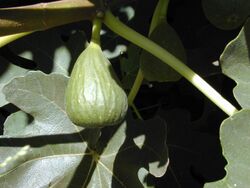
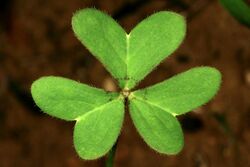
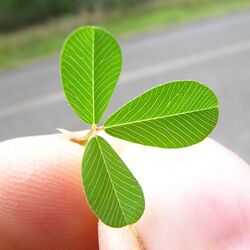
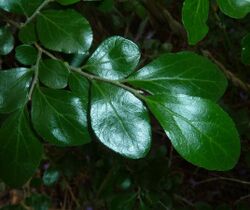
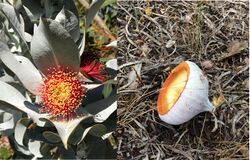
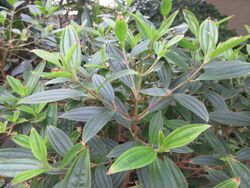
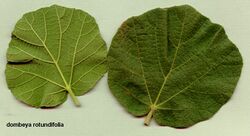
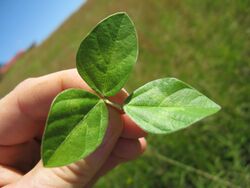
P
- with a disproportionately thick trunk <dt class="glossary " id="Lua error: Internal error: The interpreter has terminated with signal "24"." style="margin-top: 0.4em;">pachycladous
- with disproportionately thick stems <dt class="glossary " id="Lua error: Internal error: The interpreter has terminated with signal "24"." style="margin-top: 0.4em;">palate
- An expanded lower lip of a flower that nearly or entirely blocks the opening of a flower tube, as in a snapdragon flower.[30] <dt class="glossary " id="Lua error: Internal error: The interpreter has terminated with signal "24"." style="margin-top: 0.4em;">palea
Lua error: Internal error: The interpreter has terminated with signal "24".
1. The upper of two bracts enclosing a grass flower, major contributors to chaff in harvested grain.- 2. Chaffy scales on the receptacles of many Asteraceae.
- 3. Chaffy scales on the stipe of many ferns. <dt class="glossary " id="Lua error: Internal error: The interpreter has terminated with signal "24"." style="margin-top: 0.4em;">paleate
- Bearing paleae or chaffy scales, as in description of the receptacle of a capitulum of a plant in the Asteraceae. <dt class="glossary " id="Lua error: Internal error: The interpreter has terminated with signal "24"." style="margin-top: 0.4em;">paleaceous
- Chaff-like in texture. <dt class="glossary " id="Lua error: Internal error: The interpreter has terminated with signal "24"." style="margin-top: 0.4em;">palmate
- 1. leaf with veins radiating out from a central point (usually at the top of a petiole), resembling spread out fingers pointing away from the palm.
- 2. A compound palmate leaf has leaflets that radiate from a central point (usually at the top of a petiole). <dt class="glossary " id="Lua error: Internal error: The interpreter has terminated with signal "24"." style="margin-top: 0.4em;">palmatifid
- Deeply divided into several lobes arising from more or less the same level. <dt class="glossary " id="Lua error: Internal error: The interpreter has terminated with signal "24"." style="margin-top: 0.4em;">palmatisect
- Intermediate between palmate and palmatifid, i.e. the segments are not fully separated at the base; often more or less digitate. <dt class="glossary " id="Lua error: Internal error: The interpreter has terminated with signal "24"." style="margin-top: 0.4em;">pandurate
- shaped like the body of a fiddle (mainly, of plant leaves) <dt class="glossary " id="Lua error: Internal error: The interpreter has terminated with signal "24"." style="margin-top: 0.4em;">panicle
Lua error: Internal error: The interpreter has terminated with signal "24".
A compound raceme; an indeterminate inflorescence in which the flowers are borne on branches of the main axis or on further branches of these.
<dt class="glossary " id="Lua error: Internal error: The interpreter has terminated with signal "24"." style="margin-top: 0.4em;">papilionate
- Butterfly-like; having a corolla like that of a pea. <dt class="glossary " id="Lua error: Internal error: The interpreter has terminated with signal "24"." style="margin-top: 0.4em;">papilla
Lua error: Internal error: The interpreter has terminated with signal "24".
A small, elongated protuberance on the surface of an organ, usually an extension of one epidermal cell.
<dt class="glossary " id="Lua error: Internal error: The interpreter has terminated with signal "24"." style="margin-top: 0.4em;">pappus
- In daisy florets, a tuft or ring of hairs or scales borne above the ovary and outside the corolla (representing the reduced calyx); a tuft of hairs on a fruit. <dt class="glossary " id="Lua error: Internal error: The interpreter has terminated with signal "24"." style="margin-top: 0.4em;">paracarpel
- Ill-defined term, variously interpreted and applied to: organs attached to carpels; staminodes close to the gynoecium; and to a pistillode in a staminate flower <dt class="glossary " id="Lua error: Internal error: The interpreter has terminated with signal "24"." style="margin-top: 0.4em;">paraperigonium
Lua error: Internal error: The interpreter has terminated with signal "24".
An anomalous secondary outgrowth of the perianthal meristem with ramifying vasculature. See also perigonium, perianth, and corona.Lua error: Internal error: The interpreter has terminated with signal "24".Lua error: Internal error: The interpreter has terminated with signal "24".
<dt class="glossary " id="Lua error: Internal error: The interpreter has terminated with signal "24"." style="margin-top: 0.4em;">parasite
- An organism living on or in a different organism, from which it derives nourishment. Some plant species are parasitic. Compare saprophyte and epiphyte. <dt class="glossary " id="Lua error: Internal error: The interpreter has terminated with signal "24"." style="margin-top: 0.4em;">parenchyma
- A versatile ground tissue composed of living primary cells which performs a wide variety of structural and biochemical functions in plants. <dt class="glossary " id="Lua error: Internal error: The interpreter has terminated with signal "24"." style="margin-top: 0.4em;">parietal
- Attached to the marginal walls of a structure, e.g. ovules attached to placentas on the wall of the ovary. See placentation. <dt class="glossary " id="Lua error: Internal error: The interpreter has terminated with signal "24"." style="margin-top: 0.4em;">paripinnate
- Having an even number of leaflets (or pinnae), i.e. terminated by a pair of pinnae as opposed to a single pinna. Compare imparipinnate. <dt class="glossary " id="Lua error: Internal error: The interpreter has terminated with signal "24"." style="margin-top: 0.4em;">parthenocarpy
- The development or production of fruit without fertilization. Compare stenospermocarpy. <dt class="glossary " id="Lua error: Internal error: The interpreter has terminated with signal "24"." style="margin-top: 0.4em;">patent
Lua error: Internal error: The interpreter has terminated with signal "24".
Spreading; standing at 45–50° to the axis. See also erecto-patent.
<dt class="glossary " id="Lua error: Internal error: The interpreter has terminated with signal "24"." style="margin-top: 0.4em;">patulous
- See patent. <dt class="glossary " id="Lua error: Internal error: The interpreter has terminated with signal "24"." style="margin-top: 0.4em;">pauciflor
- Having few flowers per inflorescence. Compare pluriflor and uniflor. <dt class="glossary " id="Lua error: Internal error: The interpreter has terminated with signal "24"." style="margin-top: 0.4em;">pectinate
- Pinnately divided with narrow segments closely set like the teeth of a comb. <dt class="glossary " id="Lua error: Internal error: The interpreter has terminated with signal "24"." style="margin-top: 0.4em;">pedate
- Having a terminal lobe or leaflet, and on either side of it an axis curving outward and backward, bearing lobes or leaflets on the outer side of the curve. <dt class="glossary " id="Lua error: Internal error: The interpreter has terminated with signal "24"." style="margin-top: 0.4em;">pedicel
Lua error: Internal error: The interpreter has terminated with signal "24".
The stalk of a flower; may also be applied to the stalk of a capitulum in the Asteraceae.
<dt class="glossary " id="Lua error: Internal error: The interpreter has terminated with signal "24"." style="margin-top: 0.4em;">peduncle
Lua error: Internal error: The interpreter has terminated with signal "24".
The stalk of an inflorescence.
<dt class="glossary " id="Lua error: Internal error: The interpreter has terminated with signal "24"." style="margin-top: 0.4em;">peltate
- Shield-like, with the stalk attached to the lower surface and not to the margin. <dt class="glossary " id="Lua error: Internal error: The interpreter has terminated with signal "24"." style="margin-top: 0.4em;">pellucid
- Transmitting light; for example, said of tiny gland dots in the leaves of e.g. Myrtaceae and Rutaceae that are visible when held in front of a light. <dt class="glossary " id="Lua error: Internal error: The interpreter has terminated with signal "24"." style="margin-top: 0.4em;">pendulous
- Hanging, for example an ovule attached to a placenta on the top of the ovary. Compare suspended. <dt class="glossary " id="Lua error: Internal error: The interpreter has terminated with signal "24"." style="margin-top: 0.4em;">penicillate
- Tufted like an artist's brush; with long hairs toward one end. <dt class="glossary " id="Lua error: Internal error: The interpreter has terminated with signal "24"." style="margin-top: 0.4em;">penninervation
Lua error: Internal error: The interpreter has terminated with signal "24".
With pinnately arranged veins.
<dt class="glossary " id="Lua error: Internal error: The interpreter has terminated with signal "24"." style="margin-top: 0.4em;">pentamerous
- In five parts, particularly with respect to flowers, five parts in each whorl. See also trimerous and tetramerous. <dt class="glossary " id="Lua error: Internal error: The interpreter has terminated with signal "24"." style="margin-top: 0.4em;">pepo
- A type of berry formed from an inferior ovary and containing many seeds, usually large with a tough outer skin (e.g. a cucumber, pumpkin or watermelon.) <dt class="glossary " id="Lua error: Internal error: The interpreter has terminated with signal "24"." style="margin-top: 0.4em;">perennating
- Of an organ that survives vegetatively from season to season. A period of reduced activity between seasons is usual. <dt class="glossary " id="Lua error: Internal error: The interpreter has terminated with signal "24"." style="margin-top: 0.4em;">perennial
- A plant whose life span extends over several years. <dt class="glossary " id="Lua error: Internal error: The interpreter has terminated with signal "24"." style="margin-top: 0.4em;">perfect
- (of a flower) Bisexual; containing both male and female reproductive parts in the same inflorescence. Contrast imperfect. <dt class="glossary " id="Lua error: Internal error: The interpreter has terminated with signal "24"." style="margin-top: 0.4em;">perfoliate
- With its base wrapped around the stem (so that the stem appears to pass through it), e.g. of leaves and bracts. <dt class="glossary " id="Lua error: Internal error: The interpreter has terminated with signal "24"." style="margin-top: 0.4em;">perforate
- With many holes. Used to describe the texture of pollen exine, and also to indicate that tracheary elements have a perforation plate. See also fenestrate. <dt class="glossary " id="Lua error: Internal error: The interpreter has terminated with signal "24"." style="margin-top: 0.4em;">perforation plate
- in a tracheary element, part of the cell wall that is perforated; present in vessel members but not in tracheids. Should not be confused with a pit. <dt class="glossary " id="Lua error: Internal error: The interpreter has terminated with signal "24"." style="margin-top: 0.4em;">perianth
- The collective term for the calyx and corolla of a flower (generally used when the two are too similar to be easily distinguishable). Abbreviation: P; for instance, P 3+3 indicates the calyx and corolla each have 3 elements, i.e. 3 sepals + 3 petals. <dt class="glossary " id="Lua error: Internal error: The interpreter has terminated with signal "24"." style="margin-top: 0.4em;">pericarp
- The wall of a fruit, developed from the ovary wall. <dt class="glossary " id="Lua error: Internal error: The interpreter has terminated with signal "24"." style="margin-top: 0.4em;">periclinal
- Curved along parallel to a surface. Compare anticlinal. <dt class="glossary " id="Lua error: Internal error: The interpreter has terminated with signal "24"." style="margin-top: 0.4em;">pericycle
- A cylinder of parenchyma or sclerenchyma cells that lies just inside the endodermis and is the outer most part of the stele of plants. <dt class="glossary " id="Lua error: Internal error: The interpreter has terminated with signal "24"." style="margin-top: 0.4em;">perigonium
- In flowering plants, synonym of perianth.
- 2. In mosses, the leaves surrounding the antheridia, also called a splash-cup, e.g. in Polytrichum juniperinum. <dt class="glossary " id="Lua error: Internal error: The interpreter has terminated with signal "24"." style="margin-top: 0.4em;">perigynium
- A sac from a modified tubular bract, or when fully closed an utricle, around the pistillate flower of sedges <dt class="glossary " id="Lua error: Internal error: The interpreter has terminated with signal "24"." style="margin-top: 0.4em;">perigynous
- Borne around the ovary, i.e. of perianth segments and stamens arising from a cup-like or tubular extension of receptacle (free from the ovary but extending above its base). Compare epigynous and hypogynous. <dt class="glossary " id="Lua error: Internal error: The interpreter has terminated with signal "24"." style="margin-top: 0.4em;">persistent
- Remaining attached to the plant beyond the usual time of falling, for instance sepals not falling after flowering, flower parts remaining through maturity of fruit. Compare deciduous and caducous. <dt class="glossary " id="Lua error: Internal error: The interpreter has terminated with signal "24"." style="margin-top: 0.4em;">perule
Lua error: Internal error: The interpreter has terminated with signal "24".
1. The scales covering a leaf or flower bud, or a reduced scale-like leaf surrounding the bud. Buds lacking perulae are referred to as "naked".- 2. In Camellias the final bracts and sepals become indistinguishable and are called perules.
- 3. A kind of sac formed by the adherent bases of the two lateral sepals in certain orchids. <dt class="glossary " id="Lua error: Internal error: The interpreter has terminated with signal "24"." style="margin-top: 0.4em;">petal
- In a flower, one of the segments or divisions of the inner whorl of non-fertile parts surrounding the fertile organs, usually soft and conspicuously colored. Compare sepal, tepal. <dt class="glossary " id="Lua error: Internal error: The interpreter has terminated with signal "24"." style="margin-top: 0.4em;">petalody
- The transformation of reproductive organs of flower into petals. <dt class="glossary " id="Lua error: Internal error: The interpreter has terminated with signal "24"." style="margin-top: 0.4em;">petaloid
- Like a petal; soft in texture and colored conspicuously. <dt class="glossary " id="Lua error: Internal error: The interpreter has terminated with signal "24"." style="margin-top: 0.4em;">petiolary (or petiolar)
- Associated with a petiole, as in petiolary glands. <dt class="glossary " id="Lua error: Internal error: The interpreter has terminated with signal "24"." style="margin-top: 0.4em;">petiolate
- (of a leaf) Having a petiole. Contrast sessile. <dt class="glossary " id="Lua error: Internal error: The interpreter has terminated with signal "24"." style="margin-top: 0.4em;">petiole
- The stalk of a leaf. <dt class="glossary " id="Lua error: Internal error: The interpreter has terminated with signal "24"." style="margin-top: 0.4em;">petiolule
- The stalk of a leaflet. <dt class="glossary " id="Lua error: Internal error: The interpreter has terminated with signal "24"." style="margin-top: 0.4em;">petricolous
- Rock-dwelling; living on or among rocks. <dt class="glossary " id="Lua error: Internal error: The interpreter has terminated with signal "24"." style="margin-top: 0.4em;">phaneranthous
- Showy, as in showy flowers that advertise to pollinators, as opposed to aphananthous (unshowy) <dt class="glossary " id="Lua error: Internal error: The interpreter has terminated with signal "24"." style="margin-top: 0.4em;">phanerogam
- Gymnosperms and angiosperms; plants producing stamens and gynoecia; literally plants with conspicuous sexual reproductive organs. Compare cryptogams. <dt class="glossary " id="Lua error: Internal error: The interpreter has terminated with signal "24"." style="margin-top: 0.4em;">phenology
- The study of the timing of seasonal biological phenomena, such as flowering, leaf emergence, fruit ripening and leaf fall. <dt class="glossary " id="Lua error: Internal error: The interpreter has terminated with signal "24"." style="margin-top: 0.4em;">phloem
- Specialized conducting tissue in vascular plants that transports sucrose from the leaves to other plant organs. <dt class="glossary " id="Lua error: Internal error: The interpreter has terminated with signal "24"." style="margin-top: 0.4em;">photosynthesis
- Process by which energy from sunlight is used to convert carbon dioxide and water into simple sugars in cells containing chloroplasts. All plants, except certain parasites, can perform photosynthesis. <dt class="glossary " id="Lua error: Internal error: The interpreter has terminated with signal "24"." style="margin-top: 0.4em;">phyllary
- Individual bract within an involucre or involucel. <dt class="glossary " id="Lua error: Internal error: The interpreter has terminated with signal "24"." style="margin-top: 0.4em;">phyllid
- Leaf-like extension of the stem in Bryophytes <dt class="glossary " id="Lua error: Internal error: The interpreter has terminated with signal "24"." style="margin-top: 0.4em;">phyllode
Lua error: Internal error: The interpreter has terminated with signal "24".
A leaf with the blade much reduced or absent, and in which the petiole and or rachis perform the functions of the whole leaf, e.g. many acacias. Compare cladode.
<dt class="glossary " id="Lua error: Internal error: The interpreter has terminated with signal "24"." style="margin-top: 0.4em;">phyllopodium
- (in ferns) A short outgrowth of the stem on which the frond is borne and which remains attached to the rhizome after the frond has been shed. <dt class="glossary " id="Lua error: Internal error: The interpreter has terminated with signal "24"." style="margin-top: 0.4em;">phylloplane
- the surface of a leaf, considered as a habitat for organisms. <dt class="glossary " id="Lua error: Internal error: The interpreter has terminated with signal "24"." style="margin-top: 0.4em;">phyllosphere
- The above-ground surface of plants as a habitat for epiphytic microorganisms. <dt class="glossary " id="Lua error: Internal error: The interpreter has terminated with signal "24"." style="margin-top: 0.4em;">phylum
- A level of classification or taxonomic rank below kingdom and above class. Traditionally, in botany the term division has been used instead of phylum. <dt class="glossary " id="Lua error: Internal error: The interpreter has terminated with signal "24"." style="margin-top: 0.4em;">phytomelan
Lua error: Internal error: The interpreter has terminated with signal "24".
A black, inert, organic material that forms a crust-like covering of some seeds, commonly found in Asparagales, Asteraceae, etc.
<dt class="glossary " id="Lua error: Internal error: The interpreter has terminated with signal "24"." style="margin-top: 0.4em;">pileate
- Having a cap, a pileus. <dt class="glossary " id="Lua error: Internal error: The interpreter has terminated with signal "24"." style="margin-top: 0.4em;">pileus
- A cap or cap-shaped structure, such as the cap of mushrooms or the plumule of some monocotyledons. <dt class="glossary " id="Lua error: Internal error: The interpreter has terminated with signal "24"." style="margin-top: 0.4em;">piliform
- Having the shape of a cap, a pileus. <dt class="glossary " id="Lua error: Internal error: The interpreter has terminated with signal "24"." style="margin-top: 0.4em;">pilose
- covered with soft, weak, thin and clearly separated hairs, which are usually defined as long and sometimes ascending. <dt class="glossary " id="Lua error: Internal error: The interpreter has terminated with signal "24"." style="margin-top: 0.4em;">pinna
Lua error: Internal error: The interpreter has terminated with signal "24".
A primary segment of a compound leaf.
<dt class="glossary " id="Lua error: Internal error: The interpreter has terminated with signal "24"." style="margin-top: 0.4em;">pinnate
- A compound leaf with leaflets arranged on each side of a common petiole or axis; also applied to how the lateral veins are arranged in relation to the main vein. <dt class="glossary " id="Lua error: Internal error: The interpreter has terminated with signal "24"." style="margin-top: 0.4em;">pinnatifid
- Pinnately lobed. <dt class="glossary " id="Lua error: Internal error: The interpreter has terminated with signal "24"." style="margin-top: 0.4em;">pinnatisect
- pinnately divided almost to midrib but segments still confluent. <dt class="glossary " id="Lua error: Internal error: The interpreter has terminated with signal "24"." style="margin-top: 0.4em;">pinnule or pinnula
- Usage varies:
ultimate free division (or leaflets) of a compound leaf,
or
a pinnate subdivision of a multipinnate leaf.
<dt class="glossary " id="Lua error: Internal error: The interpreter has terminated with signal "24"." style="margin-top: 0.4em;">pistil
- 1. a single carpel when the carpels are free.
- 2. a group of carpels when the carpels are united by the fusion of their walls. <dt class="glossary " id="Lua error: Internal error: The interpreter has terminated with signal "24"." style="margin-top: 0.4em;">pistillate flower
- a flower containing one or more pistils but no fertile stamens. Sometimes called a female flower. Contrast with staminate flower <dt class="glossary " id="Lua error: Internal error: The interpreter has terminated with signal "24"." style="margin-top: 0.4em;">pistillode
- A sterile or rudimentary pistil such as may appear in a staminate flower. <dt class="glossary " id="Lua error: Internal error: The interpreter has terminated with signal "24"." style="margin-top: 0.4em;">pit
- In tracheary elements, a section of the cell wall where the secondary wall is missing, and the primary wall is present. Pits generally occur in pairs and link two cells. <dt class="glossary " id="Lua error: Internal error: The interpreter has terminated with signal "24"." style="margin-top: 0.4em;">pith
- The central region of a stem, inside the vascular cylinder; the spongy parenchymatous central tissue in some stems and roots. <dt class="glossary " id="Lua error: Internal error: The interpreter has terminated with signal "24"." style="margin-top: 0.4em;">placenta
- The tissue within an ovary to which the ovules are attached. <dt class="glossary " id="Lua error: Internal error: The interpreter has terminated with signal "24"." style="margin-top: 0.4em;">placentation
- The arrangement of ovules inside ovary; for example axile, free-central, parietal, marginal, basal, or apical. <dt class="glossary " id="Lua error: Internal error: The interpreter has terminated with signal "24"." style="margin-top: 0.4em;">Plant Breeders Rights (PBR)
- These rights, governed by Plant Breeder's Rights Acts give the plant breeder legal protection over the propagation of a cultivar, and the exclusive rights to produce and to sell it, including the right to license others to produce and sell plants and reproductive material of a registered, deliberately bred variety. Compare UPOV. <dt class="glossary " id="Lua error: Internal error: The interpreter has terminated with signal "24"." style="margin-top: 0.4em;">Plant Variety Rights (PVR)
- Governed by the Plant Variety Rights the registration of new varieties is now governed by Plant Breeders Rights. <dt class="glossary " id="Lua error: Internal error: The interpreter has terminated with signal "24"." style="margin-top: 0.4em;">plastochron
- The time between successive leaf initiation events. <dt class="glossary " id="Lua error: Internal error: The interpreter has terminated with signal "24"." style="margin-top: 0.4em;">pleiochasium
- pl. pleiochasia. An inflorescence in which several buds come out at the same time. Compare monochasium and dichasium. <dt class="glossary " id="Lua error: Internal error: The interpreter has terminated with signal "24"." style="margin-top: 0.4em;">plicate
- Pleated; folded back and forth longitudinally like a fan, such as the leaves of fan palm species. The concept often appears in specific names in forms such as Kumara plicatilis and Acacia plicata. Commonly such names are not correctly appropriate, but are applied to distichous structures rather than plicate. <dt class="glossary " id="Lua error: Internal error: The interpreter has terminated with signal "24"." style="margin-top: 0.4em;">-plinerved
- (of leaves) A suffix indicating that the main nerves are lateral and arise from a point distinctly above the base of the leaf. Combined with a numerical prefix to form words like 3-plinerved, 5-plinerved, and so on. Such leaves are especially characteristic of the family Melastomataceae. See for example Dissotis. <dt class="glossary " id="Lua error: Internal error: The interpreter has terminated with signal "24"." style="margin-top: 0.4em;">plumose
- Like a feather; with fine hairs branching from a main axis. <dt class="glossary " id="Lua error: Internal error: The interpreter has terminated with signal "24"." style="margin-top: 0.4em;">plumule
- The part of an embryo that gives rise to the shoot system of a plant. Compare radicle. <dt class="glossary " id="Lua error: Internal error: The interpreter has terminated with signal "24"." style="margin-top: 0.4em;">pluriflor
- Having many flowers per inflorescence. See also pauciflor and uniflor. <dt class="glossary " id="Lua error: Internal error: The interpreter has terminated with signal "24"." style="margin-top: 0.4em;">pluriovulate
- Having many ovules as in placentae, carpels, or ovaries. <dt class="glossary " id="Lua error: Internal error: The interpreter has terminated with signal "24"." style="margin-top: 0.4em;">pneumatophore
- A vertical appendage, aerial at low tide, on the roots of some plants. Pneumatophore functions are unclear, but possibly related to gas exchange, or to root anchoring. Pneumatophores typically occur on mangrove roots, but some versions occur on species of conifers, such as some in the Taxodioideae. <dt class="glossary " id="Lua error: Internal error: The interpreter has terminated with signal "24"." style="margin-top: 0.4em;">pod
- 1. A legume, the fruit of a leguminous plant, a dry fruit of a single carpel, splitting along two sutures.
- 2. A siliqua and silicula, the fruit of Brassicaceae, a dry fruit composed of two carpels separated by a partition. <dt class="glossary " id="Lua error: Internal error: The interpreter has terminated with signal "24"." style="margin-top: 0.4em;">podocarpium
- In four genera of the coniferous family Podocarpaceae (Acmopyle, Dacrycarpus, Falcatifolium, and Podocarpus), a group of fleshy fused bracts beneath the female cone, often brightly-colored, which swell to enclose the developing seeds above and attract fruit-eating animals.Lua error: Internal error: The interpreter has terminated with signal "24".Lua error: Internal error: The interpreter has terminated with signal "24". <dt class="glossary " id="Lua error: Internal error: The interpreter has terminated with signal "24"." style="margin-top: 0.4em;">pollen
- powdery mass shed from anthers (of angiosperms) or microsporangia (of gymnosperms); the microspores of seed plants; pollen-grains. <dt class="glossary " id="Lua error: Internal error: The interpreter has terminated with signal "24"." style="margin-top: 0.4em;">pollen-mass
- pollen-grains cohering by a waxy texture or fine threads into a single body; pollinium, e.g. in orchids. <dt class="glossary " id="Lua error: Internal error: The interpreter has terminated with signal "24"." style="margin-top: 0.4em;">pollen transmitting tissue
- the tissue in the style of a flower through which the pollen tubes grow. <dt class="glossary " id="Lua error: Internal error: The interpreter has terminated with signal "24"." style="margin-top: 0.4em;">pollination
- The transfer of pollen from a male organ (such as an anther) to the receptive region of a female organ (such as a stigma). <dt class="glossary " id="Lua error: Internal error: The interpreter has terminated with signal "24"." style="margin-top: 0.4em;">pollinium
- See pollen-mass. <dt class="glossary " id="Lua error: Internal error: The interpreter has terminated with signal "24"." style="margin-top: 0.4em;">polygamodioecious
- Having bisexual and male flowers on some plants and bisexual and female flowers on others. Compare androdioecious, andromonoecious, dioecious, monoecious, polygamomonoecious, and polygamous. <dt class="glossary " id="Lua error: Internal error: The interpreter has terminated with signal "24"." style="margin-top: 0.4em;">polygamomonoecious
- having male, female, and bisexual flowers on the same plant. Compare androdioecious, andromonoecious, polygamodioecious, and polygamous. <dt class="glossary " id="Lua error: Internal error: The interpreter has terminated with signal "24"." style="margin-top: 0.4em;">polygamous
- having bisexual and unisexual flowers on the same plant. <dt class="glossary " id="Lua error: Internal error: The interpreter has terminated with signal "24"." style="margin-top: 0.4em;">polymorphic
- Of several different kinds (in respect to shape and/or size), hence polymorphism. See also monomorphic (a single type) and dimorphic (two types) <dt class="glossary " id="Lua error: Internal error: The interpreter has terminated with signal "24"." style="margin-top: 0.4em;">polyphyllous
- having many leaves or perianth segments. Compare symphyllous, gamophyllous, and apophyllous. <dt class="glossary " id="Lua error: Internal error: The interpreter has terminated with signal "24"." style="margin-top: 0.4em;">polyploid
- with more than two of the basic sets of chromosomes in the nucleus; any sporophyte with cells containing three or more complete sets of chromosomes. Various combinations of words or numbers with '-ploid' indicate the number of haploid sets of chromosomes, e.g. triploid = 3 sets, tetraploid = 4 sets, pentaploid = 5 sets, hexaploid = 6 sets, and so on. <dt class="glossary " id="Lua error: Internal error: The interpreter has terminated with signal "24"." style="margin-top: 0.4em;">polystemonous
- having numerous stamens; the number of stamens being at least twice the number of sepals or petals, but not strictly three or four times that number. <dt class="glossary " id="Lua error: Internal error: The interpreter has terminated with signal "24"." style="margin-top: 0.4em;">pome
- A fruit that has developed partly from the ovary wall but mostly from the hypanthium (e.g. an apple). <dt class="glossary " id="Lua error: Internal error: The interpreter has terminated with signal "24"." style="margin-top: 0.4em;">population
- 1. All individuals of one or more species within a prescribed area.
- 2. A group of organisms of one species, occupying a defined area and usually isolated to some degree from other similar groups.
- 3. In statistics, the whole group of items or individuals under investigation. <dt class="glossary " id="Lua error: Internal error: The interpreter has terminated with signal "24"." style="margin-top: 0.4em;">poricidal
- Opening by pores, as with the capsule of a poppy or the anthers in several families of plants. Compare longicidal. <dt class="glossary " id="Lua error: Internal error: The interpreter has terminated with signal "24"." style="margin-top: 0.4em;">posterior
- Positioned behind or toward the rear. Contrast anterior. <dt class="glossary " id="Lua error: Internal error: The interpreter has terminated with signal "24"." style="margin-top: 0.4em;">prickle
Lua error: Internal error: The interpreter has terminated with signal "24".
A hard, pointed outgrowth from the surface of a plant (involving several layers of cells but not containing a vein); a sharp outgrowth from the bark, detachable without tearing wood. Compare thorn.
<dt class="glossary " id="Lua error: Internal error: The interpreter has terminated with signal "24"." style="margin-top: 0.4em;">primary vein
- The single vein or array of veins that is conspicuously larger than any others in a leaf. In pinnate venation, the single primary vein can generally be found in the middle of the leaf; in palmate venation, several such veins radiate from a point at or near the base of the leaf. <dt class="glossary " id="Lua error: Internal error: The interpreter has terminated with signal "24"." style="margin-top: 0.4em;">procumbent
- Spreading along the ground but not rooting at the nodes; not as close to the ground as prostrate. <dt class="glossary " id="Lua error: Internal error: The interpreter has terminated with signal "24"." style="margin-top: 0.4em;">propagule
- Any structure capable of generating a new plant; includes seeds, spores, bulbils, etc. <dt class="glossary " id="Lua error: Internal error: The interpreter has terminated with signal "24"." style="margin-top: 0.4em;">pro parte
- In part. In nomenclature, used to denote that the preceding taxon includes more than one currently recognized entity, and that only one of those entities is being considered. <dt class="glossary " id="Lua error: Internal error: The interpreter has terminated with signal "24"." style="margin-top: 0.4em;">prophyll
- A leaf formed at the base of a shoot, usually smaller than those formed later. <dt class="glossary " id="Lua error: Internal error: The interpreter has terminated with signal "24"." style="margin-top: 0.4em;">prostrate
- Lying flat on the ground; commonly rooting at nodes that touch the soil surface. <dt class="glossary " id="Lua error: Internal error: The interpreter has terminated with signal "24"." style="margin-top: 0.4em;">protandrous
- Having male sex organs which mature before the female ones, e.g. a flower shedding pollen before the stigma is receptive. Compare protogynous. <dt class="glossary " id="Lua error: Internal error: The interpreter has terminated with signal "24"." style="margin-top: 0.4em;">proteranthous
- With new leaves appearing before flowers. See also hysteranthous and synanthous. <dt class="glossary " id="Lua error: Internal error: The interpreter has terminated with signal "24"." style="margin-top: 0.4em;">prothallus
- A gametophyte plant, usually flattened and delicate, e.g. in ferns and fern allies. <dt class="glossary " id="Lua error: Internal error: The interpreter has terminated with signal "24"." style="margin-top: 0.4em;">protogynous
- Having female sex organs which mature before the male ones, e.g. a flower shedding pollen after the stigma has ceased to be receptive. Compare protandrous. <dt class="glossary " id="Lua error: Internal error: The interpreter has terminated with signal "24"." style="margin-top: 0.4em;">proximal
- Near the point of origin or attachment. Compare distal. <dt class="glossary " id="Lua error: Internal error: The interpreter has terminated with signal "24"." style="margin-top: 0.4em;">pruinose
- Covered with a powdery, waxy material; having a bloom. <dt class="glossary " id="Lua error: Internal error: The interpreter has terminated with signal "24"." style="margin-top: 0.4em;">pseudanthium
- A type of inflorescence occurring in the Asteraceae and Euphorbiaceae, in which multiple flowers are grouped together to form a flower-like structure, commonly called a head or capitulum. <dt class="glossary " id="Lua error: Internal error: The interpreter has terminated with signal "24"." style="margin-top: 0.4em;">pseudo-
- A prefix meaning "false, not genuine", e.g. a pseudo-bulb is a thickened, bulb-like internode in orchids, but not an actual bulb. <dt class="glossary " id="Lua error: Internal error: The interpreter has terminated with signal "24"." style="margin-top: 0.4em;">pseudobasifixed
- (of an anther) Connected to the filament of the stamen by connective tissue which extends in a tube around the filament tip. See also basifixed and dorsifixed. <dt class="glossary " id="Lua error: Internal error: The interpreter has terminated with signal "24"." style="margin-top: 0.4em;">pseudostipule
- An enlarged, persistent axillary bud scale that resembles a stipule; common in Bignoniaceae. <dt class="glossary " id="Lua error: Internal error: The interpreter has terminated with signal "24"." style="margin-top: 0.4em;">pseudoverticillate
- Having the appearance of being whorled (verticillate), without actually being so. <dt class="glossary " id="Lua error: Internal error: The interpreter has terminated with signal "24"." style="margin-top: 0.4em;">puberulous
Lua error: Internal error: The interpreter has terminated with signal "24".
Covered with minute soft erect hairs.
<dt class="glossary " id="Lua error: Internal error: The interpreter has terminated with signal "24"." style="margin-top: 0.4em;">pubescent
- Downy; covered with short, soft hairs, especially erect hairs. <dt class="glossary " id="Lua error: Internal error: The interpreter has terminated with signal "24"." style="margin-top: 0.4em;">pulverulent
- Having powdery or crumbly particles as if pulverized. <dt class="glossary " id="Lua error: Internal error: The interpreter has terminated with signal "24"." style="margin-top: 0.4em;">pulvinate
- Having a pulvinus. <dt class="glossary " id="Lua error: Internal error: The interpreter has terminated with signal "24"." style="margin-top: 0.4em;">pulvinus
- a swelling at either end of a petiole of a leaf or petiolule of a leaflet, e.g. in Fabaceae, that permits leaf movement. <dt class="glossary " id="Lua error: Internal error: The interpreter has terminated with signal "24"." style="margin-top: 0.4em;">punctate
- (from Latin puncta= puncture or prick-mark) marked with an indefinite number of dots, or with similarly small items such as translucent glands or tiny hollows. <dt class="glossary " id="Lua error: Internal error: The interpreter has terminated with signal "24"." style="margin-top: 0.4em;">punctiform
- Dot-like or in the shape of a prick-mark. <dt class="glossary " id="Lua error: Internal error: The interpreter has terminated with signal "24"." style="margin-top: 0.4em;">pungent
- Having a sharp, hard point. <dt class="glossary " id="Lua error: Internal error: The interpreter has terminated with signal "24"." style="margin-top: 0.4em;">pustule
- A blister-like swelling. <dt class="glossary " id="Lua error: Internal error: The interpreter has terminated with signal "24"." style="margin-top: 0.4em;">pustulate
- Having pustules. <dt class="glossary " id="Lua error: Internal error: The interpreter has terminated with signal "24"." style="margin-top: 0.4em;">pyramidal
- (of a growth habit) Conical or pyramid-shaped. Most familiar in some coniferous trees, especially species adapted to snowy climates <dt class="glossary " id="Lua error: Internal error: The interpreter has terminated with signal "24"." style="margin-top: 0.4em;">pyrene
- The stone of a drupe, consisting of the seed surrounded by the hardened endocarp. <dt class="glossary " id="Lua error: Internal error: The interpreter has terminated with signal "24"." style="margin-top: 0.4em;">pyriform
- Pear-shaped; a term for solid shapes that are roughly conical in shape, broadest one end and narrowest at the other. As a rule the distal third of their length is the broadest, and they are narrowest near the proximal end, the base, where the stalk, if any, attaches. <dt class="glossary " id="Lua error: Internal error: The interpreter has terminated with signal "24"." style="margin-top: 0.4em;">pyrophile
- Plants which need fire for their reproduction. <dt class="glossary " id="Lua error: Internal error: The interpreter has terminated with signal "24"." style="margin-top: 0.4em;">pyrophyte
- Plants which have adapted to tolerate fire.
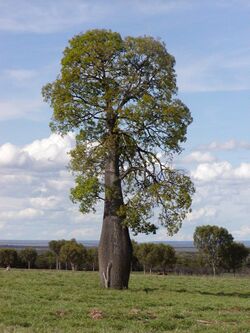
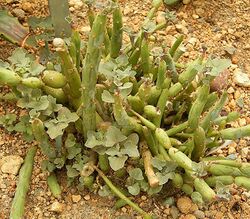
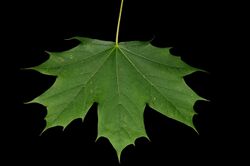
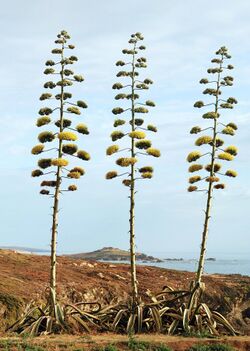
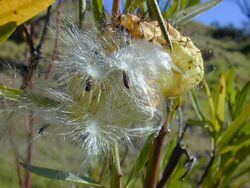
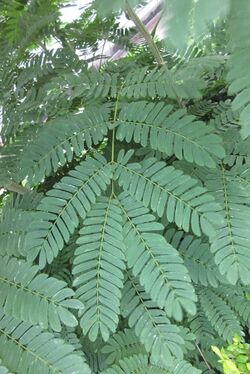
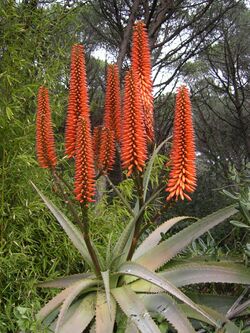
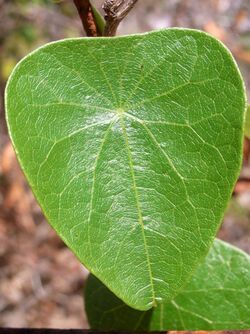
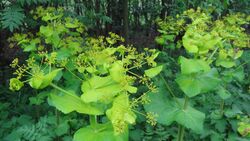
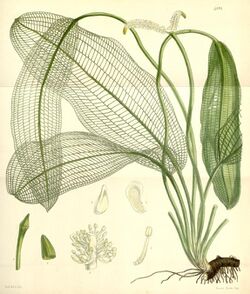
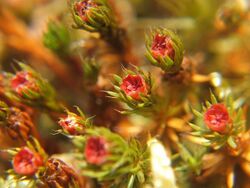
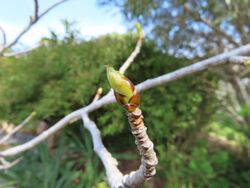
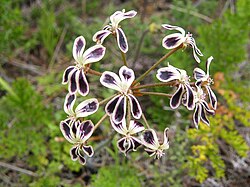
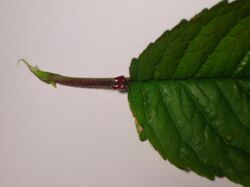
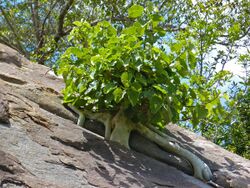
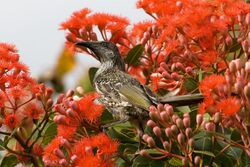
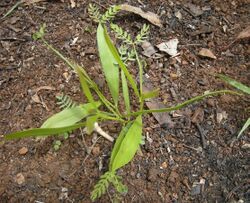
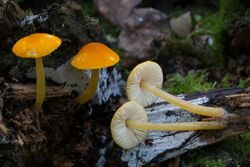
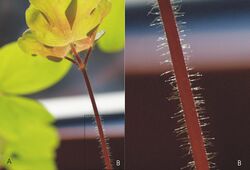
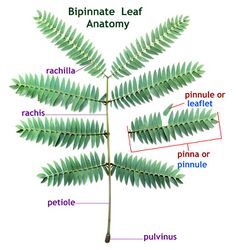
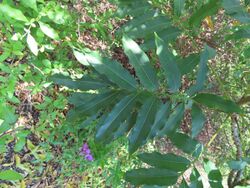
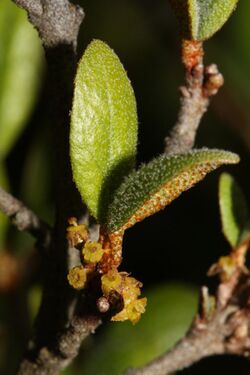
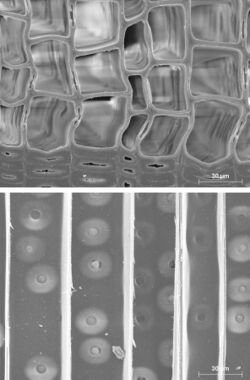
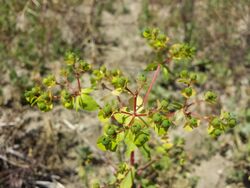
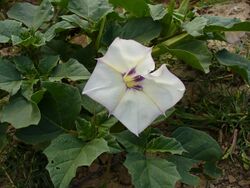
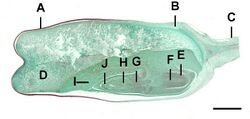
A=pericarp, B=aleurone, C=stalk, D=endosperm, E=coleorhiza, F=radicle, G=hypocotyl, H=plumule, I=scutellum, J=coleoptile
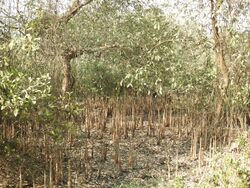
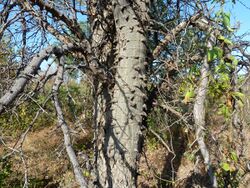
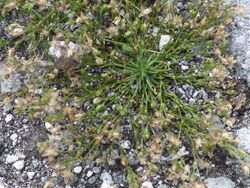

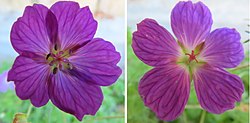
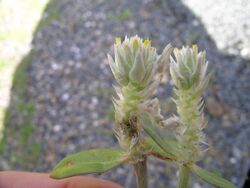
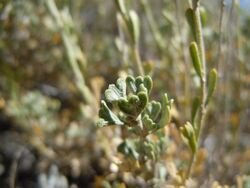
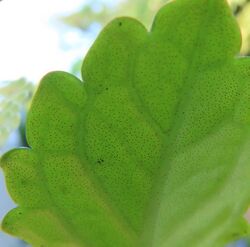
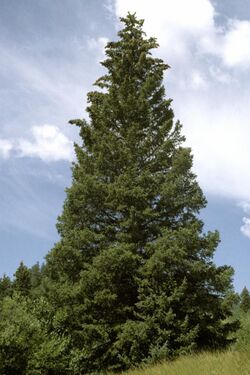
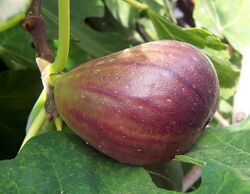
Q
- More or less square.
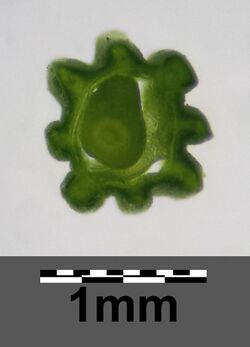
R
Lua error: Internal error: The interpreter has terminated with signal "24".
An indeterminate inflorescence in which the main axis produces a series of flowers on lateral stalks, the oldest at the base and the youngest at the top. Compare spike. Also racemiform or racemoid - having the form of a raceme.
<dt class="glossary " id="Lua error: Internal error: The interpreter has terminated with signal "24"." style="margin-top: 0.4em;">rachilla (rhachilla)
- 1. the axis of a grass spikelet, above the glumes; see spikelet.
- 2. the rachis of higher order in leaves that are compound more than once <dt class="glossary " id="Lua error: Internal error: The interpreter has terminated with signal "24"." style="margin-top: 0.4em;">rachis
Lua error: Internal error: The interpreter has terminated with signal "24".
The axis of an inflorescence or a pinnate leaf; for example ferns; secondary rachis is the axis of a pinna in a bipinnate leaf distal to and including the lowermost pedicel attachment.
<dt class="glossary " id="Lua error: Internal error: The interpreter has terminated with signal "24"." style="margin-top: 0.4em;">radial
- With structures radiating from a central point as spokes on a wheel (e.g. the lateral spines of a cactus). <dt class="glossary " id="Lua error: Internal error: The interpreter has terminated with signal "24"." style="margin-top: 0.4em;">radiate
- (of daisies, of a capitulum) With ray floret surrounding disc florets. <dt class="glossary " id="Lua error: Internal error: The interpreter has terminated with signal "24"." style="margin-top: 0.4em;">radical
- Springing from the root; clustered at base of stem. <dt class="glossary " id="Lua error: Internal error: The interpreter has terminated with signal "24"." style="margin-top: 0.4em;">radicle
- The part of an embryo giving rise to the root system of a plant. Compare plumule. <dt class="glossary " id="Lua error: Internal error: The interpreter has terminated with signal "24"." style="margin-top: 0.4em;">rainforest
- A moist temperate or tropical forest dominated by broad-leaved trees that form a continuous canopy. <dt class="glossary " id="Lua error: Internal error: The interpreter has terminated with signal "24"." style="margin-top: 0.4em;">ramet
- An individual member of a clone. <dt class="glossary " id="Lua error: Internal error: The interpreter has terminated with signal "24"." style="margin-top: 0.4em;">ramicaul
- a single-leafed stem, as in Pleurothallis orchids.Lua error: Internal error: The interpreter has terminated with signal "24".Lua error: Internal error: The interpreter has terminated with signal "24". <dt class="glossary " id="Lua error: Internal error: The interpreter has terminated with signal "24"." style="margin-top: 0.4em;">ramify
- To divide or spread out into individual branches or branchlike parts. <dt class="glossary " id="Lua error: Internal error: The interpreter has terminated with signal "24"." style="margin-top: 0.4em;">ray
- 1. zygomorphic (ligulate) flowers in a radiate flowerhead, that is, ray-florets/flowers, for example Asteraceae.
- 2. each of the branches of an umbel. <dt class="glossary " id="Lua error: Internal error: The interpreter has terminated with signal "24"." style="margin-top: 0.4em;">receptacle
- the axis of a flower, in other words, floral axis; torus; for example in Asteraceae, the floral base or receptacle is the expanded tip of the peduncle on which the flowers are inserted. <dt class="glossary " id="Lua error: Internal error: The interpreter has terminated with signal "24"." style="margin-top: 0.4em;">recumbent
- bent back toward or below the horizontal. <dt class="glossary " id="Lua error: Internal error: The interpreter has terminated with signal "24"." style="margin-top: 0.4em;">recurved
- bent or curved backward or downward. <dt class="glossary " id="Lua error: Internal error: The interpreter has terminated with signal "24"." style="margin-top: 0.4em;">reduplicate
- folded outward, or with the two abaxial surfaces together. <dt class="glossary " id="Lua error: Internal error: The interpreter has terminated with signal "24"." style="margin-top: 0.4em;">reflexed
- bent sharply back or down. <dt class="glossary " id="Lua error: Internal error: The interpreter has terminated with signal "24"." style="margin-top: 0.4em;">registered name
- a cultivar name accepted by the relevant International Cultivar Registration Authority. <dt class="glossary " id="Lua error: Internal error: The interpreter has terminated with signal "24"." style="margin-top: 0.4em;">registration
- 1. the act of recording a new cultivar name with an International Cultivar Registration Authority.
- 2. recording a new cultivar name with a statutory authority like the Plant Breeder’s Rights Office.
- 3. recording a trademark with a trade marks office. <dt class="glossary " id="Lua error: Internal error: The interpreter has terminated with signal "24"." style="margin-top: 0.4em;">regular
- See actinomorphic. <dt class="glossary " id="Lua error: Internal error: The interpreter has terminated with signal "24"." style="margin-top: 0.4em;">reniform
- Kidney-shaped. <dt class="glossary " id="Lua error: Internal error: The interpreter has terminated with signal "24"." style="margin-top: 0.4em;">replum
- a framework-like placenta to which the seeds attach, and which remains after each valve drops away. <dt class="glossary " id="Lua error: Internal error: The interpreter has terminated with signal "24"." style="margin-top: 0.4em;">resupinate
- Describing leaves or flowers that are in an inverted position because the petiole or pedicel, respectively, is twisted 180 degrees. compare: hyper-resupinate. <dt class="glossary " id="Lua error: Internal error: The interpreter has terminated with signal "24"." style="margin-top: 0.4em;">reticulate
- forming a network (or reticulum), e.g. veins that join one another at more than one point. <dt class="glossary " id="Lua error: Internal error: The interpreter has terminated with signal "24"." style="margin-top: 0.4em;">retrorse
- Bent backward or downward. Compare antrorse. <dt class="glossary " id="Lua error: Internal error: The interpreter has terminated with signal "24"." style="margin-top: 0.4em;">retuse
- Having a blunt (obtuse) and slightly notched apex. <dt class="glossary " id="Lua error: Internal error: The interpreter has terminated with signal "24"." style="margin-top: 0.4em;">revision
- an account of a particular plant group, like an abbreviated or simplified monograph. Sometimes confined to the plants of a particular region. Similar to a monograph in clearly distinguishing the taxa and providing a means for their identification. Compare monograph. <dt class="glossary " id="Lua error: Internal error: The interpreter has terminated with signal "24"." style="margin-top: 0.4em;">revolute
- rolled under (downward or backward), for example when the edges of leaves are rolled under toward the midrib. Compare involute. <dt class="glossary " id="Lua error: Internal error: The interpreter has terminated with signal "24"." style="margin-top: 0.4em;">rhachis
- See rachis. <dt class="glossary " id="Lua error: Internal error: The interpreter has terminated with signal "24"." style="margin-top: 0.4em;">rhizodermis
- the root epidermis, the outermost primary cell layer of the root <dt class="glossary " id="Lua error: Internal error: The interpreter has terminated with signal "24"." style="margin-top: 0.4em;">rhizome
- a perennial underground stem usually growing horizontally. See also stolon. Abbreviation: rhiz. <dt class="glossary " id="Lua error: Internal error: The interpreter has terminated with signal "24"." style="margin-top: 0.4em;">rhizomatous
- (adj.) having above-ground stems that are derived from below-ground stems (rhizomes). Compare arhizomatous (arhizomatic). <dt class="glossary " id="Lua error: Internal error: The interpreter has terminated with signal "24"." style="margin-top: 0.4em;">rhizosphere
- the below-ground surface of plants and adjacent soil as a habitat for microorganisms. <dt class="glossary " id="Lua error: Internal error: The interpreter has terminated with signal "24"." style="margin-top: 0.4em;">rhytidome
- the dead region of the bark and root that lies outside the periderm. <dt class="glossary " id="Lua error: Internal error: The interpreter has terminated with signal "24"." style="margin-top: 0.4em;">rhombic
- like a rhombus: an oblique figure with four equal sides. Compare trapeziform and trullate. <dt class="glossary " id="Lua error: Internal error: The interpreter has terminated with signal "24"." style="margin-top: 0.4em;">rhomboid
- a four-sided figure with opposite sides parallel but with adjacent sides an unequal length (like an oblique rectangle); see also rhombic. <dt class="glossary " id="Lua error: Internal error: The interpreter has terminated with signal "24"." style="margin-top: 0.4em;">rhomboidal
- a shape, for instance of a leaf, that is roughly diamond-shaped with length equal to width. <dt class="glossary " id="Lua error: Internal error: The interpreter has terminated with signal "24"." style="margin-top: 0.4em;">rimose
- with many cracks, as in the surface of a crustose areolate lichen. <dt class="glossary " id="Lua error: Internal error: The interpreter has terminated with signal "24"." style="margin-top: 0.4em;">root
- a unit of a plant's axial system which is usually underground, does not bear leaves, tends to grow downward, and is typically derived from the radicle of the embryo. <dt class="glossary " id="Lua error: Internal error: The interpreter has terminated with signal "24"." style="margin-top: 0.4em;">root hairs
- outgrowths of the outermost layer of cells just behind the root tips, functioning as water-absorbing organs. <dt class="glossary " id="Lua error: Internal error: The interpreter has terminated with signal "24"." style="margin-top: 0.4em;">root microbiome
- the dynamic community of microorganisms associated with plant roots. <dt class="glossary " id="Lua error: Internal error: The interpreter has terminated with signal "24"." style="margin-top: 0.4em;">rootstock
- 1. the part of a budded or grafted plant which supplies the root system, also simply called a stock.
- 2. plants selected to produce a root system with some specific attribute, e.g. a virus-free rootstock. <dt class="glossary " id="Lua error: Internal error: The interpreter has terminated with signal "24"." style="margin-top: 0.4em;">rosette
- when parts are not whorled or opposite but appear so, due to the contractions of internodes, e.g. the petals in a double rose or a basal cluster of leaves (usually close to the ground) in some plants. <dt class="glossary " id="Lua error: Internal error: The interpreter has terminated with signal "24"." style="margin-top: 0.4em;">rostellate
- possessing a beak (rostellum). Synonym of rostrate. <dt class="glossary " id="Lua error: Internal error: The interpreter has terminated with signal "24"." style="margin-top: 0.4em;">rostrate
- with a beak. <dt class="glossary " id="Lua error: Internal error: The interpreter has terminated with signal "24"." style="margin-top: 0.4em;">rotate
- circular and flattened; for example a corolla with a very short tube and spreading lobes (for instance some Solanaceae). <dt class="glossary " id="Lua error: Internal error: The interpreter has terminated with signal "24"." style="margin-top: 0.4em;">ruderal
- a plant that colonises or occupies disturbed waste ground. See also weed. <dt class="glossary " id="Lua error: Internal error: The interpreter has terminated with signal "24"." style="margin-top: 0.4em;">rudiment
- In the structure of a plant, an item that is at best hardly functional, either because it is immature and has not yet completed its development (such as a leaf still incompletely formed inside a bud), or because its role in the organism's morphology cannot be completed and therefore is futile (such as the leaf rudiment at the tip of a phyllode, that will be shed while immature, because the leaf function will be taken over by the phyllode). Compare cataphyll and vestige. <dt class="glossary " id="Lua error: Internal error: The interpreter has terminated with signal "24"." style="margin-top: 0.4em;">rudimentary
- Being of the nature of a rudiment; at most barely functional because incompletely developed; begun, but far from completed, either temporarily or permanently. Compare vestigial. <dt class="glossary " id="Lua error: Internal error: The interpreter has terminated with signal "24"." style="margin-top: 0.4em;">rugose
- Wrinkled, either covered with wrinkles, or crumpled like a wrinkled leaf, either as a stiffening structure, or in response to disease or insect damage. <dt class="glossary " id="Lua error: Internal error: The interpreter has terminated with signal "24"." style="margin-top: 0.4em;">rugulose
- Finely wrinkled. <dt class="glossary " id="Lua error: Internal error: The interpreter has terminated with signal "24"." style="margin-top: 0.4em;">ruminate
- (usually applied to endosperm) Irregularly grooved or ridged; appearing chewed, e.g. the endosperm in certain members of Myristicaceae. <dt class="glossary " id="Lua error: Internal error: The interpreter has terminated with signal "24"." style="margin-top: 0.4em;">runcinate
- Sharply pinnatifid or cleft, with the segments directed downward. <dt class="glossary " id="Lua error: Internal error: The interpreter has terminated with signal "24"." style="margin-top: 0.4em;">runner
- See stolon. <dt class="glossary " id="Lua error: Internal error: The interpreter has terminated with signal "24"." style="margin-top: 0.4em;">rupicolous
- Rupestral, saxicolous, growing on or among rocks. Compare epilithic and lithophytic. <dt class="glossary " id="Lua error: Internal error: The interpreter has terminated with signal "24"." style="margin-top: 0.4em;">rush
- A plant of the family Juncaceae or, more loosely, applied to various monocotyledons.
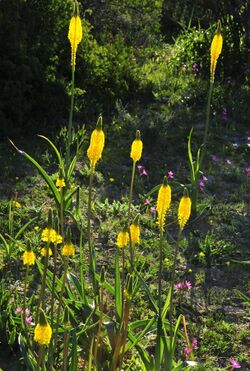

B. Pinnule
C. Jugary glands
D. Juga (plural of jugum)
E. Base of petiole
F. Petiolary gland
G. Rachis
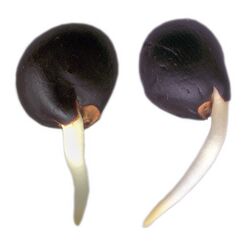
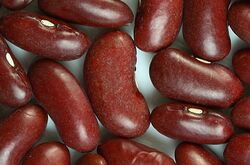
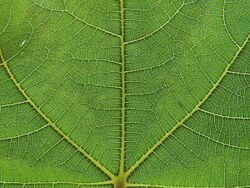
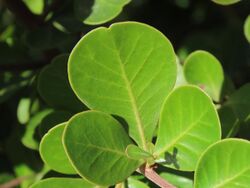
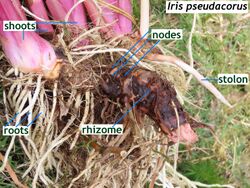
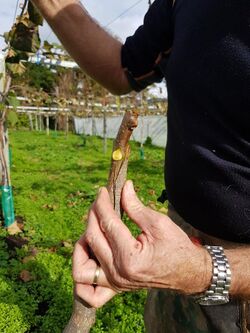
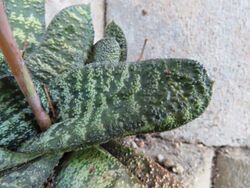
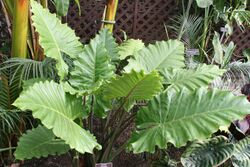
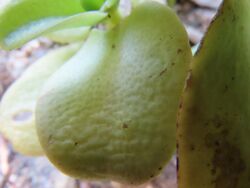
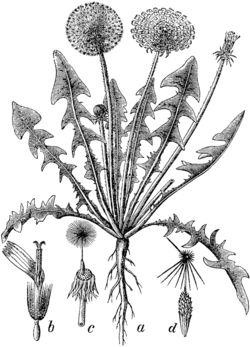
S
- Pouched or shaped like a sack. <dt class="glossary " id="Lua error: Internal error: The interpreter has terminated with signal "24"." style="margin-top: 0.4em;">sagittate
- Shaped like the head of an arrow; narrow and pointed but gradually enlarged at the base into two straight lobes directed downward; may refer only to the base of a leaf with such lobes. Compare hastate. <dt class="glossary " id="Lua error: Internal error: The interpreter has terminated with signal "24"." style="margin-top: 0.4em;">salverform
- Shaped like a salver - Trumpet-shaped; having a long, slender tube and a flat, abruptly expanded limb <dt class="glossary " id="Lua error: Internal error: The interpreter has terminated with signal "24"." style="margin-top: 0.4em;">samara
- A dry, indehiscent fruit with its wall expanded into a wing, e.g. in the genus Acer. <dt class="glossary " id="Lua error: Internal error: The interpreter has terminated with signal "24"." style="margin-top: 0.4em;">samphire
- A common name given to various edible coastal plants, such as Salicornia spp. (Amaranthaceae), Crithmum maritimum (Apiaceae) and Limbarda crithmoides (Asteraceae). <dt class="glossary " id="Lua error: Internal error: The interpreter has terminated with signal "24"." style="margin-top: 0.4em;">sanguine
- (from Latin sanguineus) Blood-colored: crimson; the color of blood. <dt class="glossary " id="Lua error: Internal error: The interpreter has terminated with signal "24"." style="margin-top: 0.4em;">saprophyte
Lua error: Internal error: The interpreter has terminated with signal "24".
A plant, or loosely speaking, a fungus or similar organism, deriving its nourishment from decaying organic matter such as dead wood or humus, and usually lacking chlorophyll. Compare parasite, saprotroph, and epiphyte.
<dt class="glossary " id="Lua error: Internal error: The interpreter has terminated with signal "24"." style="margin-top: 0.4em;">saprotroph
Lua error: Internal error: The interpreter has terminated with signal "24".
An organism deriving its nourishment from decaying organic matter. Contrast parasite and epiphyte.
<dt class="glossary " id="Lua error: Internal error: The interpreter has terminated with signal "24"." style="margin-top: 0.4em;">sarment
- A long, slender, prostrate stolon, commonly called a runner. <dt class="glossary " id="Lua error: Internal error: The interpreter has terminated with signal "24"." style="margin-top: 0.4em;">sarmentose
- Reproducing by sarments; strawberry plants are the most familiar example. <dt class="glossary " id="Lua error: Internal error: The interpreter has terminated with signal "24"." style="margin-top: 0.4em;">saxicolous
- Growing on stone, like some lichens. <dt class="glossary " id="Lua error: Internal error: The interpreter has terminated with signal "24"." style="margin-top: 0.4em;">scabrid .
Lua error: Internal error: The interpreter has terminated with signal "24".
Rough to the touch, with short hard protrusions or hairs.
<dt class="glossary " id="Lua error: Internal error: The interpreter has terminated with signal "24"." style="margin-top: 0.4em;">scalariform
- Ladder-like in structure or appearance. <dt class="glossary " id="Lua error: Internal error: The interpreter has terminated with signal "24"." style="margin-top: 0.4em;">scale
- 1. A reduced or rudimentary leaf, for example around a dormant bud.
- 2. A flattened epidermal outgrowth, such as those commonly found on the leaves and rhizomes of ferns. <dt class="glossary " id="Lua error: Internal error: The interpreter has terminated with signal "24"." style="margin-top: 0.4em;">scandent
- Climbing, by whatever means. See also: scandent in Wiktionary. <dt class="glossary " id="Lua error: Internal error: The interpreter has terminated with signal "24"." style="margin-top: 0.4em;">scape
Lua error: Internal error: The interpreter has terminated with signal "24".
Usages vary, e.g.: a leafless peduncle arising directly from the ground, or a stem-like flowering stalk of a plant with radical leaves.
<dt class="glossary " id="Lua error: Internal error: The interpreter has terminated with signal "24"." style="margin-top: 0.4em;">scapose
- Having the floral axis more or less erect with few or no leaves; consisting of a scape. <dt class="glossary " id="Lua error: Internal error: The interpreter has terminated with signal "24"." style="margin-top: 0.4em;">scarious
- Dry and membranous. <dt class="glossary " id="Lua error: Internal error: The interpreter has terminated with signal "24"." style="margin-top: 0.4em;">schizocarp
- A dry fruit formed from more than one carpel but breaking apart into individual carpels (mericarp) when ripe. For illustration, see mericarp <dt class="glossary " id="Lua error: Internal error: The interpreter has terminated with signal "24"." style="margin-top: 0.4em;">scion
- The aerial part of a graft combination, induced by various means to unite with a compatible understock or rootstock. <dt class="glossary " id="Lua error: Internal error: The interpreter has terminated with signal "24"." style="margin-top: 0.4em;">sclereid
- A cell with a thick, lignified, cell wall that is shorter than a fiber cell and dies soon after the thickening of its cell wall. <dt class="glossary " id="Lua error: Internal error: The interpreter has terminated with signal "24"." style="margin-top: 0.4em;">sclerenchyma
- A strengthening or supporting tissue composed of sclereids or of a mixture of sclereids and fibers. <dt class="glossary " id="Lua error: Internal error: The interpreter has terminated with signal "24"." style="margin-top: 0.4em;">sclerophyll
Lua error: Internal error: The interpreter has terminated with signal "24".
A plant with hard, stiff leaves; any structure stiffened with thick-walled cells.
<dt class="glossary " id="Lua error: Internal error: The interpreter has terminated with signal "24"." style="margin-top: 0.4em;">scorpioid
- (of a cymose inflorescence) Branching alternately on one side and then the other. Compare helicoid. <dt class="glossary " id="Lua error: Internal error: The interpreter has terminated with signal "24"." style="margin-top: 0.4em;">scrobiculate
- Having very small pits. <dt class="glossary " id="Lua error: Internal error: The interpreter has terminated with signal "24"." style="margin-top: 0.4em;">scrubland
- Dense vegetation dominated by shruba. <dt class="glossary " id="Lua error: Internal error: The interpreter has terminated with signal "24"." style="margin-top: 0.4em;">scurf
- Minute, loose, membranous scales on the surface of some plant parts, such as leaves. <dt class="glossary " id="Lua error: Internal error: The interpreter has terminated with signal "24"." style="margin-top: 0.4em;">secondary metabolite
- Chemicals produced by a plant that do not have a role in so-called primary functions such as growth, development, photosynthesis, reproduction, etc. <dt class="glossary " id="Lua error: Internal error: The interpreter has terminated with signal "24"." style="margin-top: 0.4em;">secretory tissue
- The tissues concerned with the secretion of gums, resins, oils and other substances in plants. <dt class="glossary " id="Lua error: Internal error: The interpreter has terminated with signal "24"." style="margin-top: 0.4em;">section (sectio)
- The category of supplementary taxa intermediate in rank between subgenus and series. It is a singular noun always written with a capital initial letter, in combination with the generic name. <dt class="glossary " id="Lua error: Internal error: The interpreter has terminated with signal "24"." style="margin-top: 0.4em;">secund
- Having all the parts grouped on one side or turned to one side (applied especially to inflorescences). <dt class="glossary " id="Lua error: Internal error: The interpreter has terminated with signal "24"." style="margin-top: 0.4em;">sedge
- A plant of the family Cyperaceae. <dt class="glossary " id="Lua error: Internal error: The interpreter has terminated with signal "24"." style="margin-top: 0.4em;">seed
- A ripened ovule, consisting of a protective coat enclosing an embryo and food reserves; a propagating organ formed in the sexual reproductive cycle of gymnosperms and angiosperms (together, the seed plants). <dt class="glossary " id="Lua error: Internal error: The interpreter has terminated with signal "24"." style="margin-top: 0.4em;">segment
- A part or subdivision of an organ, e.g. a petal is a segment of the corolla. A term sometimes used when the sepals and petals are indistinguishable. <dt class="glossary " id="Lua error: Internal error: The interpreter has terminated with signal "24"." style="margin-top: 0.4em;">self-pollination
- (also selfing) The acceptance by stigmas of pollen from the same flower or from flowers on the same plant, which means they are self-compatible. <dt class="glossary " id="Lua error: Internal error: The interpreter has terminated with signal "24"." style="margin-top: 0.4em;">semaphyll
- A structure such as a bract or sepal (if the remainder of the perianth is inconspicuous) which has become modified to attract pollinators. <dt class="glossary " id="Lua error: Internal error: The interpreter has terminated with signal "24"." style="margin-top: 0.4em;">semelparity
- When a plant flowers once then dies. <dt class="glossary " id="Lua error: Internal error: The interpreter has terminated with signal "24"." style="margin-top: 0.4em;">semiterete
- Rounded on one side but flat on the other. See also terete. <dt class="glossary " id="Lua error: Internal error: The interpreter has terminated with signal "24"." style="margin-top: 0.4em;">senecioid
- See anthemoid. <dt class="glossary " id="Lua error: Internal error: The interpreter has terminated with signal "24"." style="margin-top: 0.4em;">sensitive
- A descriptive term for stigmas that, in response to touch, close the two lobes of the stigma together, ending the receptivity of the stigma, at least for the time that the lobes are closed together. Mimulus is perhaps the best-known example. <dt class="glossary " id="Lua error: Internal error: The interpreter has terminated with signal "24"." style="margin-top: 0.4em;">sensu
- In the sense of. <dt class="glossary " id="Lua error: Internal error: The interpreter has terminated with signal "24"." style="margin-top: 0.4em;">sensu auct.
- (of a plant group or name) As cited by a named authority. <dt class="glossary " id="Lua error: Internal error: The interpreter has terminated with signal "24"." style="margin-top: 0.4em;">sensu amplo
- (of a plant group or name) In a generous or ample sense. <dt class="glossary " id="Lua error: Internal error: The interpreter has terminated with signal "24"." style="margin-top: 0.4em;">sensu lato
- (of a plant group) In a broad sense. <dt class="glossary " id="Lua error: Internal error: The interpreter has terminated with signal "24"." style="margin-top: 0.4em;">sensu strictissimo
- (of a plant group) In the narrowest sense. <dt class="glossary " id="Lua error: Internal error: The interpreter has terminated with signal "24"." style="margin-top: 0.4em;">sensu stricto
- (of a plant group) In a narrow sense. <dt class="glossary " id="Lua error: Internal error: The interpreter has terminated with signal "24"." style="margin-top: 0.4em;">sepal
- In a flower, one of the segments or divisions of the outer whorl of non-fertile parts surrounding the fertile organs; usually green. Compare petal, tepal. <dt class="glossary " id="Lua error: Internal error: The interpreter has terminated with signal "24"." style="margin-top: 0.4em;">septicidal
- (of a fruit) Dehiscing along the partitions between loculi. Compare loculicidal. <dt class="glossary " id="Lua error: Internal error: The interpreter has terminated with signal "24"." style="margin-top: 0.4em;">septum
Lua error: Internal error: The interpreter has terminated with signal "24".
A partition, e.g. the membranous wall separating the two valves of the pod of Brassicaceae.
<dt class="glossary " id="Lua error: Internal error: The interpreter has terminated with signal "24"." style="margin-top: 0.4em;">seriate
- Arranged in rows. <dt class="glossary " id="Lua error: Internal error: The interpreter has terminated with signal "24"." style="margin-top: 0.4em;">sericeous
- Silky with dense appressed hairs. <dt class="glossary " id="Lua error: Internal error: The interpreter has terminated with signal "24"." style="margin-top: 0.4em;">series
- The category of supplementary taxa intermediate in rank between section and species. It is often used as a plural adjective, as in "Primula subgenus Primula sect. Primula series Acaules". <dt class="glossary " id="Lua error: Internal error: The interpreter has terminated with signal "24"." style="margin-top: 0.4em;">serrate
- Toothed with asymmetrical teeth pointing forward; like the cutting edge of a saw. <dt class="glossary " id="Lua error: Internal error: The interpreter has terminated with signal "24"." style="margin-top: 0.4em;">serrulate
- Finely serrate. <dt class="glossary " id="Lua error: Internal error: The interpreter has terminated with signal "24"." style="margin-top: 0.4em;">sessile
- Attached without a stalk, e.g. of a leaf without a petiole or a stigma, when the style is absent. <dt class="glossary " id="Lua error: Internal error: The interpreter has terminated with signal "24"." style="margin-top: 0.4em;">seta
Lua error: Internal error: The interpreter has terminated with signal "24".
A bristle or stiff hair (in Bryophytes, the stalk of the sporophyte). A terminal seta is an appendage to the tip of an organ, e.g. the primary rachis of a bipinnate leaf in Acacia.
<dt class="glossary " id="Lua error: Internal error: The interpreter has terminated with signal "24"." style="margin-top: 0.4em;">sheath
- A tubular or rolled part of an organ, e.g. the lower part of the leaf in most grasses. <dt class="glossary " id="Lua error: Internal error: The interpreter has terminated with signal "24"." style="margin-top: 0.4em;">shoot
- The aerial part of a plant; a stem and all of its dependent parts (leaves, flowers, etc.). <dt class="glossary " id="Lua error: Internal error: The interpreter has terminated with signal "24"." style="margin-top: 0.4em;">shrub
- A woody perennial plant without a single main trunk, branching freely, and generally smaller than a tree. <dt class="glossary " id="Lua error: Internal error: The interpreter has terminated with signal "24"." style="margin-top: 0.4em;">sigmoid
- Shaped like the letter 'S'. <dt class="glossary " id="Lua error: Internal error: The interpreter has terminated with signal "24"." style="margin-top: 0.4em;">silicula or silicle
- A fruit like a siliqua, but stouter, not more than twice as long as wide. <dt class="glossary " id="Lua error: Internal error: The interpreter has terminated with signal "24"." style="margin-top: 0.4em;">silique <dt class="glossary " id="Lua error: Internal error: The interpreter has terminated with signal "24"." style="margin-top: -0.2em;">siliqua
- A dry, dehiscent fruit (in contrast to a silicula, more than twice as long as wide) formed from a superior ovary of two carpels, with two parietal placentas and divided into two loculi by a 'false' septum. <dt class="glossary " id="Lua error: Internal error: The interpreter has terminated with signal "24"." style="margin-top: 0.4em;">silky
- Densely covered with fine, soft, straight, appressed hairs, with a lustrous sheen and satiny to the touch. <dt class="glossary " id="Lua error: Internal error: The interpreter has terminated with signal "24"." style="margin-top: 0.4em;">silviculture
- The science of forestry and the cultivation of woodlands for commercial purposes and wildlife conservation. <dt class="glossary " id="Lua error: Internal error: The interpreter has terminated with signal "24"." style="margin-top: 0.4em;">simple
- Undivided or unsegmented, e.g. a leaf not divided into leaflets (note, however, that a simple leaf may still be entire, toothed or lobed) or an unbranched hair or inflorescence. <dt class="glossary " id="Lua error: Internal error: The interpreter has terminated with signal "24"." style="margin-top: 0.4em;">sinuate
- Having deep, wave-like depressions along the margins, but more or less flat. Compare undulate. <dt class="glossary " id="Lua error: Internal error: The interpreter has terminated with signal "24"." style="margin-top: 0.4em;">sinus
- A notch or depression between two lobes or teeth in the margin of an organ. <dt class="glossary " id="Lua error: Internal error: The interpreter has terminated with signal "24"." style="margin-top: 0.4em;">solitary
- Single, of flowers that grow one plant per year, one in each axil, or widely separated on the plant; not grouped in an inflorescence. <dt class="glossary " id="Lua error: Internal error: The interpreter has terminated with signal "24"." style="margin-top: 0.4em;">sorus
Lua error: Internal error: The interpreter has terminated with signal "24".
A cluster of sporangia. Sori typically occur in ferns, some Algae and some fungi. In many fern species the sorus is covered by a protective indusium.
<dt class="glossary " id="Lua error: Internal error: The interpreter has terminated with signal "24"." style="margin-top: 0.4em;">sp.
- An abbreviation of species (singular), often used when the genus is known but the species has not been determined, as in "Brassica sp." See spp.. <dt class="glossary " id="Lua error: Internal error: The interpreter has terminated with signal "24"." style="margin-top: 0.4em;">spp.
- An abbreviation of species (plural), often used to collectively refer to more than one species of the same genus, as in "Astragalus spp." See sp.. <dt class="glossary " id="Lua error: Internal error: The interpreter has terminated with signal "24"." style="margin-top: 0.4em;">spadix
- A spicate (spike-like) inflorescence with the flowers crowded densely, even solidly, around a stout, often succulent axis. Particularly typical of the family Araceae <dt class="glossary " id="Lua error: Internal error: The interpreter has terminated with signal "24"." style="margin-top: 0.4em;">spathe
Lua error: Internal error: The interpreter has terminated with signal "24".
A large bract ensheathing an inflorescence. Traditionally any broad, flat blade.
<dt class="glossary " id="Lua error: Internal error: The interpreter has terminated with signal "24"." style="margin-top: 0.4em;">spathulate or spatulate
- Spoon-shaped; broad at the tip with a narrowed projection extending to the base. <dt class="glossary " id="Lua error: Internal error: The interpreter has terminated with signal "24"." style="margin-top: 0.4em;">species
- A group, or populations of individuals, sharing common features and/or ancestry, generally the smallest group that can be readily and consistently recognized; often, a group of individuals capable of interbreeding and producing fertile offspring. The basic unit of classification, the category of taxa of the lowest principal rank in the nomenclatural hierarchy. Strict assignment to a species is not always possible, as it is subject to particular contexts, and the species concept under consideration. <dt class="glossary " id="Lua error: Internal error: The interpreter has terminated with signal "24"." style="margin-top: 0.4em;">specific epithet
- Follows the name of the genus, and is the second word of a botanical binomial. The generic name and specific epithet together constitute the name of a species, i.e. the specific epithet is not the species name. <dt class="glossary " id="Lua error: Internal error: The interpreter has terminated with signal "24"." style="margin-top: 0.4em;">speirochoric
- Unintentional introduction by seeds.Lua error: Internal error: The interpreter has terminated with signal "24".Lua error: Internal error: The interpreter has terminated with signal "24". Compare agochoric. <dt class="glossary " id="Lua error: Internal error: The interpreter has terminated with signal "24"." style="margin-top: 0.4em;">spica
Lua error: Internal error: The interpreter has terminated with signal "24".
Another name for a spike.
<dt class="glossary " id="Lua error: Internal error: The interpreter has terminated with signal "24"." style="margin-top: 0.4em;">spike
Lua error: Internal error: The interpreter has terminated with signal "24".
An unbranched, indeterminate inflorescence in which the flowers are without stalks. Compare raceme.
<dt class="glossary " id="Lua error: Internal error: The interpreter has terminated with signal "24"." style="margin-top: 0.4em;">spikelet
- A subunit of a spike inflorescence, especially in grasses, sedges, and some other monocotyledons, consisting of one to many flowers and associated bracts or glumes. <dt class="glossary " id="Lua error: Internal error: The interpreter has terminated with signal "24"." style="margin-top: 0.4em;">spine
Lua error: Internal error: The interpreter has terminated with signal "24".
A stiff, sharp structure formed by the modification of a plant organ that contains vascular tissue, e.g. a lateral branch or a stipule; includes thorns.
<dt class="glossary " id="Lua error: Internal error: The interpreter has terminated with signal "24"." style="margin-top: 0.4em;">spinescent
- Ending in a spine; modified to form a spine. <dt class="glossary " id="Lua error: Internal error: The interpreter has terminated with signal "24"." style="margin-top: 0.4em;">spiral
- Of arrangement, when plant parts are arranged in a succession of curves like the thread of a screw, or coiled in a cylindrical or conical manner. <dt class="glossary " id="Lua error: Internal error: The interpreter has terminated with signal "24"." style="margin-top: 0.4em;">splash-cup (sporangia)
- A cup-like structure in fungi such as Nidulariaceae and in cryptogams such as some mosses. The cups function in spore dispersal, in which the energy of raindrops falling into the cup causes the water to splash outward carrying the spores.Lua error: Internal error: The interpreter has terminated with signal "24".Lua error: Internal error: The interpreter has terminated with signal "24". <dt class="glossary " id="Lua error: Internal error: The interpreter has terminated with signal "24"." style="margin-top: 0.4em;">sporangium (sporangia)
- A structure in which spores are formed and from which the mature spores are released <dt class="glossary " id="Lua error: Internal error: The interpreter has terminated with signal "24"." style="margin-top: 0.4em;">sporangiophore
- An organ bearing sporangia, e.g. the cones of Equisetum. <dt class="glossary " id="Lua error: Internal error: The interpreter has terminated with signal "24"." style="margin-top: 0.4em;">spore
- A haploid propagule, produced by meiosis in diploid cells of a sporophyte that can germinate to produce a multicellular gametophyte. <dt class="glossary " id="Lua error: Internal error: The interpreter has terminated with signal "24"." style="margin-top: 0.4em;">sporocarp
- A fruiting body containing spores. <dt class="glossary " id="Lua error: Internal error: The interpreter has terminated with signal "24"." style="margin-top: 0.4em;">sporophyll
- In pteridophytes, a modified leaf that bears a sporangium or sporangia. <dt class="glossary " id="Lua error: Internal error: The interpreter has terminated with signal "24"." style="margin-top: 0.4em;">sporophyte
- The diploid multicellular phase in the alternation of generations of plants and algae that produces the spores. Compare gametophyte. <dt class="glossary " id="Lua error: Internal error: The interpreter has terminated with signal "24"." style="margin-top: 0.4em;">sport
- A naturally occurring variant of a species, not usually present in a population or group of plants; a plant that has spontaneously mutated so that it differs from its parent plant. <dt class="glossary " id="Lua error: Internal error: The interpreter has terminated with signal "24"." style="margin-top: 0.4em;">spreading
- Extending horizontally, e.g. in branches. Standing out at right angles to an axis, e.g. in leaves or hairs. <dt class="glossary " id="Lua error: Internal error: The interpreter has terminated with signal "24"." style="margin-top: 0.4em;">spur
- 1. a short shoot.
- 2. a conical or tubular outgrowth from the base of a perianth segment, often containing nectar. <dt class="glossary " id="Lua error: Internal error: The interpreter has terminated with signal "24"." style="margin-top: 0.4em;">squamule
Lua error: Internal error: The interpreter has terminated with signal "24".
Small scales.
<dt class="glossary " id="Lua error: Internal error: The interpreter has terminated with signal "24"." style="margin-top: 0.4em;">squamulose
- Covered with small scales (squamules). <dt class="glossary " id="Lua error: Internal error: The interpreter has terminated with signal "24"." style="margin-top: 0.4em;">squarrose
- Having tips of leaves, stems, etc. radiating or projecting outward, e.g. in the moss Rhytidiadelphus squarrosus. <dt class="glossary " id="Lua error: Internal error: The interpreter has terminated with signal "24"." style="margin-top: 0.4em;">s.t.
- An abbreviation for "sometimes". Compare usu. and oft.. <dt class="glossary " id="Lua error: Internal error: The interpreter has terminated with signal "24"." style="margin-top: 0.4em;">stalk
- The supporting structure of an organ, usually narrower in diameter than the organ itself. <dt class="glossary " id="Lua error: Internal error: The interpreter has terminated with signal "24"." style="margin-top: 0.4em;">stamen
Lua error: Internal error: The interpreter has terminated with signal "24".
The male organ of a flower, consisting (usually) of a stalk called the filament and a pollen-bearing head called the anther.
<dt class="glossary " id="Lua error: Internal error: The interpreter has terminated with signal "24"." style="margin-top: 0.4em;">staminate flower
Lua error: Internal error: The interpreter has terminated with signal "24".
A flower with stamens but no pistil.
<dt class="glossary " id="Lua error: Internal error: The interpreter has terminated with signal "24"." style="margin-top: 0.4em;">staminode
- A sterile stamen, often rudimentary, sometimes petal-like. Commonly has a function in attracting pollinators that feed on the staminodes. <dt class="glossary " id="Lua error: Internal error: The interpreter has terminated with signal "24"." style="margin-top: 0.4em;">staminophore
- A structure, around the apex of eucalypt, myrtaceae hypanthia, that supports the stamens. <dt class="glossary " id="Lua error: Internal error: The interpreter has terminated with signal "24"." style="margin-top: 0.4em;">standard
- The large posterior petal of pea-flowers. <dt class="glossary " id="Lua error: Internal error: The interpreter has terminated with signal "24"." style="margin-top: 0.4em;">standard specimen
- A representative specimen of a cultivar or other taxon which demonstrates how the name of that taxon should be used. <dt class="glossary " id="Lua error: Internal error: The interpreter has terminated with signal "24"." style="margin-top: 0.4em;">stele
- The primary vascular system (including phloem, xylem, and ground tissue) of plant stems and roots. <dt class="glossary " id="Lua error: Internal error: The interpreter has terminated with signal "24"." style="margin-top: 0.4em;">stellate
- Star-shaped. <dt class="glossary " id="Lua error: Internal error: The interpreter has terminated with signal "24"." style="margin-top: 0.4em;">stem
- The plant axis, either aerial or subterranean, which bears nodes, leaves, branches, and flowers. <dt class="glossary " id="Lua error: Internal error: The interpreter has terminated with signal "24"." style="margin-top: 0.4em;">stem-clasping
- See amplexicaul. <dt class="glossary " id="Lua error: Internal error: The interpreter has terminated with signal "24"." style="margin-top: 0.4em;">stenospermocarpy
- The development or production of fruit that is seedless or has minute seeds because of the abortion of seed development. Compare parthenocarpy. <dt class="glossary " id="Lua error: Internal error: The interpreter has terminated with signal "24"." style="margin-top: 0.4em;">sterile
- Infertile, as with a stamen that does not bear pollen or a flower that does not bear seed. <dt class="glossary " id="Lua error: Internal error: The interpreter has terminated with signal "24"." style="margin-top: 0.4em;">stigma
- The pollen-receptive surface of a carpel or group of fused carpels, usually sticky; usually a point or small head at the summit of the style. <dt class="glossary " id="Lua error: Internal error: The interpreter has terminated with signal "24"." style="margin-top: 0.4em;">stipe
- Generally a small stalk or stalk-like structure. The stalk of a frond of a fern; the stalk supporting the pileus of a mushroom; the stalk of a seaweed such as a kelp; the stalk-like support of a gynaecium or a carpel <dt class="glossary " id="Lua error: Internal error: The interpreter has terminated with signal "24"." style="margin-top: 0.4em;">stipella
Lua error: Internal error: The interpreter has terminated with signal "24".
One of two small secondary stipules at the base of leaflets in some species.
<dt class="glossary " id="Lua error: Internal error: The interpreter has terminated with signal "24"." style="margin-top: 0.4em;">stipitate
- stalked; borne on a stipe; of an ovary, borne on a gynophore. <dt class="glossary " id="Lua error: Internal error: The interpreter has terminated with signal "24"." style="margin-top: 0.4em;">stipulate
- Bearing stipules. <dt class="glossary " id="Lua error: Internal error: The interpreter has terminated with signal "24"." style="margin-top: 0.4em;">stipule
- A small appendage at the bases of leaves in many dicotyledons. <dt class="glossary " id="Lua error: Internal error: The interpreter has terminated with signal "24"." style="margin-top: 0.4em;">stock
- See rootstock. <dt class="glossary " id="Lua error: Internal error: The interpreter has terminated with signal "24"." style="margin-top: 0.4em;">stolon
Lua error: Internal error: The interpreter has terminated with signal "24".
A slender, prostrate or trailing stem, producing roots and sometimes erect shoots at its nodes. See also rhizome.
<dt class="glossary " id="Lua error: Internal error: The interpreter has terminated with signal "24"." style="margin-top: 0.4em;">stoloniferous
- Having stolons. <dt class="glossary " id="Lua error: Internal error: The interpreter has terminated with signal "24"." style="margin-top: 0.4em;">stoma
Lua error: Internal error: The interpreter has terminated with signal "24".
A pore or small hole in the surface of a leaf (or other aerial organ) allowing the exchange of gases between tissues and the atmosphere.
<dt class="glossary " id="Lua error: Internal error: The interpreter has terminated with signal "24"." style="margin-top: 0.4em;">stone cell
- a sclereid cell, such as the cells that form the tissue of nut shells and the stones of drupes. <dt class="glossary " id="Lua error: Internal error: The interpreter has terminated with signal "24"." style="margin-top: 0.4em;">striate
- Striped with parallel, longitudinal lines or ridges. <dt class="glossary " id="Lua error: Internal error: The interpreter has terminated with signal "24"." style="margin-top: 0.4em;">strigillose
- Minutely strigose. <dt class="glossary " id="Lua error: Internal error: The interpreter has terminated with signal "24"." style="margin-top: 0.4em;">strigose
- Covered with appressed, straight, rigid, bristle-like hairs; the appressed equivalent of hispid. <dt class="glossary " id="Lua error: Internal error: The interpreter has terminated with signal "24"." style="margin-top: 0.4em;">strobilus
Lua error: Internal error: The interpreter has terminated with signal "24".
A cone-like structure consisting of sporophylls (e.g. conifers and club mosses) or sporangiophores (e.g. in Equisetopsida) borne close together on an axis.
<dt class="glossary " id="Lua error: Internal error: The interpreter has terminated with signal "24"." style="margin-top: 0.4em;">style
- An elongated part of a carpel or a group of fused carpels between the ovary and the stigma. <dt class="glossary " id="Lua error: Internal error: The interpreter has terminated with signal "24"." style="margin-top: 0.4em;">stylodium
- An elongate stigma that resembles a style; a false style, e.g. commonly found in the Poaceae and Asteraceae. <dt class="glossary " id="Lua error: Internal error: The interpreter has terminated with signal "24"." style="margin-top: 0.4em;">stylopodium
- A swelling on top of the ovary, at the base of the styles commonly found in flowers of the Apiaceae. <dt class="glossary " id="Lua error: Internal error: The interpreter has terminated with signal "24"." style="margin-top: 0.4em;">stylulus
- The elongated apex of a free carpel which functions like the style of a syncarpous ovary, allowing pollen tubes from its stigma to enter the locule of only that carpel. <dt class="glossary " id="Lua error: Internal error: The interpreter has terminated with signal "24"." style="margin-top: 0.4em;">subacute
- Having a tapered but not sharply pointed form; moderately acute. See also acute. <dt class="glossary " id="Lua error: Internal error: The interpreter has terminated with signal "24"." style="margin-top: 0.4em;">subcoriaceous
- Slightly leathery or coriaceous. <dt class="glossary " id="Lua error: Internal error: The interpreter has terminated with signal "24"." style="margin-top: 0.4em;">subgenus
- A category of supplementary taxa intermediate between genus and section. The name of a subgenus is a singular noun, always has a capital initial letter and is used in combination with the generic name, e.g. Primula subgenus Primula. <dt class="glossary " id="Lua error: Internal error: The interpreter has terminated with signal "24"." style="margin-top: 0.4em;">subglobose
- Inflated, but less than spherical. See also globose. <dt class="glossary " id="Lua error: Internal error: The interpreter has terminated with signal "24"." style="margin-top: 0.4em;">suborbicular
- Nearly orbicular, flat and almost circular in outline. See also orbicular. <dt class="glossary " id="Lua error: Internal error: The interpreter has terminated with signal "24"." style="margin-top: 0.4em;">subpetiolate
- (of a leaf) Having an extremely short petiole, and may appear sessile. <dt class="glossary " id="Lua error: Internal error: The interpreter has terminated with signal "24"." style="margin-top: 0.4em;">subquadrangular
- Not quite square. Compare quadrangular. <dt class="glossary " id="Lua error: Internal error: The interpreter has terminated with signal "24"." style="margin-top: 0.4em;">subshrub
Lua error: Internal error: The interpreter has terminated with signal "24".
A small shrub which may have partially herbaceous stems, but generally a woody plant less than Lua error: Internal error: The interpreter has terminated with signal "24". high.
<dt class="glossary " id="Lua error: Internal error: The interpreter has terminated with signal "24"." style="margin-top: 0.4em;">subspecies
- A taxonomic category within a species, usually used for geographically isolated or morphologically distinct populations of the same species. Its taxonomic rank occurs between species and variety. <dt class="glossary " id="Lua error: Internal error: The interpreter has terminated with signal "24"." style="margin-top: 0.4em;">subtend
- To stand beneath or close to, as in a bract at the base of a flower. <dt class="glossary " id="Lua error: Internal error: The interpreter has terminated with signal "24"." style="margin-top: 0.4em;">subulate
- Narrow and tapering gradually to a fine point. <dt class="glossary " id="Lua error: Internal error: The interpreter has terminated with signal "24"." style="margin-top: 0.4em;">succulent
- 1. Juicy or fleshy.
- 2. A plant with a fleshy habit. <dt class="glossary " id="Lua error: Internal error: The interpreter has terminated with signal "24"." style="margin-top: 0.4em;">sucker
- A shoot of more or less subterranean origin; an erect shoot originating from a bud on a root or a rhizome, sometimes at some distance from the stem of the plant. <dt class="glossary " id="Lua error: Internal error: The interpreter has terminated with signal "24"." style="margin-top: 0.4em;">suffrutex
Lua error: Internal error: The interpreter has terminated with signal "24".
A subshrub or undershrub.
<dt class="glossary " id="Lua error: Internal error: The interpreter has terminated with signal "24"." style="margin-top: 0.4em;">sulcate
- Furrowed; grooved. May be single (monosulcate), two (bisulcate) or many (polysulcate). <dt class="glossary " id="Lua error: Internal error: The interpreter has terminated with signal "24"." style="margin-top: 0.4em;">superficial
- On the surface. <dt class="glossary " id="Lua error: Internal error: The interpreter has terminated with signal "24"." style="margin-top: 0.4em;">superior ovary
- An ovary borne above the level of attachment of the other floral parts, or above the base of a hypanthium. Compare inferior ovary and half-inferior ovary. <dt class="glossary " id="Lua error: Internal error: The interpreter has terminated with signal "24"." style="margin-top: 0.4em;">suspended
- Of an ovule, when attached slightly below the summit of the ovary. Compare pendulous. <dt class="glossary " id="Lua error: Internal error: The interpreter has terminated with signal "24"." style="margin-top: 0.4em;">suture
- A junction or seam of union. See fissure and commissure. <dt class="glossary " id="Lua error: Internal error: The interpreter has terminated with signal "24"." style="margin-top: 0.4em;">sward
- Extensive, more or less even cover of a surface, e.g. a lawn grass. Compare tussock. <dt class="glossary " id="Lua error: Internal error: The interpreter has terminated with signal "24"." style="margin-top: 0.4em;">sympatric
- Having more or less similar or overlapping ranges of distribution. <dt class="glossary " id="Lua error: Internal error: The interpreter has terminated with signal "24"." style="margin-top: 0.4em;">sympodial
- A mode of growth in which the main axis is repeatedly terminated and replaced with a lateral branch. Examples occur in the family Combretaceae, including the genera Terminalia and Combretum. Compare monopodial. <dt class="glossary " id="Lua error: Internal error: The interpreter has terminated with signal "24"." style="margin-top: 0.4em;">syconium
- A hollow infructescence containing multiple fruit, such as that of a fig. <dt class="glossary " id="Lua error: Internal error: The interpreter has terminated with signal "24"." style="margin-top: 0.4em;">syn-
Lua error: Internal error: The interpreter has terminated with signal "24".
A prefix meaning "with, together".
<dt class="glossary " id="Lua error: Internal error: The interpreter has terminated with signal "24"." style="margin-top: 0.4em;">symmetrical
- Capable of being divided into at least two equal, mirror-image halves (e.g. zygomorphic) or having rotational symmetry (e.g. regular or actinomorphic). Compare irregular and asymmetrical. <dt class="glossary " id="Lua error: Internal error: The interpreter has terminated with signal "24"." style="margin-top: 0.4em;">sympetalous
- Having united (connate or fused) petals, not free (apopetalous). See also syntepalous (having fused tepals). <dt class="glossary " id="Lua error: Internal error: The interpreter has terminated with signal "24"." style="margin-top: 0.4em;">symphyllous
- a single perianth-whorl of united segments. Compare gamophyllous (synonym), apophyllous, and polyphyllous. <dt class="glossary " id="Lua error: Internal error: The interpreter has terminated with signal "24"." style="margin-top: 0.4em;">synangium
- A fused aggregate of sporangia, e.g. in the trilocular sporangia of the whisk fern Psilotum. <dt class="glossary " id="Lua error: Internal error: The interpreter has terminated with signal "24"." style="margin-top: 0.4em;">synanthous
- A type of growth in which new leaves and flowers appear and die back at the same time. See also hysteranthous and proteranthous. <dt class="glossary " id="Lua error: Internal error: The interpreter has terminated with signal "24"." style="margin-top: 0.4em;">synaptospermy
- The dispersal of diaspores as units, where each bears more than one seed, for example where each diaspore comprises an entire inflorescence, as in Brunsvigia or multi-seeded fruit as in Tribulus zeyheri. Ephemeral synaptospermy is the term for when the diaspores split into units containing fewer or single seeds each, as in most tumbleweeds. True synaptospermy is when the diaspore generally remains entire until germination, as commonly happens in species of Grielum. <dt class="glossary " id="Lua error: Internal error: The interpreter has terminated with signal "24"." style="margin-top: 0.4em;">syncarpous
- (of a gynoecium) Composed of united carpels. <dt class="glossary " id="Lua error: Internal error: The interpreter has terminated with signal "24"." style="margin-top: 0.4em;">synonym
- An outdated or 'alternative' name for the same taxon. <dt class="glossary " id="Lua error: Internal error: The interpreter has terminated with signal "24"." style="margin-top: 0.4em;">synoecious
- A synonym of bisexual. <dt class="glossary " id="Lua error: Internal error: The interpreter has terminated with signal "24"." style="margin-top: 0.4em;">syntepalous
- Having fused tepals. See also sympetalous (having fused petals).
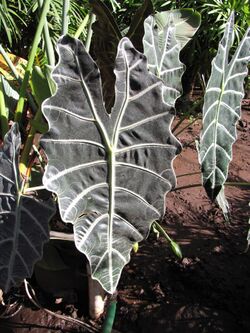
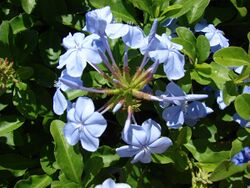
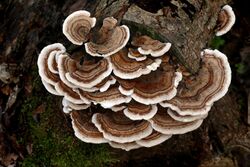
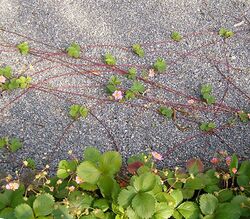
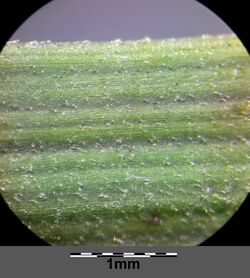
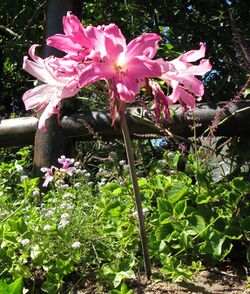
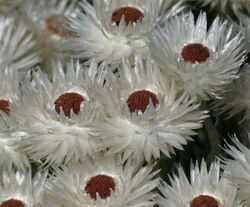
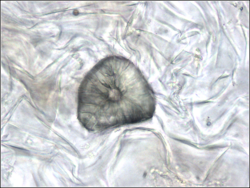
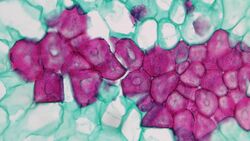
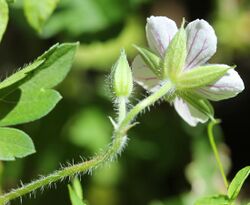
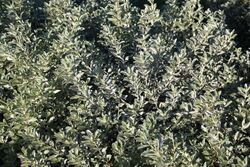
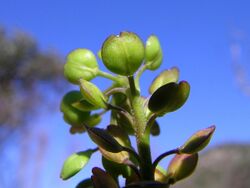
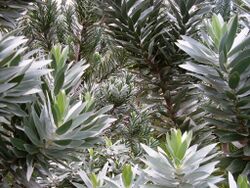
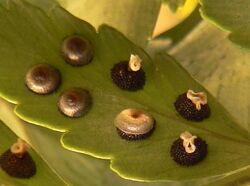
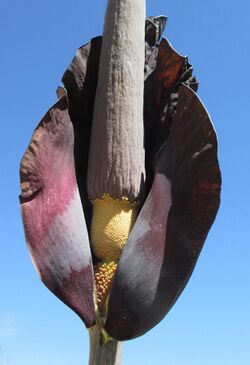
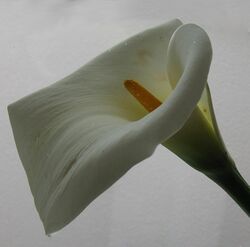
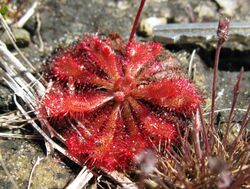
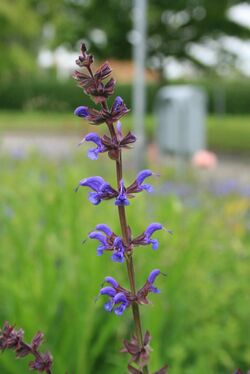
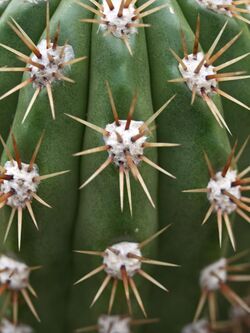
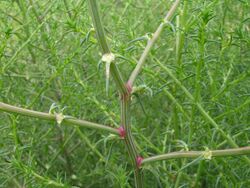
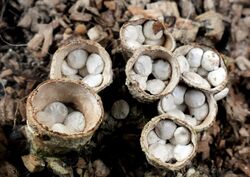
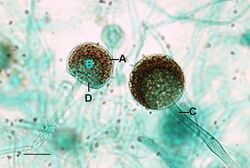
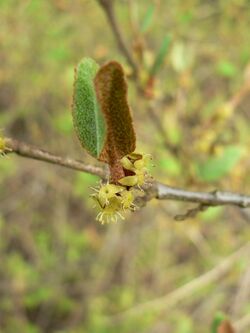
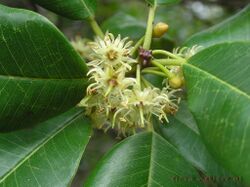
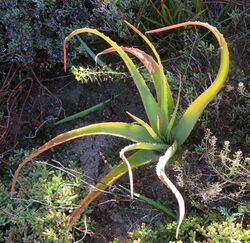
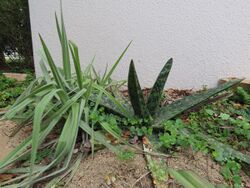
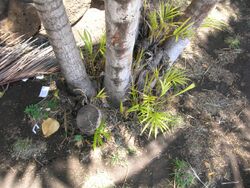
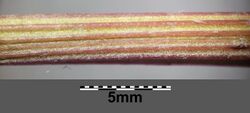
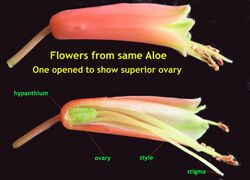
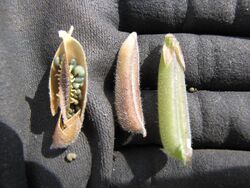
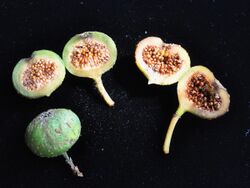
T
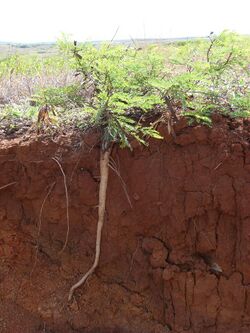
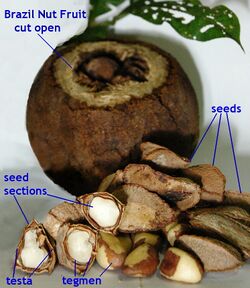
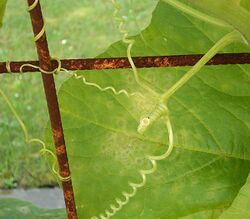
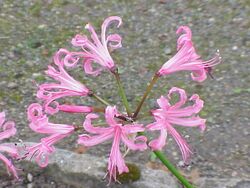
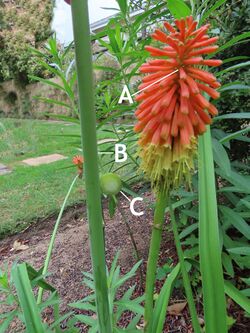
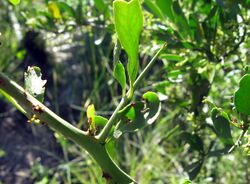
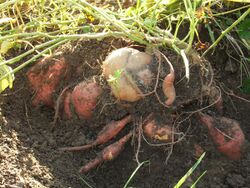
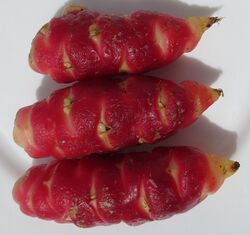
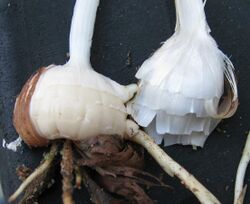
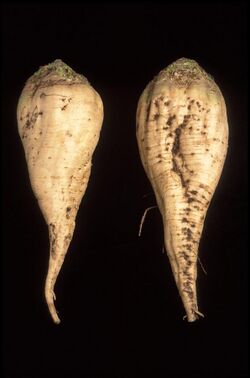
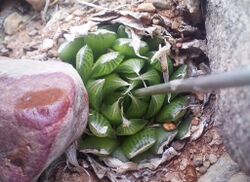
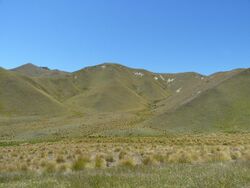
-
<dt class="glossary " id="Lua error: Internal error: The interpreter has terminated with signal "24"." style="margin-top: 0.4em;">taproot
- The primary descending root of a plant with a single dominant root axis. <dt class="glossary " id="Lua error: Internal error: The interpreter has terminated with signal "24"." style="margin-top: 0.4em;">tartareous
- Having a surface that is course, thick, rough, and crumbling. <dt class="glossary " id="Lua error: Internal error: The interpreter has terminated with signal "24"." style="margin-top: 0.4em;">taxon
Lua error: Internal error: The interpreter has terminated with signal "24".
A group or category in a system of biological classification.
<dt class="glossary " id="Lua error: Internal error: The interpreter has terminated with signal "24"." style="margin-top: 0.4em;">taxonomy
- The study of the principles and practice of classification. <dt class="glossary " id="Lua error: Internal error: The interpreter has terminated with signal "24"." style="margin-top: 0.4em;">tegmen
- The inner layer of the testa (seed coat). It develops from the inner integument of the ovule. <dt class="glossary " id="Lua error: Internal error: The interpreter has terminated with signal "24"." style="margin-top: 0.4em;">tendril
- Any slender organ modified from a stem, leaf, leaflet, or stipule and used by climbing plants to cling to an object. <dt class="glossary " id="Lua error: Internal error: The interpreter has terminated with signal "24"." style="margin-top: 0.4em;">tepal
- A segment of a perianth, either sepal or petal; usually used when all perianth segments are indistinguishable in appearance. <dt class="glossary " id="Lua error: Internal error: The interpreter has terminated with signal "24"." style="margin-top: 0.4em;">terete
Lua error: Internal error: The interpreter has terminated with signal "24".
Circular in cross-section; more or less cylindrical without grooves or ridges.
<dt class="glossary " id="Lua error: Internal error: The interpreter has terminated with signal "24"." style="margin-top: 0.4em;">terminal
- Situated at the tip or apex. <dt class="glossary " id="Lua error: Internal error: The interpreter has terminated with signal "24"." style="margin-top: 0.4em;">ternate
- In groups of three; of leaves, arranged in whorls of three; of a single leaf, having the leaflets arranged in groups of three. <dt class="glossary " id="Lua error: Internal error: The interpreter has terminated with signal "24"." style="margin-top: 0.4em;">terrestrial
- Of or on the ground; of a habitat, on land as opposed to in water (aquatic), on rocks (lithophytic), or on other plants (epiphytic). <dt class="glossary " id="Lua error: Internal error: The interpreter has terminated with signal "24"." style="margin-top: 0.4em;">tessellate
- With cracks or fissures arranged in squares so as to give a chequered appearance. Usually applied to the appearance of the bark of a tree <dt class="glossary " id="Lua error: Internal error: The interpreter has terminated with signal "24"." style="margin-top: 0.4em;">testa
- The seed coat. <dt class="glossary " id="Lua error: Internal error: The interpreter has terminated with signal "24"." style="margin-top: 0.4em;">tetrad
- A group of four; usually used to refer to four pollen grains which remain fused together through maturity (e.g. in the Epacridaceae).Lua error: Internal error: The interpreter has terminated with signal "24".Lua error: Internal error: The interpreter has terminated with signal "24". <dt class="glossary " id="Lua error: Internal error: The interpreter has terminated with signal "24"." style="margin-top: 0.4em;">tetragonal
- Square; having four corners; four-angled, e.g. the cross-sections of stems of herbaceous Lamiaceae. <dt class="glossary " id="Lua error: Internal error: The interpreter has terminated with signal "24"." style="margin-top: 0.4em;">tetramerous
- In four parts, particularly with respect to flowers; four parts in each whorl. See also trimerous and pentamerous. <dt class="glossary " id="Lua error: Internal error: The interpreter has terminated with signal "24"." style="margin-top: 0.4em;">tetraploid
- Having four complete sets of chromosomes in each sporophyte cell. <dt class="glossary " id="Lua error: Internal error: The interpreter has terminated with signal "24"." style="margin-top: 0.4em;">tetraspore
- The asexual spore of red algae. It is so named because each sporangium produces just four spores. See Rhodophyceae.Lua error: Internal error: The interpreter has terminated with signal "24".Lua error: Internal error: The interpreter has terminated with signal "24". <dt class="glossary " id="Lua error: Internal error: The interpreter has terminated with signal "24"." style="margin-top: 0.4em;">thalamus
Lua error: Internal error: The interpreter has terminated with signal "24".
1. A synonym for receptacle.- 2. The inflorescence disk of members of the Asteraceae.
- 3. A calyx, as used by Carl Linnaeus. <dt class="glossary " id="Lua error: Internal error: The interpreter has terminated with signal "24"." style="margin-top: 0.4em;">
- having a thallus-like structure; in the form of a thallus; thalloid <dt class="glossary " id="Lua error: Internal error: The interpreter has terminated with signal "24"." style="margin-top: 0.4em;">thallus
Lua error: Internal error: The interpreter has terminated with signal "24".
A vegetative structure that is not differentiated into stem and leaves, as in lichens, algae, thallose liverworts, and certain vascular plants, e.g. Lemna
<dt class="glossary " id="Lua error: Internal error: The interpreter has terminated with signal "24"." style="margin-top: 0.4em;">theca
- One of the usually two synangia in which pollen is produced in flowering plants. It consists of two fused sporangia known as pollen sacs. The wall between the pollen sacs disintegrates before dehiscence, which is usually by a common slit. <dt class="glossary " id="Lua error: Internal error: The interpreter has terminated with signal "24"." style="margin-top: 0.4em;">thorn
- A sharp, stiff point, usually a modified stem, that cannot be detached without tearing the subtending tissue; a spine. Compare prickle. <dt class="glossary " id="Lua error: Internal error: The interpreter has terminated with signal "24"." style="margin-top: 0.4em;">throat
- The opening of a corolla or perianth. <dt class="glossary " id="Lua error: Internal error: The interpreter has terminated with signal "24"." style="margin-top: 0.4em;">thyrse
- A branched inflorescence in which the main axis is indeterminate (racemose) and the lateral branches determinate (cymose). <dt class="glossary " id="Lua error: Internal error: The interpreter has terminated with signal "24"." style="margin-top: 0.4em;">tomentellous
- Minutely tomentose. <dt class="glossary " id="Lua error: Internal error: The interpreter has terminated with signal "24"." style="margin-top: 0.4em;">tomentum
Lua error: Internal error: The interpreter has terminated with signal "24".
A dense covering of short, matted hairs. Tomentose is often used as a general term for bearing an indumentum, but this is not a recommended use.
<dt class="glossary " id="Lua error: Internal error: The interpreter has terminated with signal "24"." style="margin-top: 0.4em;">toothed
- Having a more or less regularly incised margin. <dt class="glossary " id="Lua error: Internal error: The interpreter has terminated with signal "24"." style="margin-top: 0.4em;">torus
- See receptacle. <dt class="glossary " id="Lua error: Internal error: The interpreter has terminated with signal "24"." style="margin-top: 0.4em;">transmitting tissue
- See pollen transmitting tissue. <dt class="glossary " id="Lua error: Internal error: The interpreter has terminated with signal "24"." style="margin-top: 0.4em;">trapeziform
- 1. Like a trapezium (a four-sided figure with two parallel sides of unequal length).
- 2. Like a trapezoid (a four-sided figure, or quadrilateral, with neither pair of sides equal); sometimes used erroneously as a synonym for rhombic. <dt class="glossary " id="Lua error: Internal error: The interpreter has terminated with signal "24"." style="margin-top: 0.4em;">tree
- A woody plant, usually with a single distinct trunk and generally more than Lua error: Internal error: The interpreter has terminated with signal "24". tall. <dt class="glossary " id="Lua error: Internal error: The interpreter has terminated with signal "24"." style="margin-top: 0.4em;">triad
- A group of three. <dt class="glossary " id="Lua error: Internal error: The interpreter has terminated with signal "24"." style="margin-top: 0.4em;">triangular
- Planar and with 3 sides. <dt class="glossary " id="Lua error: Internal error: The interpreter has terminated with signal "24"." style="margin-top: 0.4em;">tribe
- A taxonomic grouping that ranks between genus and family. <dt class="glossary " id="Lua error: Internal error: The interpreter has terminated with signal "24"." style="margin-top: 0.4em;">trichome
- In non-filamentous plants, any hair-like outgrowth from the epidermis, e.g. a hair or bristle; sometimes restricted to unbranched epidermal outgrowths. <dt class="glossary " id="Lua error: Internal error: The interpreter has terminated with signal "24"." style="margin-top: 0.4em;">trichotomous
- 3-forked or branched into three. Compare dichotomous. <dt class="glossary " id="Lua error: Internal error: The interpreter has terminated with signal "24"." style="margin-top: 0.4em;">trifid.
- Split into three parts. See also bifid. <dt class="glossary " id="Lua error: Internal error: The interpreter has terminated with signal "24"." style="margin-top: 0.4em;">trifoliate
- A compound leaf of three leaflets; for example, a clover leaf. <dt class="glossary " id="Lua error: Internal error: The interpreter has terminated with signal "24"." style="margin-top: 0.4em;">trifoliolate
- See trifoliate. <dt class="glossary " id="Lua error: Internal error: The interpreter has terminated with signal "24"." style="margin-top: 0.4em;">trigonous
- Triangular in cross-section and obtusely angled. Compare triquetrous. <dt class="glossary " id="Lua error: Internal error: The interpreter has terminated with signal "24"." style="margin-top: 0.4em;">trimerous
- In three parts, particularly with respect to flowers; having three parts in each whorl. See also tetramerous and pentamerous. <dt class="glossary " id="Lua error: Internal error: The interpreter has terminated with signal "24"." style="margin-top: 0.4em;">trinerved
- Having three nerves or veins. <dt class="glossary " id="Lua error: Internal error: The interpreter has terminated with signal "24"." style="margin-top: 0.4em;">triplinerved
- (of leaves) Having three main nerves with the lateral nerves arising from the midnerve above the base of the leaf. <dt class="glossary " id="Lua error: Internal error: The interpreter has terminated with signal "24"." style="margin-top: 0.4em;">triporate
- (of pollen) Having three pores. <dt class="glossary " id="Lua error: Internal error: The interpreter has terminated with signal "24"." style="margin-top: 0.4em;">triquetrous
- More or less triangular in cross-section, but acutely angled (with 3 distinct longitudinal ridges). Compare trigonous. <dt class="glossary " id="Lua error: Internal error: The interpreter has terminated with signal "24"." style="margin-top: 0.4em;">trivalve
- Divided into three valves. Also trivalvar. See also bivalve. <dt class="glossary " id="Lua error: Internal error: The interpreter has terminated with signal "24"." style="margin-top: 0.4em;">trivial name
- The second word in the two-part scientific name of an organism. Compare specific epithet. <dt class="glossary " id="Lua error: Internal error: The interpreter has terminated with signal "24"." style="margin-top: 0.4em;">trophophyll
- A vegetative, nutrient-producing leaf or microphyll whose primary function is photosynthesis. It is not specialized or modified for some other function. Compare sporophyll. <dt class="glossary " id="Lua error: Internal error: The interpreter has terminated with signal "24"." style="margin-top: 0.4em;">trullate
- Ovate but angled, as with a bricklayer's trowel; inversely kite-shaped. Compare rhombic. <dt class="glossary " id="Lua error: Internal error: The interpreter has terminated with signal "24"." style="margin-top: 0.4em;">truncate
- Cut off squarely; having an abruptly transverse end. <dt class="glossary " id="Lua error: Internal error: The interpreter has terminated with signal "24"." style="margin-top: 0.4em;">trunk
- The upright, large and typically woody main stem of a tree. <dt class="glossary " id="Lua error: Internal error: The interpreter has terminated with signal "24"." style="margin-top: 0.4em;">truss
- A compact cluster of flowers or fruits arising from one center; evident in many rhododendrons. <dt class="glossary " id="Lua error: Internal error: The interpreter has terminated with signal "24"." style="margin-top: 0.4em;">tuber
- Any of many types of specialized vegetative underground storage organs. They accumulate food, water, or in protection from death by fire, drought, or other hard times. Tubers generally are well differentiated from other plant organs; for example, informally a carrot is not generally regarded as a tuber, but simply a swollen root. In this they differ from the tuber of a sweet potato, which has no special root-like function. Similarly, corms are not generally regarded as tubers, even though they are underground storage stems. Tubers store food for the plant, and also have important roles in vegetative reproduction. They generally are of two main types: stem tubers form by the swelling of an underground stem growing from a root, or from structures such as underground stolons. Stem tubers generally produce propagative buds at their stem nodes, forming a seasonal perennating organ, e.g. a potato. The main other class is the root tuber, also called tuberoid. They differ from stem tubers in features such as that, like any normal root, they do not form nodes. <dt class="glossary " id="Lua error: Internal error: The interpreter has terminated with signal "24"." style="margin-top: 0.4em;">tubercle
- A small wart-like outgrowth or protuberance of tissue. <dt class="glossary " id="Lua error: Internal error: The interpreter has terminated with signal "24"." style="margin-top: 0.4em;">tuberculate
- Covered in tubercles. See warty.[31] <dt class="glossary " id="Lua error: Internal error: The interpreter has terminated with signal "24"." style="margin-top: 0.4em;">tuberoid
- An alternative name for underground storage organ formed by the swelling of a root; occurs in many orchids. <dt class="glossary " id="Lua error: Internal error: The interpreter has terminated with signal "24"." style="margin-top: 0.4em;">tuberous
- Resembling a tuber or producing tubers. <dt class="glossary " id="Lua error: Internal error: The interpreter has terminated with signal "24"." style="margin-top: 0.4em;">tubular
- Having the form of a tube or cylinder. <dt class="glossary " id="Lua error: Internal error: The interpreter has terminated with signal "24"." style="margin-top: 0.4em;">tufted
- Densely fasciculate at the tip. <dt class="glossary " id="Lua error: Internal error: The interpreter has terminated with signal "24"." style="margin-top: 0.4em;">tunic
- The outer covering of some bulbs and corms. <dt class="glossary " id="Lua error: Internal error: The interpreter has terminated with signal "24"." style="margin-top: 0.4em;">tunicate
- (of bulbs) Consisting of concentric coats. <dt class="glossary " id="Lua error: Internal error: The interpreter has terminated with signal "24"." style="margin-top: 0.4em;">turbinate
- Shaped like a spinning top or beetroot. <dt class="glossary " id="Lua error: Internal error: The interpreter has terminated with signal "24"." style="margin-top: 0.4em;">turgid
- Swollen with liquid; bloated; firm. Compare flaccid. <dt class="glossary " id="Lua error: Internal error: The interpreter has terminated with signal "24"." style="margin-top: 0.4em;">tussock
- A dense tuft of vegetation, usually well separated from neighbouring tussocks, for example in some grasses. Compare sward. <dt class="glossary " id="Lua error: Internal error: The interpreter has terminated with signal "24"." style="margin-top: 0.4em;">two-ranked
- Having leaves arranged in two rows in the same plane, on opposite sides of the branch. See distichous. <dt class="glossary " id="Lua error: Internal error: The interpreter has terminated with signal "24"." style="margin-top: 0.4em;">type
- An item (usually an herbarium specimen) to which the name of a taxon is permanently attached, i.e. a designated representative of a plant name. Important in determining the priority of names available for a particular taxon. <dt class="glossary " id="Lua error: Internal error: The interpreter has terminated with signal "24"." style="margin-top: 0.4em;">type genus
- In nomenclature, a single genus on which a taxonomic family is based.
U
- A racemose inflorescence in which all the individual flower stalks arise in a cluster at the top of the peduncle and are of about equal length; in a simple umbel, each stalk is unbranched and bears only one flower. A cymose umbel looks similar to an ordinary umbel but its flowers open centrifugally. <dt class="glossary " id="Lua error: Internal error: The interpreter has terminated with signal "24"." style="margin-top: 0.4em;">umbo
- A rounded elevation, such as in the middle of the top of an umbrella or mushroom; a central boss or protuberance, such as on the scale of a cone. <dt class="glossary " id="Lua error: Internal error: The interpreter has terminated with signal "24"." style="margin-top: 0.4em;">umbonate
- Having an umbo, with a conical or blunt projection arising from a flatter surface, as on the top of a mushroom or in the scale of a pine cone. <dt class="glossary " id="Lua error: Internal error: The interpreter has terminated with signal "24"." style="margin-top: 0.4em;">unciform
- Hook-shaped. <dt class="glossary " id="Lua error: Internal error: The interpreter has terminated with signal "24"." style="margin-top: 0.4em;">uncinate
- Having a hook at the apex. <dt class="glossary " id="Lua error: Internal error: The interpreter has terminated with signal "24"." style="margin-top: 0.4em;">undershrub
- A low shrub, often with flowering branches that die off in winter. Compare subshrub. <dt class="glossary " id="Lua error: Internal error: The interpreter has terminated with signal "24"." style="margin-top: 0.4em;">understory
- Plant life growing beneath the forest canopy. <dt class="glossary " id="Lua error: Internal error: The interpreter has terminated with signal "24"." style="margin-top: 0.4em;">undulate
- Wavy and not flat. Compare sinuate. <dt class="glossary " id="Lua error: Internal error: The interpreter has terminated with signal "24"." style="margin-top: 0.4em;">uniflor
- Having a single flower (uniflory). Compare pauciflor (few) and pluriflor (many). <dt class="glossary " id="Lua error: Internal error: The interpreter has terminated with signal "24"." style="margin-top: 0.4em;">unilocular
- Having one loculus or chamber, e.g. the ovary in the families Proteaceae and Fabaceae. <dt class="glossary " id="Lua error: Internal error: The interpreter has terminated with signal "24"." style="margin-top: 0.4em;">uniserial
- Arranged in a single row or series. Unbranched. Uniseriate. <dt class="glossary " id="Lua error: Internal error: The interpreter has terminated with signal "24"." style="margin-top: 0.4em;">uniseriate
- Arranged in a single row or series. Unbranched. Uniserial. <dt class="glossary " id="Lua error: Internal error: The interpreter has terminated with signal "24"." style="margin-top: 0.4em;">unisexual
- Of one sex; bearing only male or only female reproductive organs, dioecious, dioicous. See Sexual reproduction in plants. <dt class="glossary " id="Lua error: Internal error: The interpreter has terminated with signal "24"." style="margin-top: 0.4em;">unitegmic
- (of an ovule) Covered by a single integument. See also bitegmic, having two integuments. <dt class="glossary " id="Lua error: Internal error: The interpreter has terminated with signal "24"." style="margin-top: 0.4em;">urceolate
- Shaped like an urn or pitcher, with a swollen middle and narrowing top. Examples include the pitchers of many species of the pitcher plant genera Sarracenia and Nepenthes. <dt class="glossary " id="Lua error: Internal error: The interpreter has terminated with signal "24"." style="margin-top: 0.4em;">usu.
- An abbreviation of usually. Compare s.t. and oft.. <dt class="glossary " id="Lua error: Internal error: The interpreter has terminated with signal "24"." style="margin-top: 0.4em;">utricle
- 1. A small bladder; a membranous bladder-like sac from the ovary wall, thin pericarp, becomes more or less bladdery or inflated at maturity enclosing an ovary or fruit.
- 2. In sedges, a fruit in which the fruit is loosely encloses from a modified tubular bract, see perigynium.
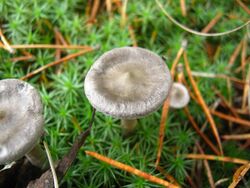
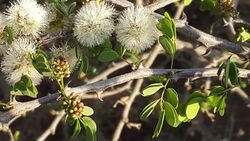
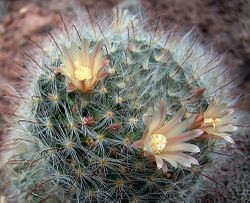
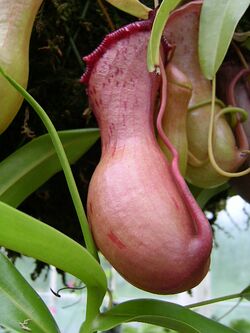
V
- A resin canal coinciding with a longitudinal groove in the seeds of Asteraceae. A longitudinal cavity in the cortex of the stems of Equisetum, coinciding with a groove in the stem surface. <dt class="glossary " id="Lua error: Internal error: The interpreter has terminated with signal "24"." style="margin-top: 0.4em;">valvate
- (of sepals and petals in bud) Meeting edge-to-edge but not overlapping. <dt class="glossary " id="Lua error: Internal error: The interpreter has terminated with signal "24"." style="margin-top: 0.4em;">valve
- A portion of an organ that fragments or splits open, e.g. the teeth-like portions of a pericarp in a split (dehisced) capsule or pod when ripe. <dt class="glossary " id="Lua error: Internal error: The interpreter has terminated with signal "24"." style="margin-top: 0.4em;">var.
- An abbreviation of varietas. <dt class="glossary " id="Lua error: Internal error: The interpreter has terminated with signal "24"." style="margin-top: 0.4em;">variant
- A plant or group of plants showing some measure of difference from the characteristics associated with a particular taxon. <dt class="glossary " id="Lua error: Internal error: The interpreter has terminated with signal "24"." style="margin-top: 0.4em;">variegated
- Irregularly marked with blotches or patches of another color. <dt class="glossary " id="Lua error: Internal error: The interpreter has terminated with signal "24"." style="margin-top: 0.4em;">varietas
Lua error: Internal error: The interpreter has terminated with signal "24".
A taxonomic rank below that of species and between the ranks of subspecies and form.
<dt class="glossary " id="Lua error: Internal error: The interpreter has terminated with signal "24"." style="margin-top: 0.4em;">vascular
- Referring to the conducting tissues (xylem and phloem) of vascular plants. <dt class="glossary " id="Lua error: Internal error: The interpreter has terminated with signal "24"." style="margin-top: 0.4em;">vascular bundle
- A bundle of vascular tissue in the primary stems of vascular plants, consisting of specialized conducting cells for the transport of water (xylem) and assimilate (phloem). <dt class="glossary " id="Lua error: Internal error: The interpreter has terminated with signal "24"." style="margin-top: 0.4em;">vasculum
- A container used by botanists for collecting field specimens. <dt class="glossary " id="Lua error: Internal error: The interpreter has terminated with signal "24"." style="margin-top: 0.4em;">vein
Lua error: Internal error: The interpreter has terminated with signal "24".
A strand of vascular tissue, e.g. in the leaves of vascular plants.
<dt class="glossary " id="Lua error: Internal error: The interpreter has terminated with signal "24"." style="margin-top: 0.4em;">veinlet
- A small vein; the ultimate (visible) division of a vein. <dt class="glossary " id="Lua error: Internal error: The interpreter has terminated with signal "24"." style="margin-top: 0.4em;">velamen
- A spongy tissue covering the aerial roots of orchids and some other epiphytes. <dt class="glossary " id="Lua error: Internal error: The interpreter has terminated with signal "24"." style="margin-top: 0.4em;">velutinous
- See velvety. <dt class="glossary " id="Lua error: Internal error: The interpreter has terminated with signal "24"." style="margin-top: 0.4em;">velvety
- Densely covered with fine, short, soft, erect hairs. <dt class="glossary " id="Lua error: Internal error: The interpreter has terminated with signal "24"." style="margin-top: 0.4em;">venation
- The arrangement of veins in a leaf. <dt class="glossary " id="Lua error: Internal error: The interpreter has terminated with signal "24"." style="margin-top: 0.4em;">ventral
- From Latin venter, meaning "belly". The opposite of dorsal. Partly because the term originally referred to animals rather than plants, usage in botany is arbitrary according to context and source. In general "ventral" refers to "the belly or lower part", but in botanical usage such concepts are not always clearly defined and may be contradictory. For example:
- facing toward the axis (adaxial) in referring to a lateral organ of an erect plant
- facing toward the substrate in any part of an erect plant, for example the lower surface of a more or less horizontal leaf (abaxial)
- facing toward the substrate in a prostrate or climbing plant.
<dt class="glossary " id="Lua error: Internal error: The interpreter has terminated with signal "24"." style="margin-top: 0.4em;">vernation
- The arrangement of unexpanded leaves in a bud; the order in which leaves unfold from a bud. <dt class="glossary " id="Lua error: Internal error: The interpreter has terminated with signal "24"." style="margin-top: 0.4em;">vernicose
- Having a shiny or polished surface as if covered in varnish and a slick or smooth texture.Lua error: Internal error: The interpreter has terminated with signal "24".Lua error: Internal error: The interpreter has terminated with signal "24". <dt class="glossary " id="Lua error: Internal error: The interpreter has terminated with signal "24"." style="margin-top: 0.4em;">vernonioid
- In the family Asteraceae, style with sweeping hairs borne on abaxial surfaces of style branches. <dt class="glossary " id="Lua error: Internal error: The interpreter has terminated with signal "24"." style="margin-top: 0.4em;">verruciform
- Wart-like in form. <dt class="glossary " id="Lua error: Internal error: The interpreter has terminated with signal "24"." style="margin-top: 0.4em;">verrucose
- Having warts. <dt class="glossary " id="Lua error: Internal error: The interpreter has terminated with signal "24"." style="margin-top: 0.4em;">verruculose
- Minutely verrucose; minutely warty. <dt class="glossary " id="Lua error: Internal error: The interpreter has terminated with signal "24"." style="margin-top: 0.4em;">versatile
- (of anthers) Swinging freely about the point of attachment to the filament. <dt class="glossary " id="Lua error: Internal error: The interpreter has terminated with signal "24"." style="margin-top: 0.4em;">verticillate
- Arranged in one or more whorls, i.e. several similar parts arranged at the same point of the axis, e.g. leaf arrangement. Compare pseudoverticillate (appearing whorled or verticillate but not actually so). <dt class="glossary " id="Lua error: Internal error: The interpreter has terminated with signal "24"." style="margin-top: 0.4em;">verticillaster
- A type of pseudoverticillate inflorescence, typical of the Lamiaceae, in which pseudo-whorls are formed from pairs of opposite cymes. <dt class="glossary " id="Lua error: Internal error: The interpreter has terminated with signal "24"." style="margin-top: 0.4em;">vesicular
- (of hairs) Bladder-like; vesciculous, bearing such hairs. <dt class="glossary " id="Lua error: Internal error: The interpreter has terminated with signal "24"." style="margin-top: 0.4em;">vessel
- A capillary tube formed from a series of open-ended cells in the water-conducting tissue of a plant. <dt class="glossary " id="Lua error: Internal error: The interpreter has terminated with signal "24"." style="margin-top: 0.4em;">vestigial
- Reduced in form and function from the normal or ancestral condition. <dt class="glossary " id="Lua error: Internal error: The interpreter has terminated with signal "24"." style="margin-top: 0.4em;">villosulous
- Minutely villous. <dt class="glossary " id="Lua error: Internal error: The interpreter has terminated with signal "24"." style="margin-top: 0.4em;">villous
- Abounding in or covered with long, soft, straight hairs; shaggy with soft hairs. <dt class="glossary " id="Lua error: Internal error: The interpreter has terminated with signal "24"." style="margin-top: 0.4em;">vine
- 1. Scandent plants climbing by means of trailing or twining stems or runners.
- 2. Such a stem or runner.Lua error: Internal error: The interpreter has terminated with signal "24".Lua error: Internal error: The interpreter has terminated with signal "24".Lua error: Internal error: The interpreter has terminated with signal "24".Lua error: Internal error: The interpreter has terminated with signal "24".
- 3. A member of the genus Vitis. <dt class="glossary " id="Lua error: Internal error: The interpreter has terminated with signal "24"." style="margin-top: 0.4em;">virgate
Lua error: Internal error: The interpreter has terminated with signal "24".
Wand-shaped, twiggy, especially referring to erect, straight stems. In mycology, referring to a pileus with radiating ribs or lines.
<dt class="glossary " id="Lua error: Internal error: The interpreter has terminated with signal "24"." style="margin-top: 0.4em;">Viridiplantae
- A clade of autotrophic organisms that includes the green algae, Charophyta and land plants, all of which have cellulose in their cell walls, chloroplasts derived from primary endosymbiosis with cyanobacteria that contain chlorophylls a and b and lack phycobilins. <dt class="glossary " id="Lua error: Internal error: The interpreter has terminated with signal "24"." style="margin-top: 0.4em;">viscid
- Sticky; coated with a thick, syrupy secretion. <dt class="glossary " id="Lua error: Internal error: The interpreter has terminated with signal "24"." style="margin-top: 0.4em;">vitta
- An oil tube in the fruit of some plants. <dt class="glossary " id="Lua error: Internal error: The interpreter has terminated with signal "24"." style="margin-top: 0.4em;">viviparous
- 1. Referring to seeds or fruits which germinate before being shed from the parent plant.
- 2. The development of plantlets on non-floral organs, e.g. leaves.
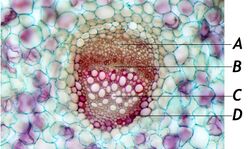
B: Cambium
C: Xylem
D: Fibrous sheath of vascular bundle
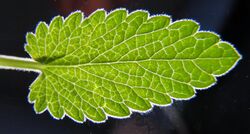
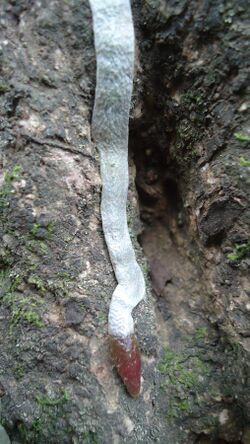
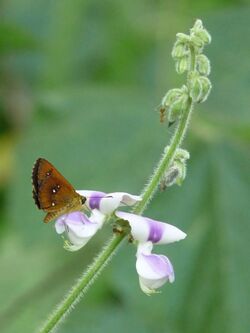
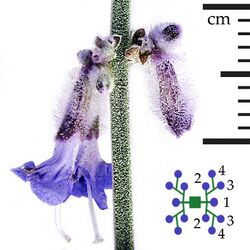
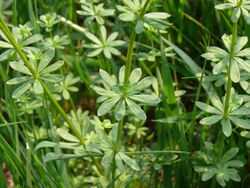
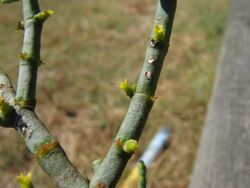
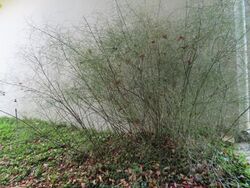
W
- A surface covered with small round protuberances, especially in fruit, leaves, twigs and bark. See tuberculate. <dt class="glossary " id="Lua error: Internal error: The interpreter has terminated with signal "24"." style="margin-top: 0.4em;">watershoot
- An erect, strong-growing, or epicormic shoot developing from near the base of a shrub or tree, but distinct from a sucker. <dt class="glossary " id="Lua error: Internal error: The interpreter has terminated with signal "24"." style="margin-top: 0.4em;">weed
- 1. Any plant growing where it is not wanted; commonly associated with disrupted habitats. See also ruderal.
- 2. An unwanted plant which grows among agricultural crops.
- 3. A naturalised, exotic, or ecologically "out-of-balance" indigenous species outside of the agricultural or garden context, which, as a result of invasion, adversely affects the survival or regeneration of indigenous species in natural or partly natural vegetation communities.[32] <dt class="glossary " id="Lua error: Internal error: The interpreter has terminated with signal "24"." style="margin-top: 0.4em;">wild
- Originating from a known wild or purely natural habitat (wilderness). <dt class="glossary " id="Lua error: Internal error: The interpreter has terminated with signal "24"." style="margin-top: 0.4em;">whorl
- A ring of organs borne at the same level on an axis (e.g. leaves, bracts, or floral parts). <dt class="glossary " id="Lua error: Internal error: The interpreter has terminated with signal "24"." style="margin-top: 0.4em;">wing
- 1. A membranous expansion of a fruit or seed which aids in dispersal, for instance on pine seeds.
- 2. A thin flange of tissue extending beyond the normal outline of a structure, e.g. on the column of some orchids, on stems, on petioles.
- 3. One of the two lateral petals of a flower of subfamily Faboideae of family Fabaceae, located between the adaxial standard (banner) petal and the two abaxial keel petals. <dt class="glossary " id="Lua error: Internal error: The interpreter has terminated with signal "24"." style="margin-top: 0.4em;">woody
- hard and lignified; not herbaceous <dt class="glossary " id="Lua error: Internal error: The interpreter has terminated with signal "24"." style="margin-top: 0.4em;">wooly <dt class="glossary " id="Lua error: Internal error: The interpreter has terminated with signal "24"." style="margin-top: -0.2em;">woolly
- Very densely covered with long, more or less matted or intertwined hairs, resembling a sheep's wool.
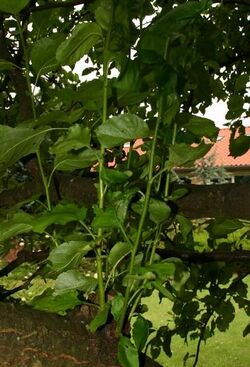
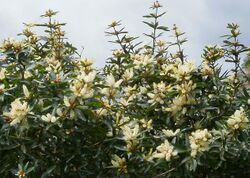
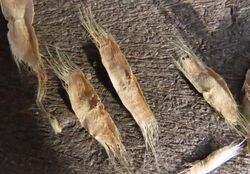
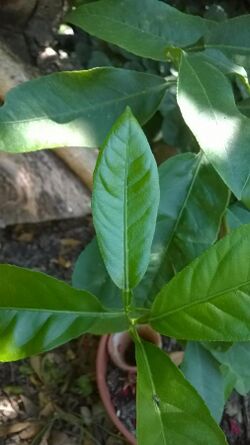
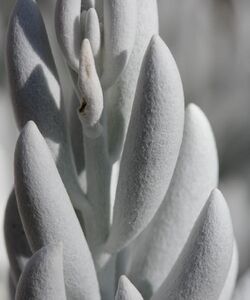
X
-
<dt class="glossary " id="Lua error: Internal error: The interpreter has terminated with signal "24"." style="margin-top: 0.4em;">xeromorph
- A plant with structural features (e.g. hard or succulent leaves) or functional adaptations that prevent water loss by evaporation; usually associated with arid habitats, but not necessarily drought-tolerant. Compare xerophyte. <dt class="glossary " id="Lua error: Internal error: The interpreter has terminated with signal "24"." style="margin-top: 0.4em;">xerophyte
- A plant generally living in a dry habitat, typically showing xeromorphic or succulent adaptation; a plant able to tolerate long periods of drought. Compare xeromorph. <dt class="glossary " id="Lua error: Internal error: The interpreter has terminated with signal "24"." style="margin-top: 0.4em;">xylem
- A specialized water-conducting tissue in vascular plants.
Z
- Having light and dark circular bands or rings, typically on leaves or flowers. <dt class="glossary " id="Lua error: Internal error: The interpreter has terminated with signal "24"." style="margin-top: 0.4em;">zygomorphic
- Bilaterally symmetrical; symmetrical about one vertical plane only; applies to flowers in which the perianth segments within each whorl vary in size and shape. Contrast actinomorphic and irregular. <dt class="glossary " id="Lua error: Internal error: The interpreter has terminated with signal "24"." style="margin-top: 0.4em;">zygote
- A fertilized cell, the product of fusion of two gametes.
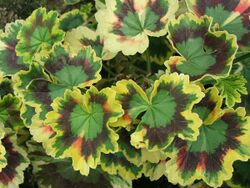
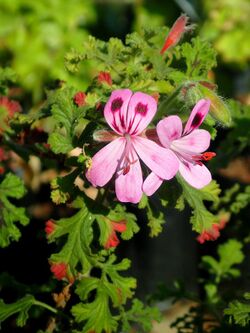
See also
- Glossary of biology
- Glossary of plant morphology
- Glossary of leaf morphology
- Glossary of lichen terms
- Glossary of mycology
- Glossary of scientific naming
- Plant morphology
- Floral formula – abbreviations used in describing flower parts
References
- ↑ New Oxford Dictionary v1 2007, p. 2.
- ↑ 2.0 2.1 2.2 Harris & Harris 2001, p. 3.
- ↑ New Oxford Dictionary v1 2007, p. 7.
- ↑ New Oxford Dictionary v1 2007, p. 8.
- ↑ Shreve & Wiggins 1964, p. 738.
- ↑ Shreve & Wiggins 1964, p. 355.
- ↑ Shreve & Wiggins 1964, p. 351.
- ↑ New Oxford Dictionary v1 2007, p. 16.
- ↑ Turland et al. 2018, Article 18.
- ↑ IPNI 2022.
- ↑ 11.0 11.1 Harris & Harris 2001, p. 4.
- ↑ Harris & Harris 2001, pp. 4–5.
- ↑ 13.0 13.1 13.2 13.3 13.4 13.5 13.6 13.7 13.8 Harris & Harris 2001, p. 5.
- ↑ Sims 1803, [p. 93].
- ↑ Harris & Harris 2001, p. 6.
- ↑ Cappers & Neef 2012, p. 95.
- ↑ Pell & Angell 2016, p. 15.
- ↑ Pell & Angell 2016, p. 16.
- ↑ Pell & Angell 2016, p. 17.
- ↑ Pell & Angell 2016, p. 20.
- ↑ Pell & Angell 2016, p. 24.
- ↑ Pell & Angell 2016, p. 27.
- ↑ Pell & Angell 2016, p. 35.
- ↑ Pell & Angell 2016, p. 39.
- ↑ 25.0 25.1 Pell & Angell 2016, p. 41.
- ↑ Pell & Angell 2016, p. 46.
- ↑ Pell & Angell 2016, p. 47.
- ↑ Copied definition from Wiktionary entry for faculative biology adjective. See that page's history for attribution.
- ↑ Copied definition from Wiktionary entry for fimbriate biology adjective. See that page's history for attribution.
- ↑ "Glossary: P". Native Plant Trust. https://gobotany.nativeplanttrust.org/glossary/p/.
- ↑ "tuberculate". http://www.botanydictionary.org/tuberculate.html.
- ↑ Carr, G.W., in Foreman & Walsh, 1993.
Lua error: Internal error: The interpreter has terminated with signal "24".
Bibliography
- (in en) A Dictionary of Plant Sciences. Oxford University Press. 2012. ISBN 978-0-19-960057-1. https://books.google.com/books?id=wzZGQOmcjqAC.
- Beach, Chandler B., ed (1914a). "Tetrad". The New Student's Reference Work. Chicago: F. E. Compton and Co.
- Beach, Chandler B., ed (1914b). "Tetraspore". The New Student's Reference Work. Chicago: F. E. Compton and Co.
- (in en) The Kew Plant Glossary, an Illustrated Dictionary of Plant Terms. Richmond, London: Kew Publishing. 2010. ISBN 978-1-84246-422-9.
- "The splash-cup dispersal mechanism in plants". Canadian Journal of Botany (Ottawa, Ontario: Canadian Science Publishing) 29 (3): 224–234. May 1951. doi:10.1139/b51-022. https://cdnsciencepub.com/doi/abs/10.1139/b51-022.
- Cappers, René T.J.; Neef, Reinder (2012) (in en). Handbook of Plant Palaeoecology. Barkuis Publishing. ISBN 9789492444264. https://books.google.com/books?id=OJhLDwAAQBAJ.
- Flora of the Sydney Region (4th ed.). Chatswood, NSW: Reed. 1994. ISBN 0730104001. OCLC 32821788.
- (in en) A General History of Dichlamydeous Plants...Arranged According to the Natural System. 1. London. 1831. https://www.biodiversitylibrary.org/item/55546. Retrieved 15 December 2022.
- Template:Cite book
- Template:Cite book
- Template:Cite journal
- Template:Cite book
- Template:Cite book
- Template:Cite web
- Template:Cite IPNI
- Template:Cite book
- Template:Cite book
- Template:Cite journal
- Template:Cite book
- Template:Cite journal
- Template:Cite web
- Template:Cite book
- Template:Cite book
- Template:Cite web
- Template:Cite book
- Template:Cite EB1911
- Template:Cite book
- Template:Cite book
- Template:Cite book
- Template:Cite book
- Template:Cite book
- Template:Cite book
External links
- Wiktionary
- Glossary at: APweb
- A glossary of botanical terms in English At: Flora, etc.
- Garden Web
- eFloras
- Categorical Glossary for the Flora of North America Project
Royal Botanical Gardens at Kew
Australia and New Zealand
- University of Sydney: Eflora – Glossary
- Florabase (Western Australia)
- Flora of Australia Online Glossary
- Flora of Australia Abbreviations
- Flora of S Australia
- Botany Word of the Day. Illustrated with New Zealand natives
- New Zealand Plant Conservation Network
Africa
Template:Botany Template:Glossaries of science and engineering
